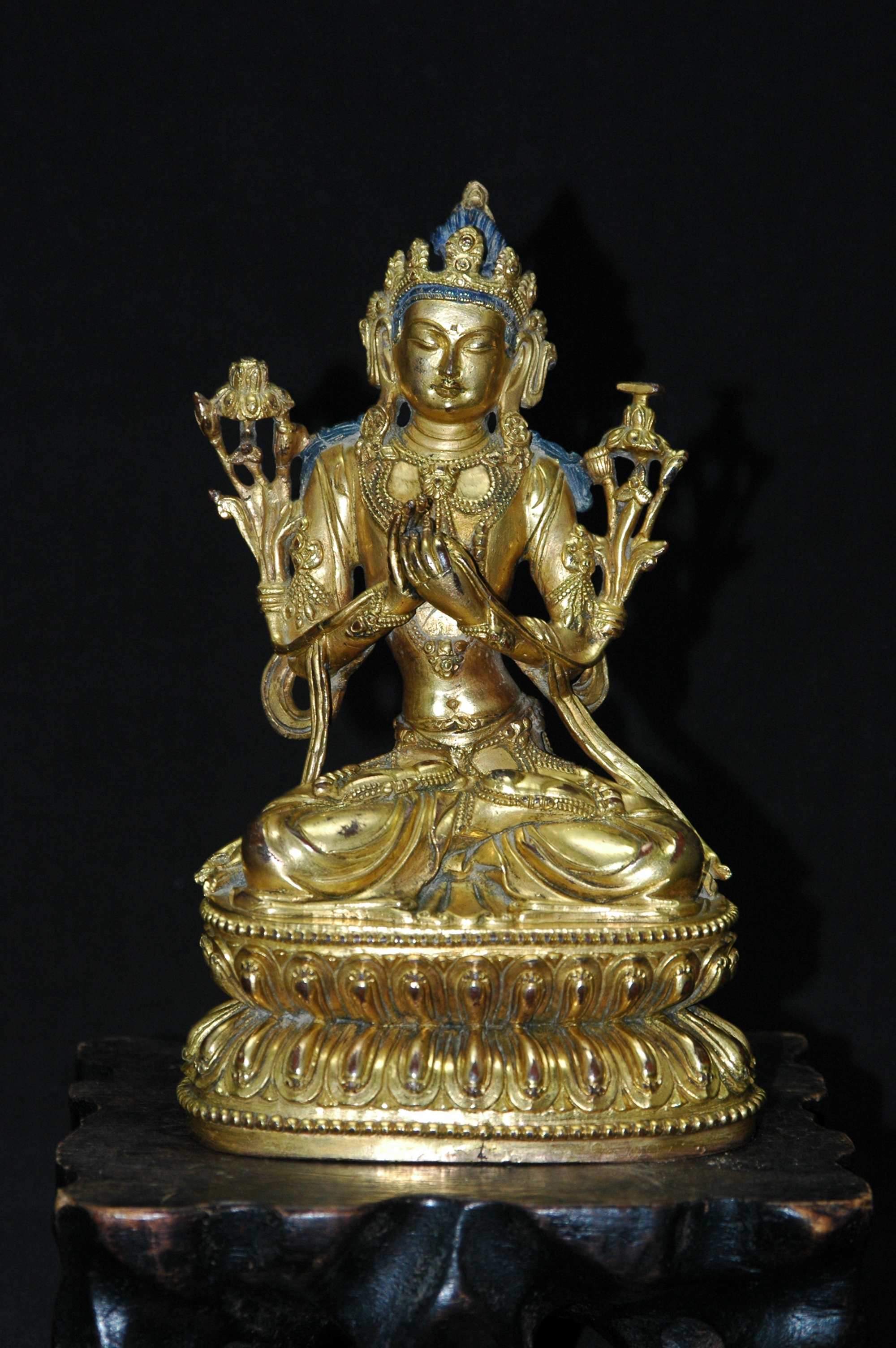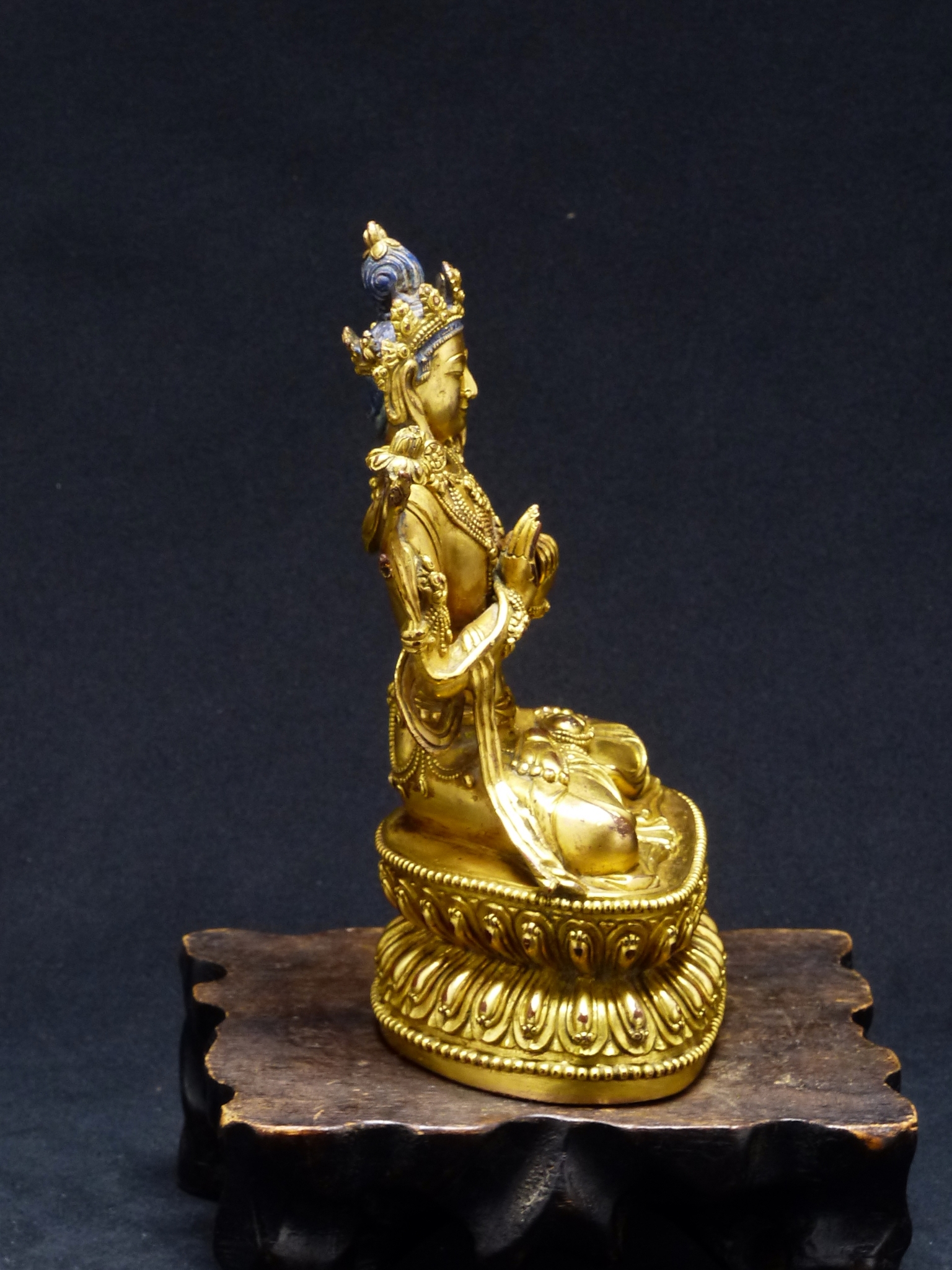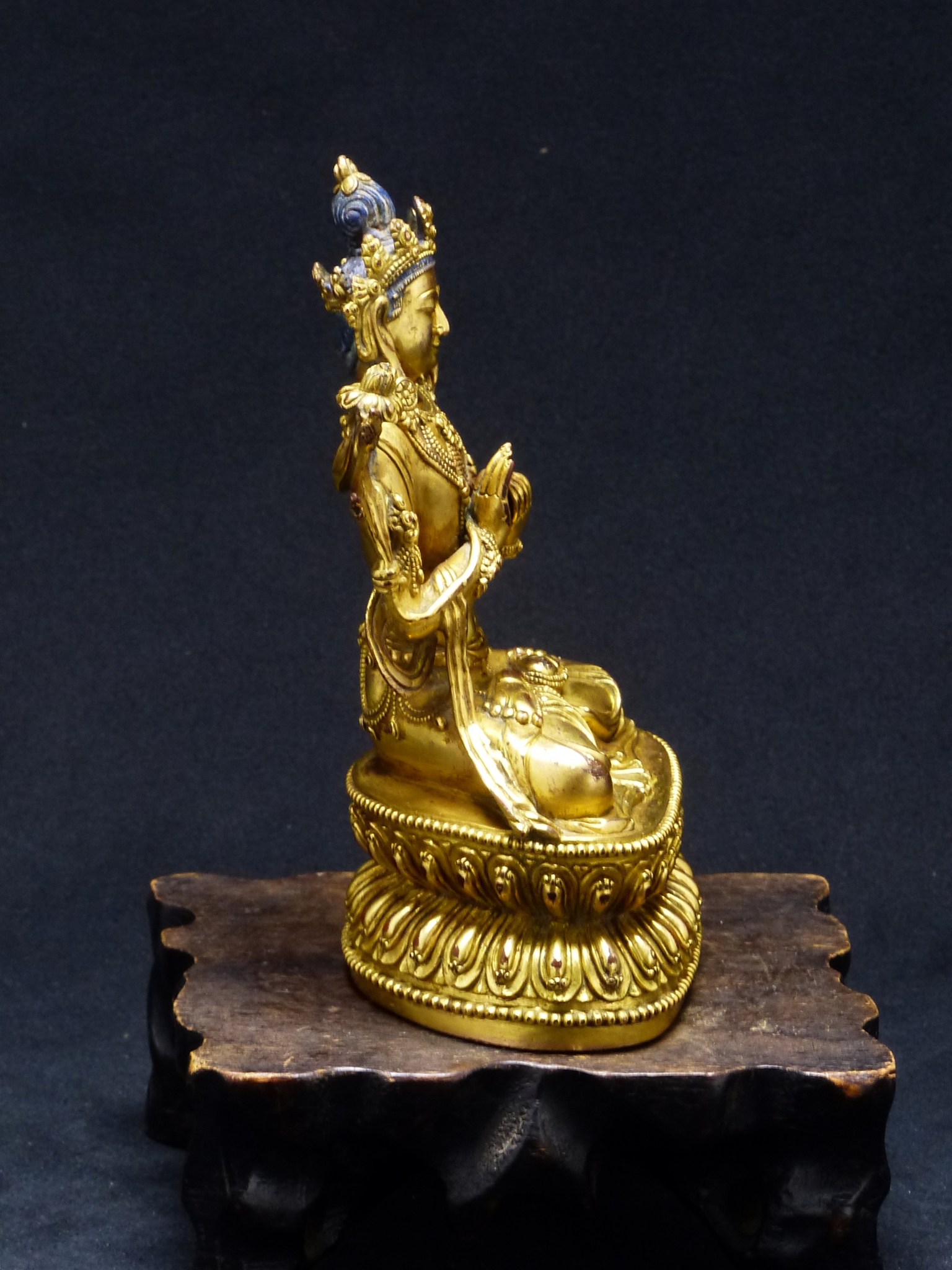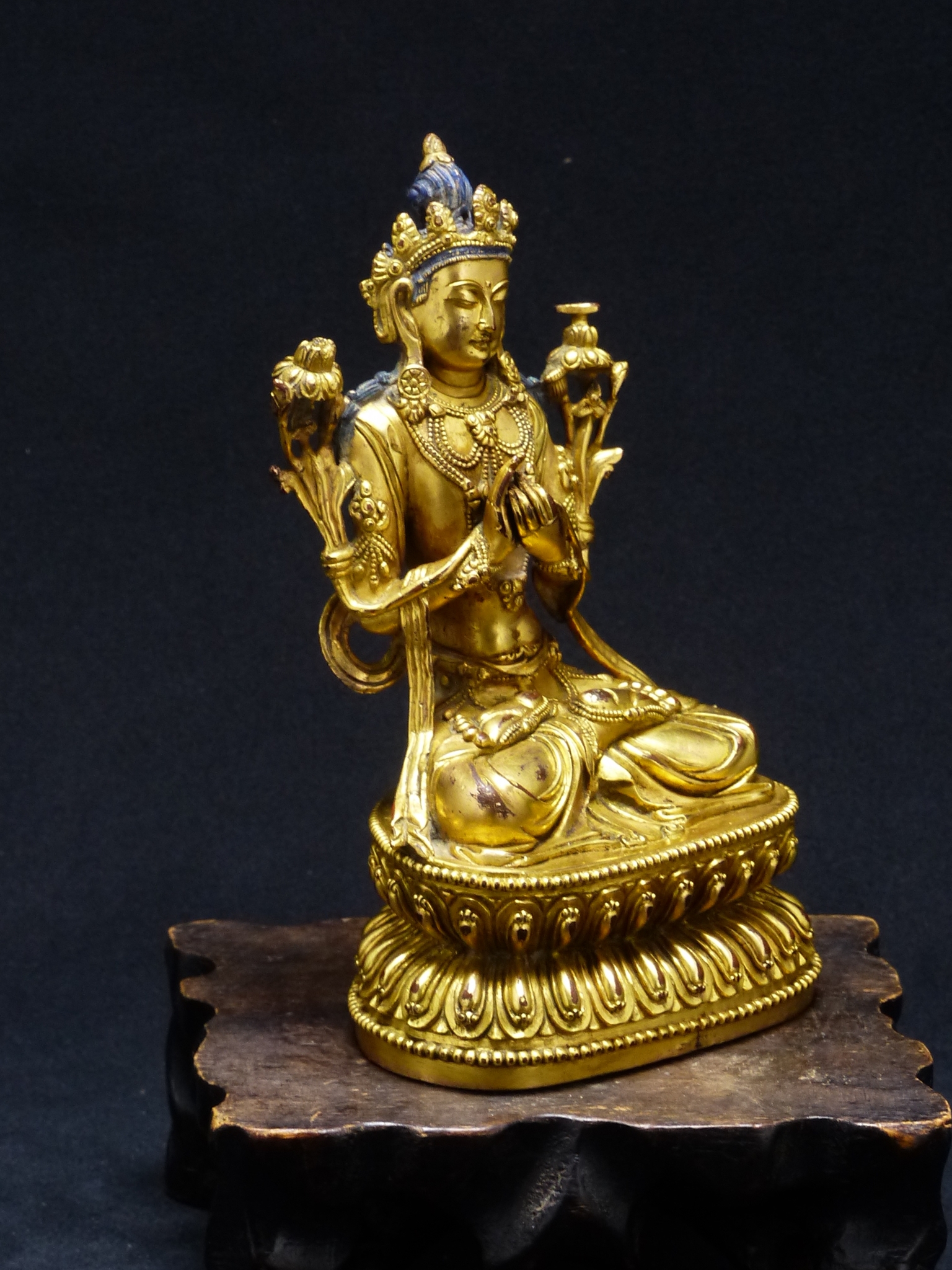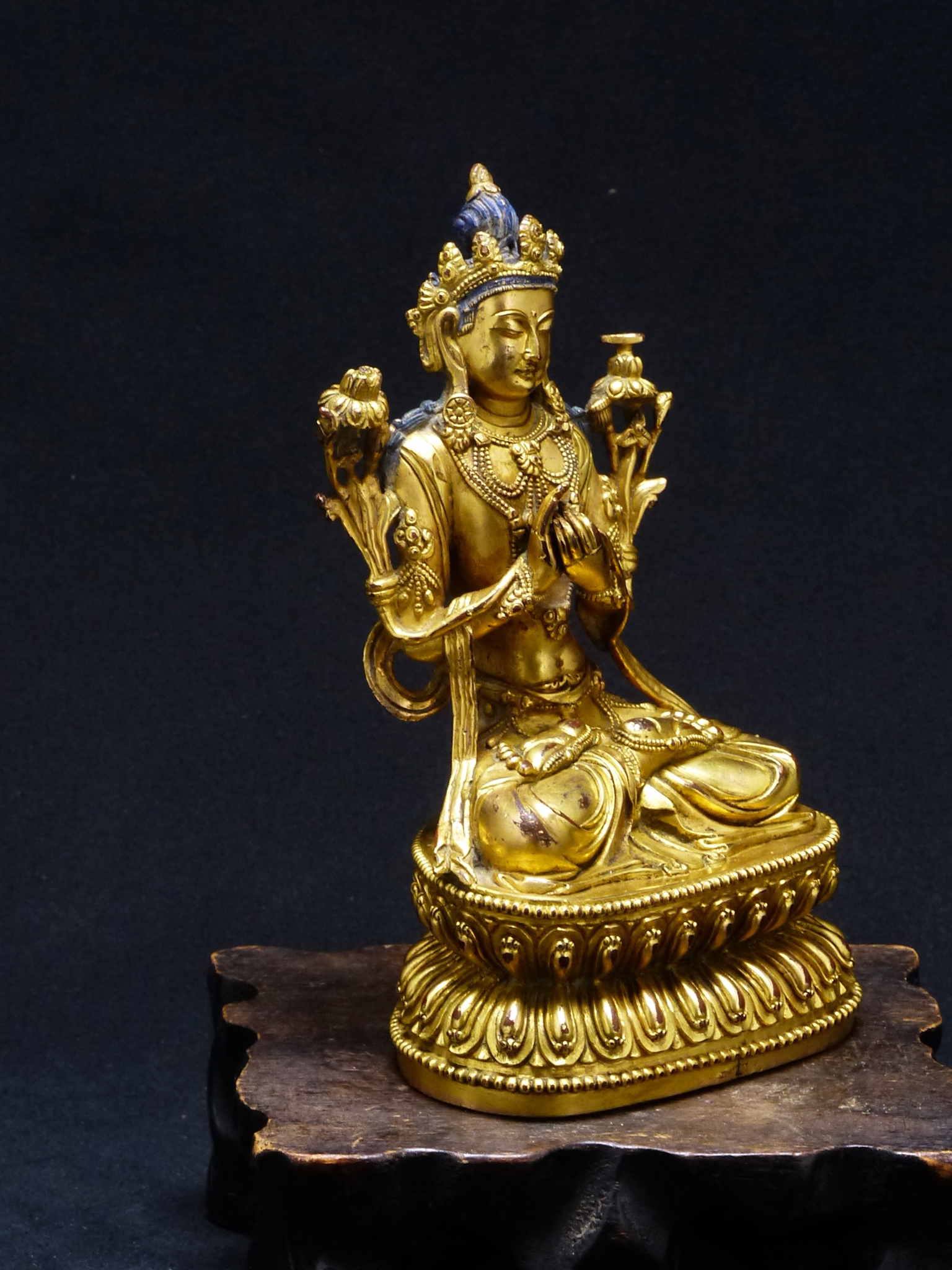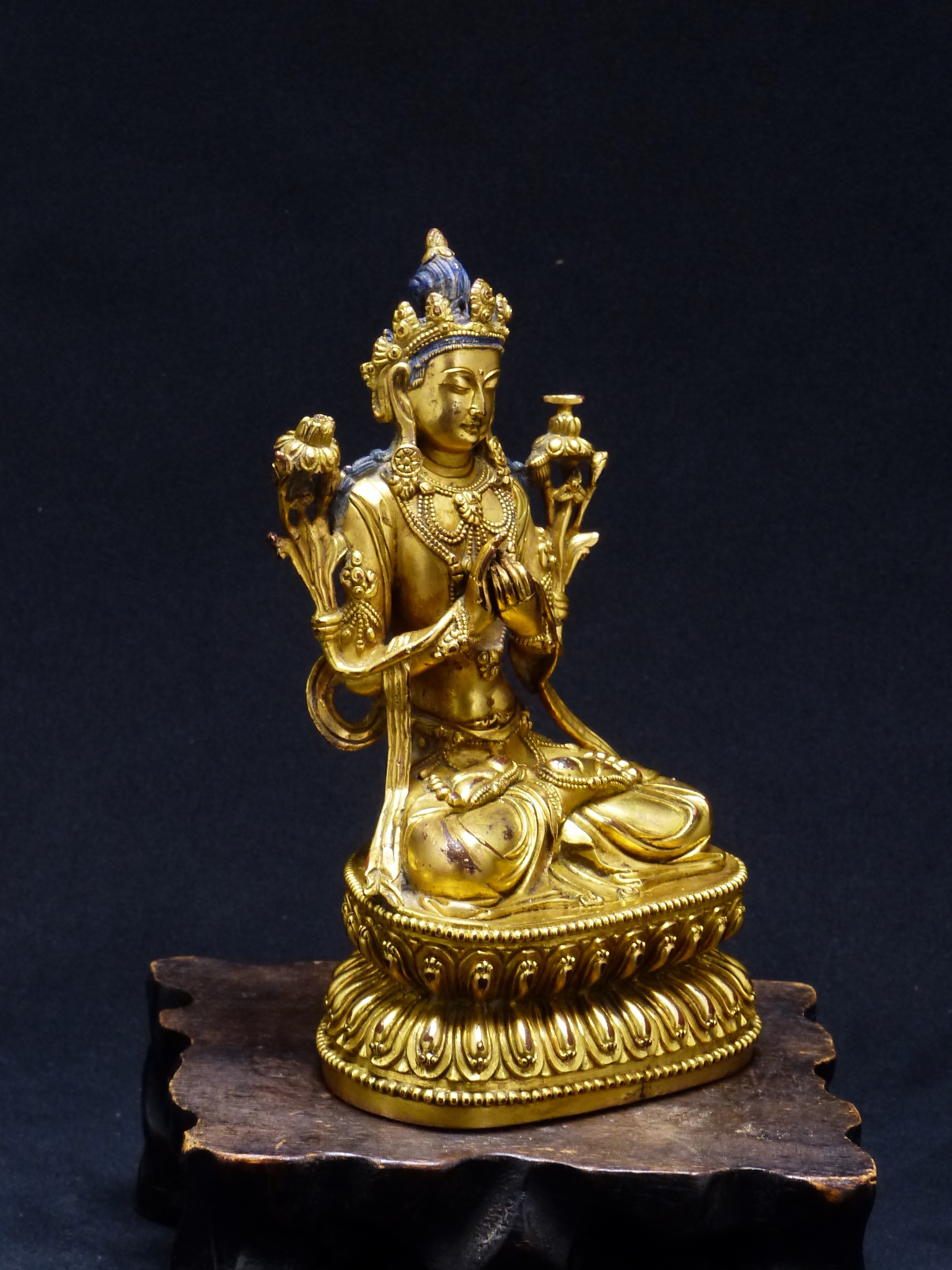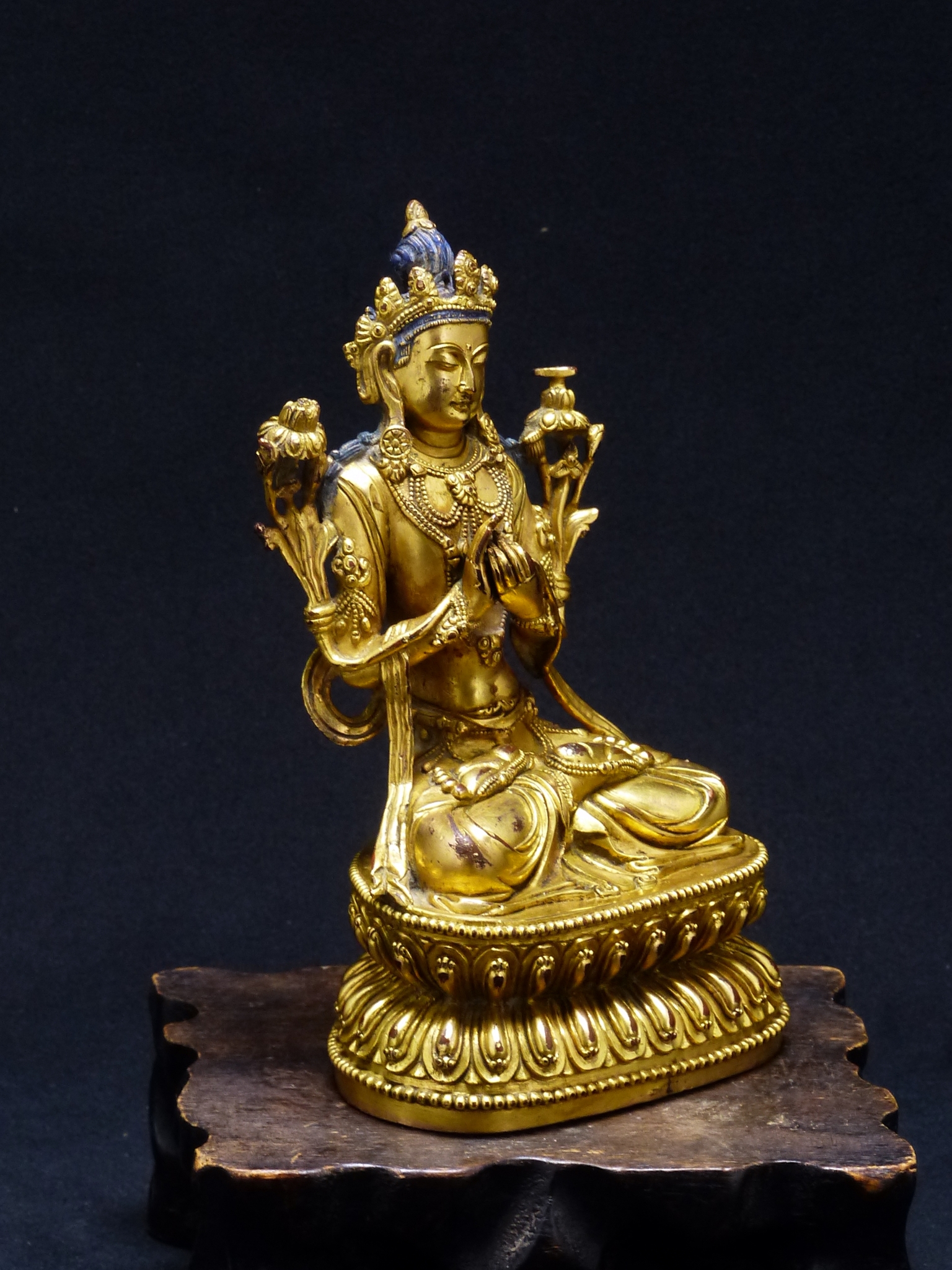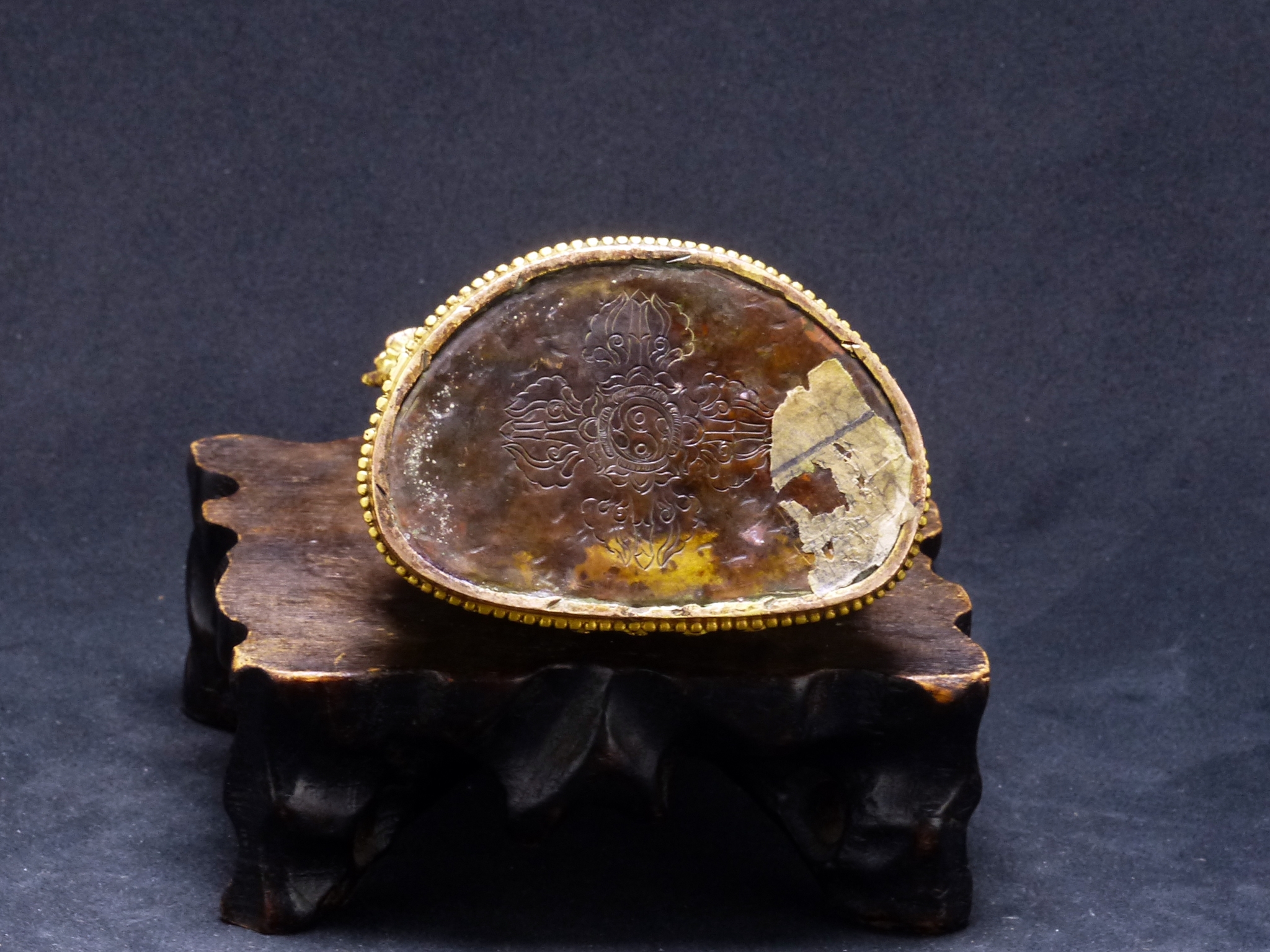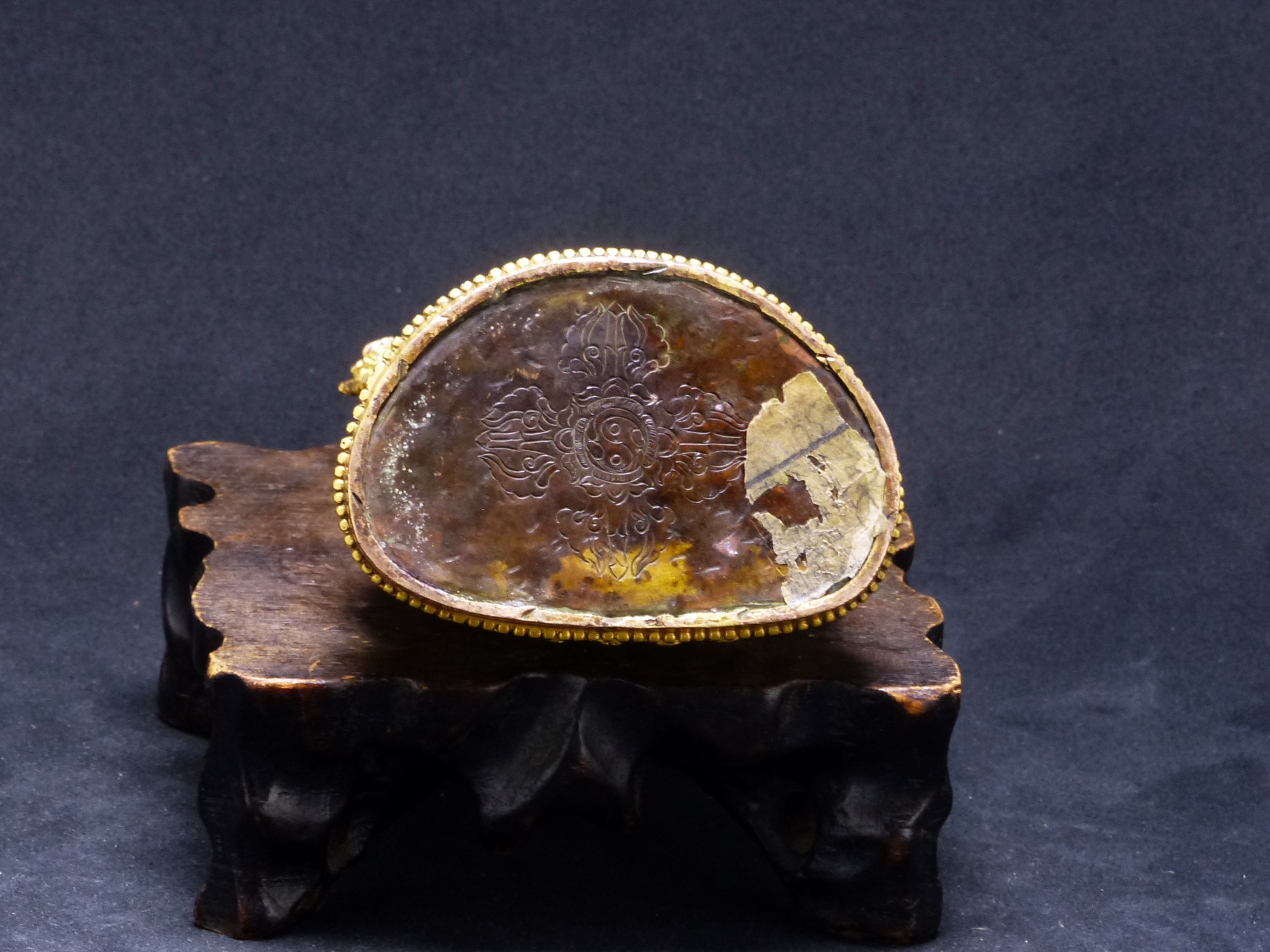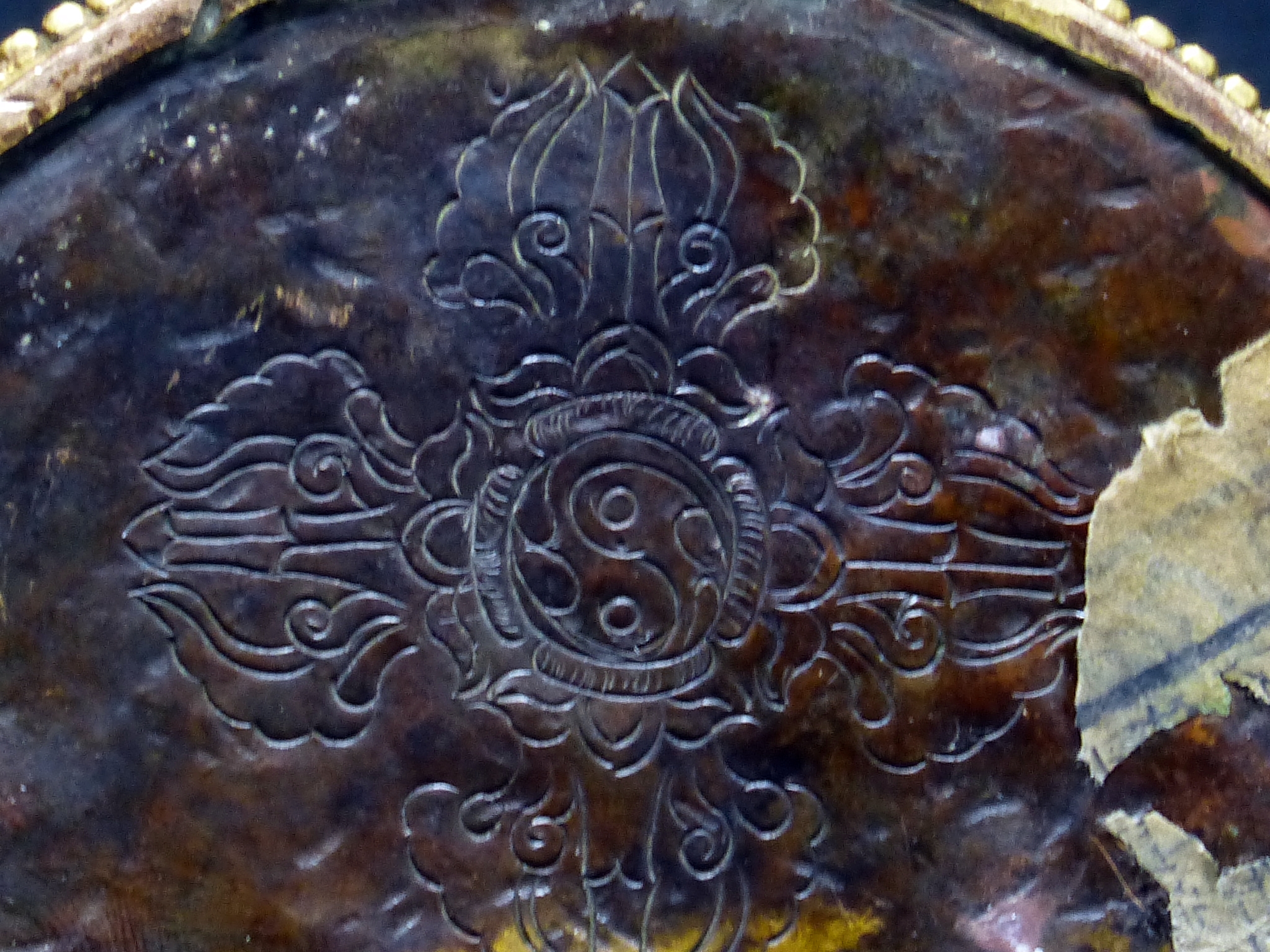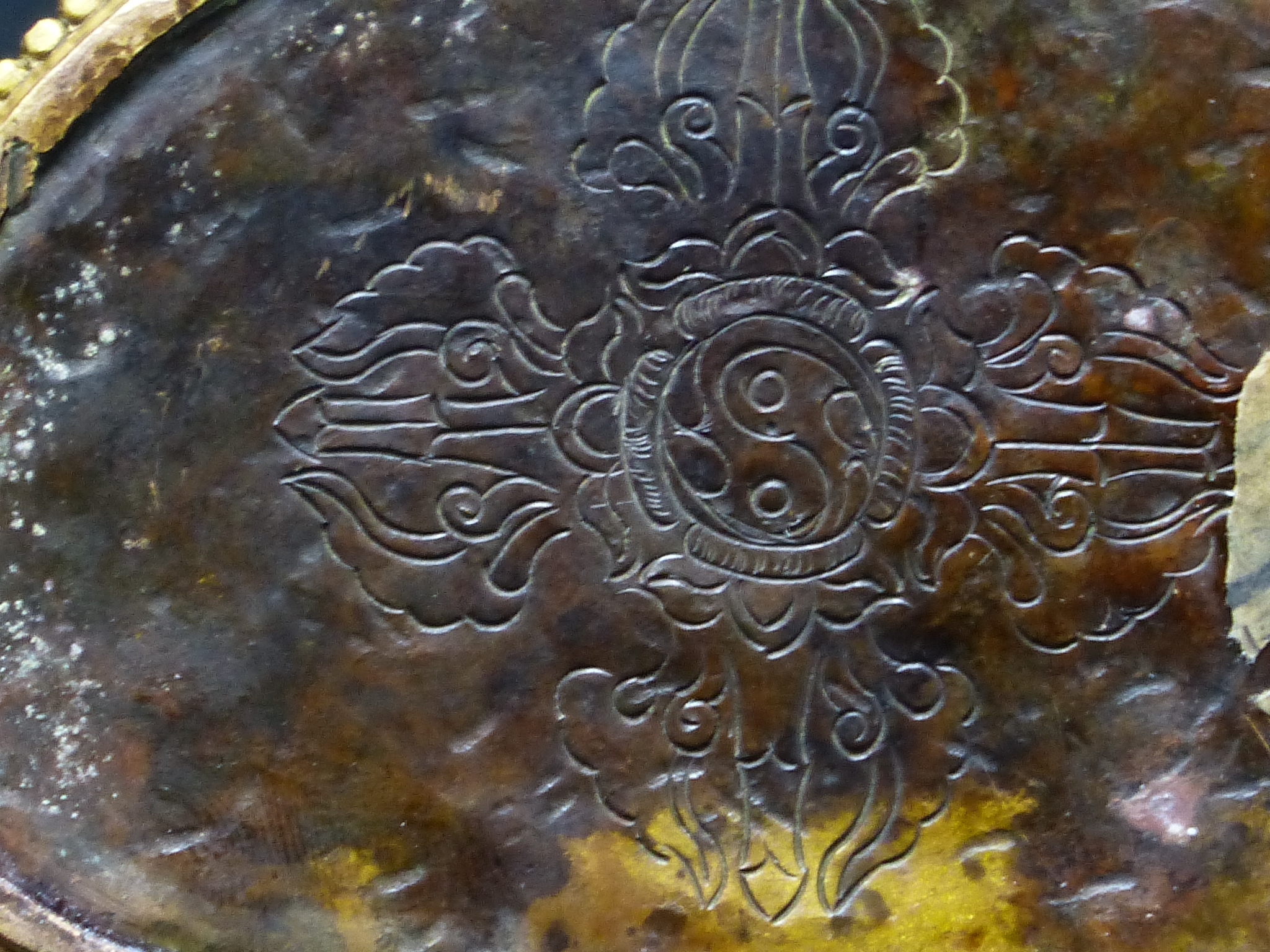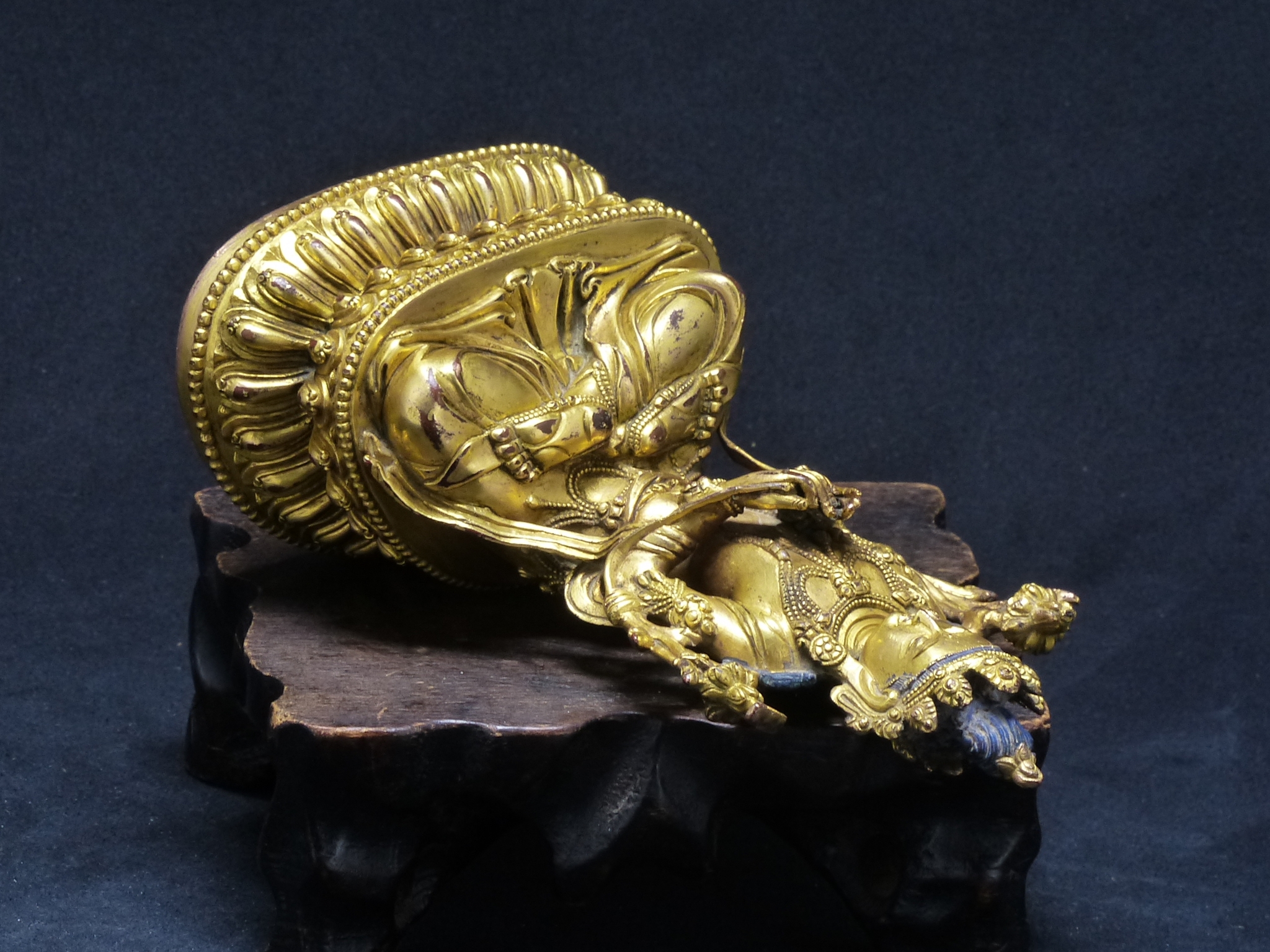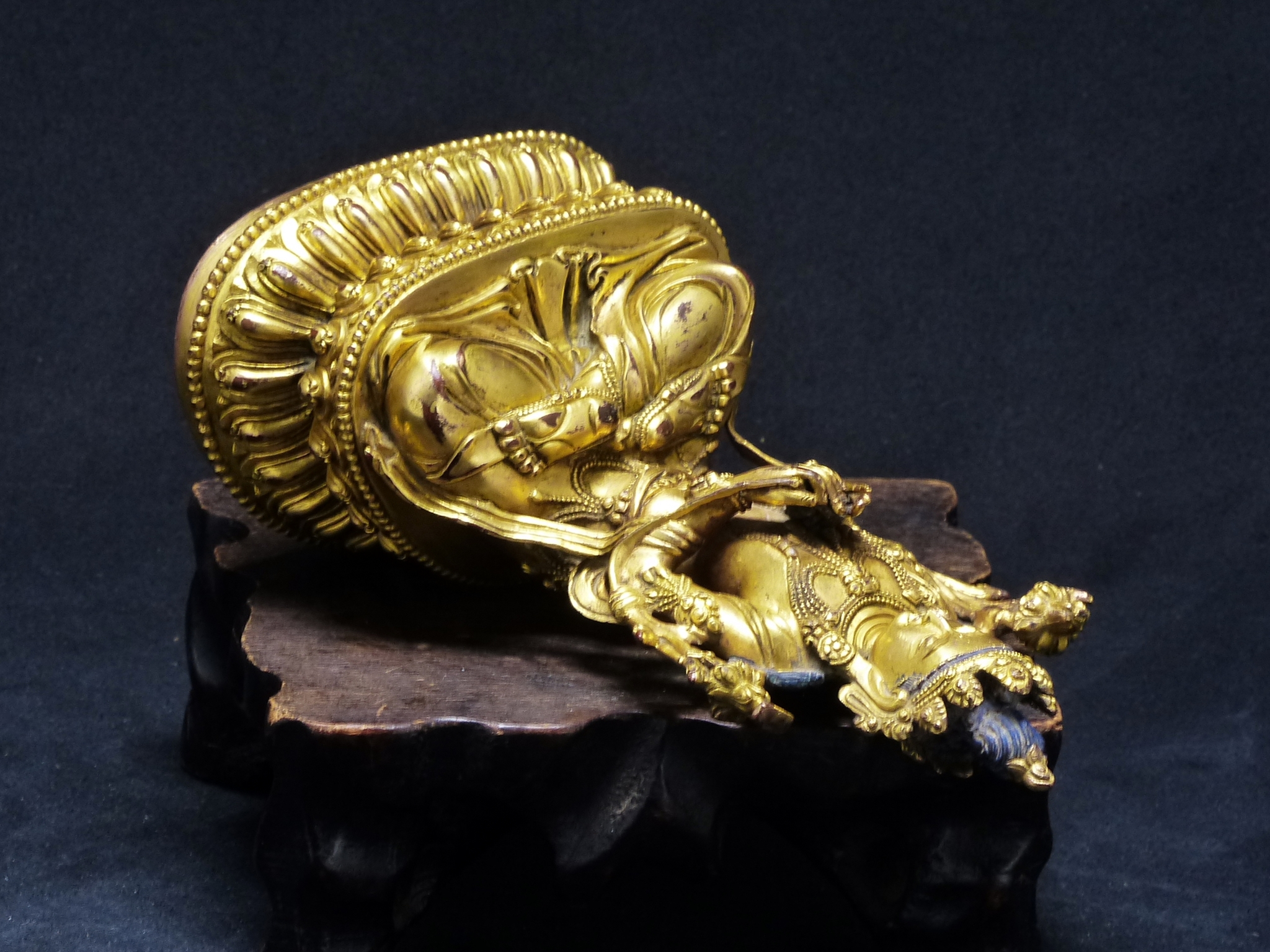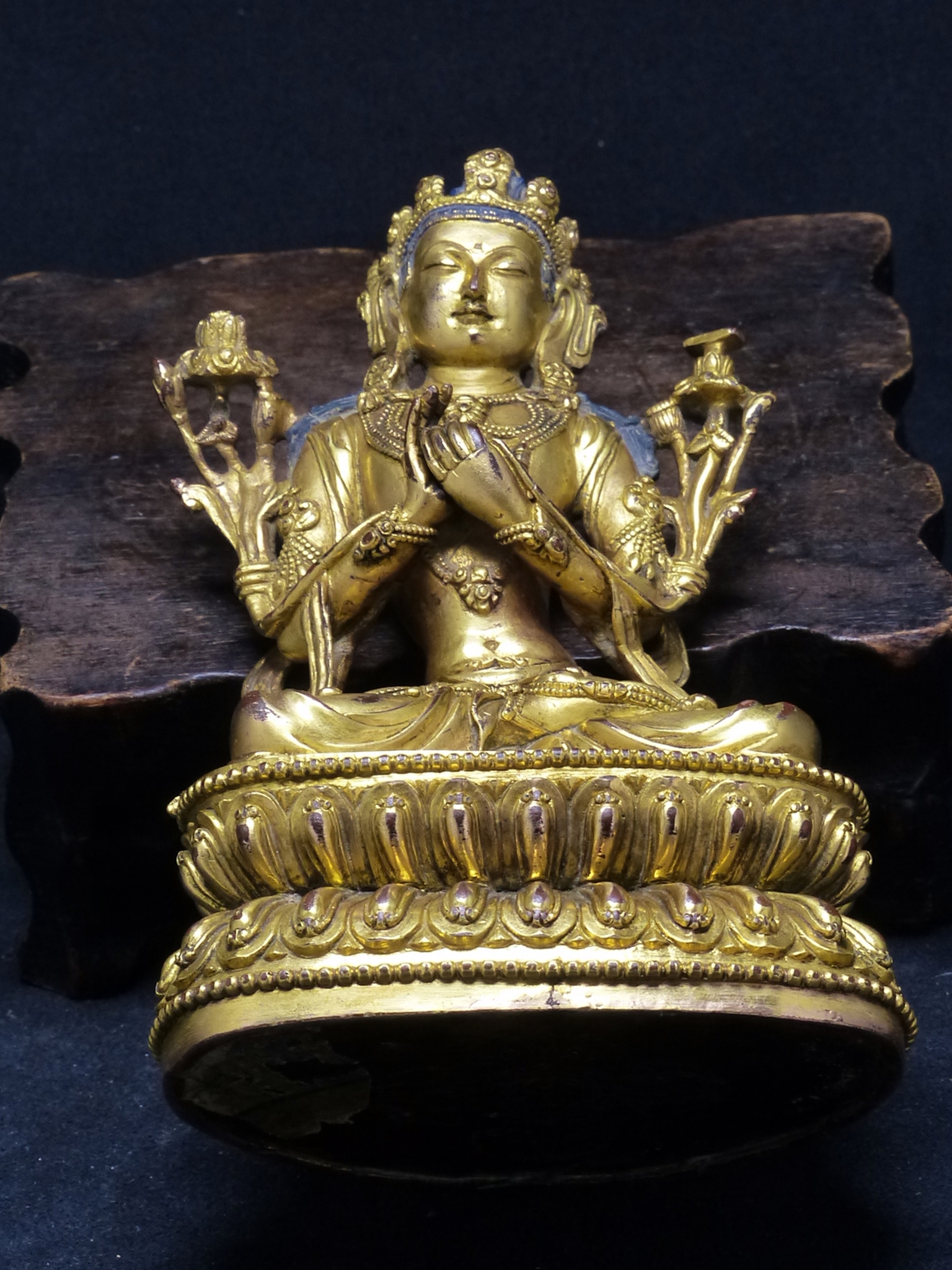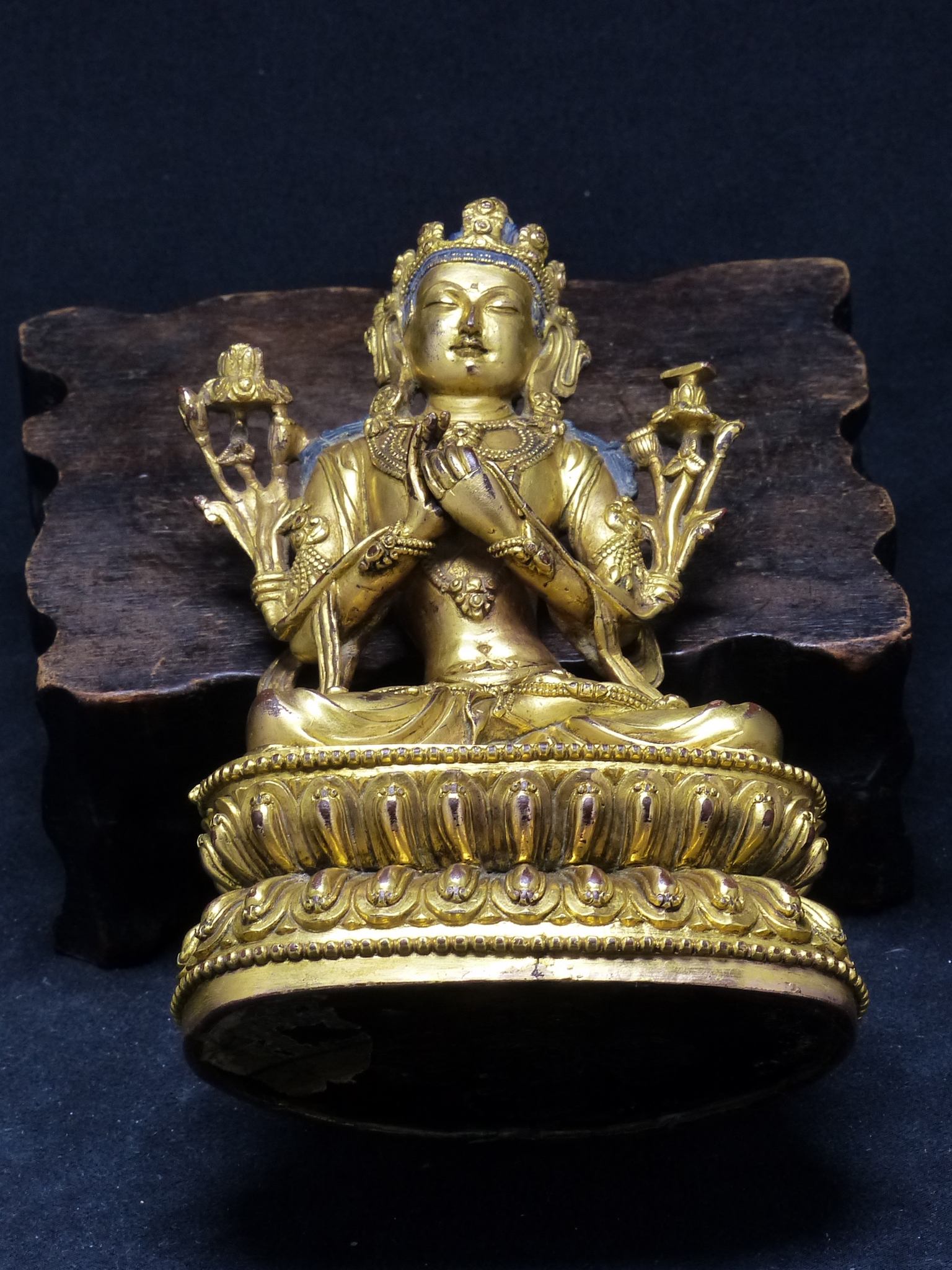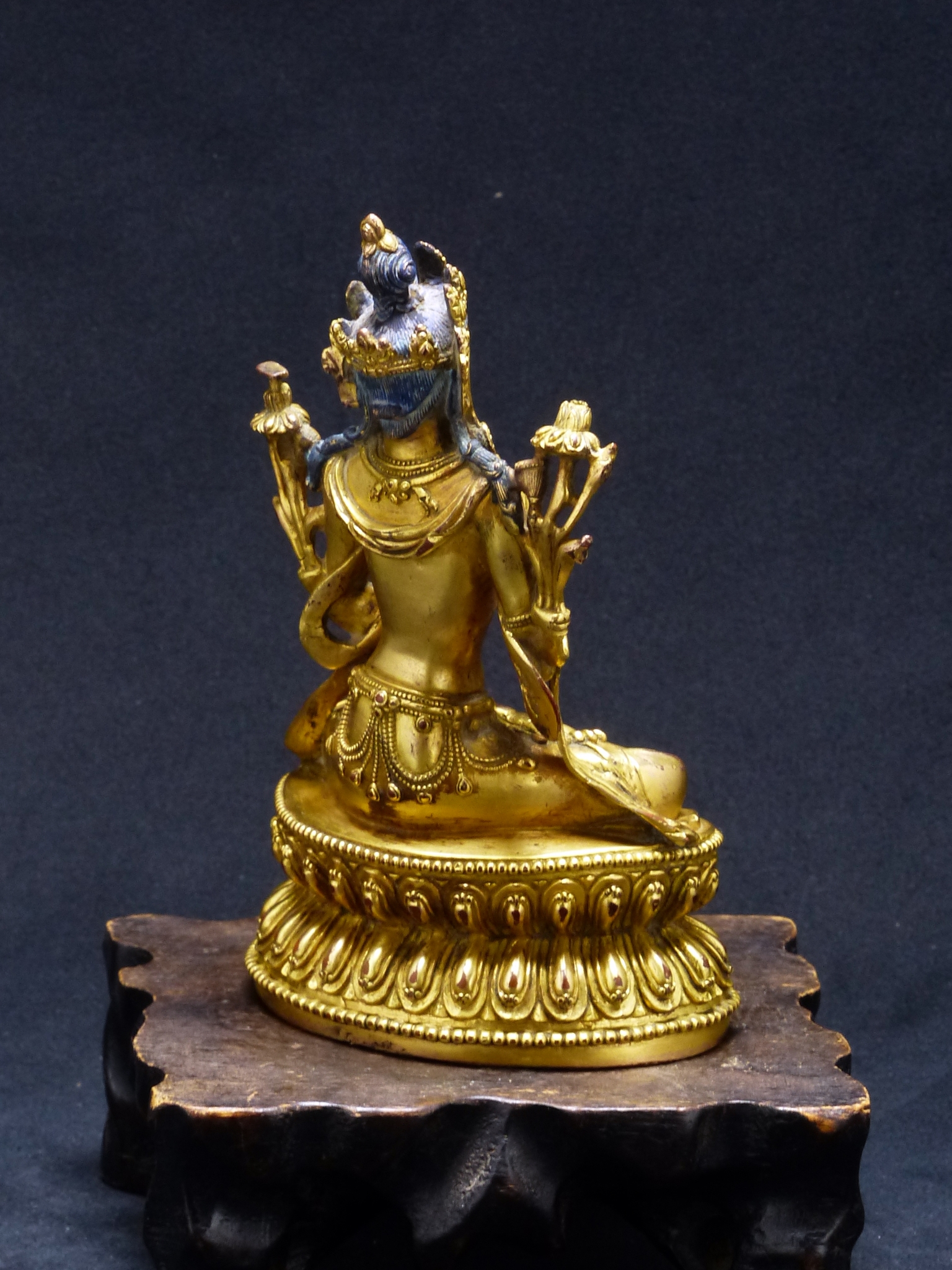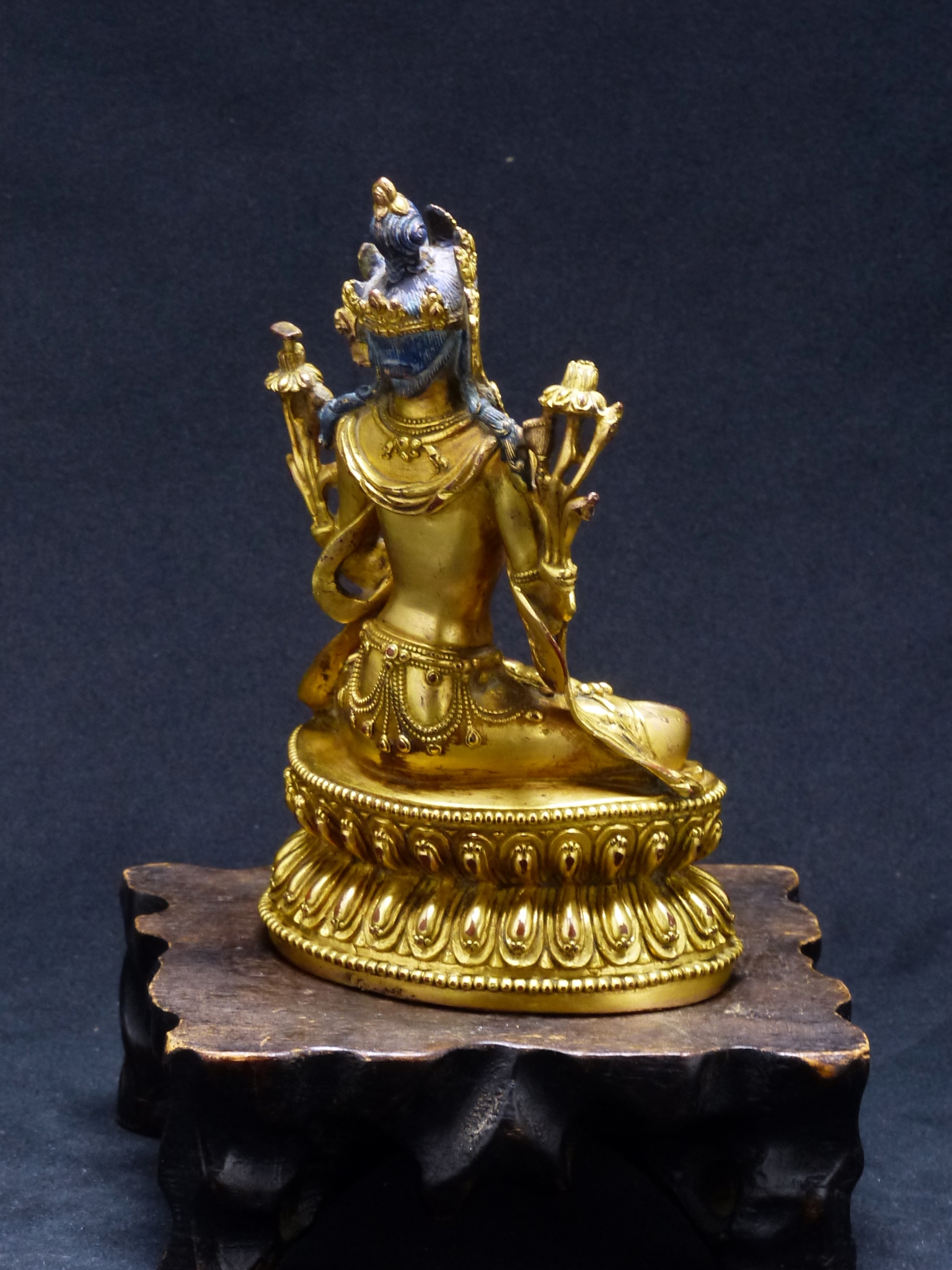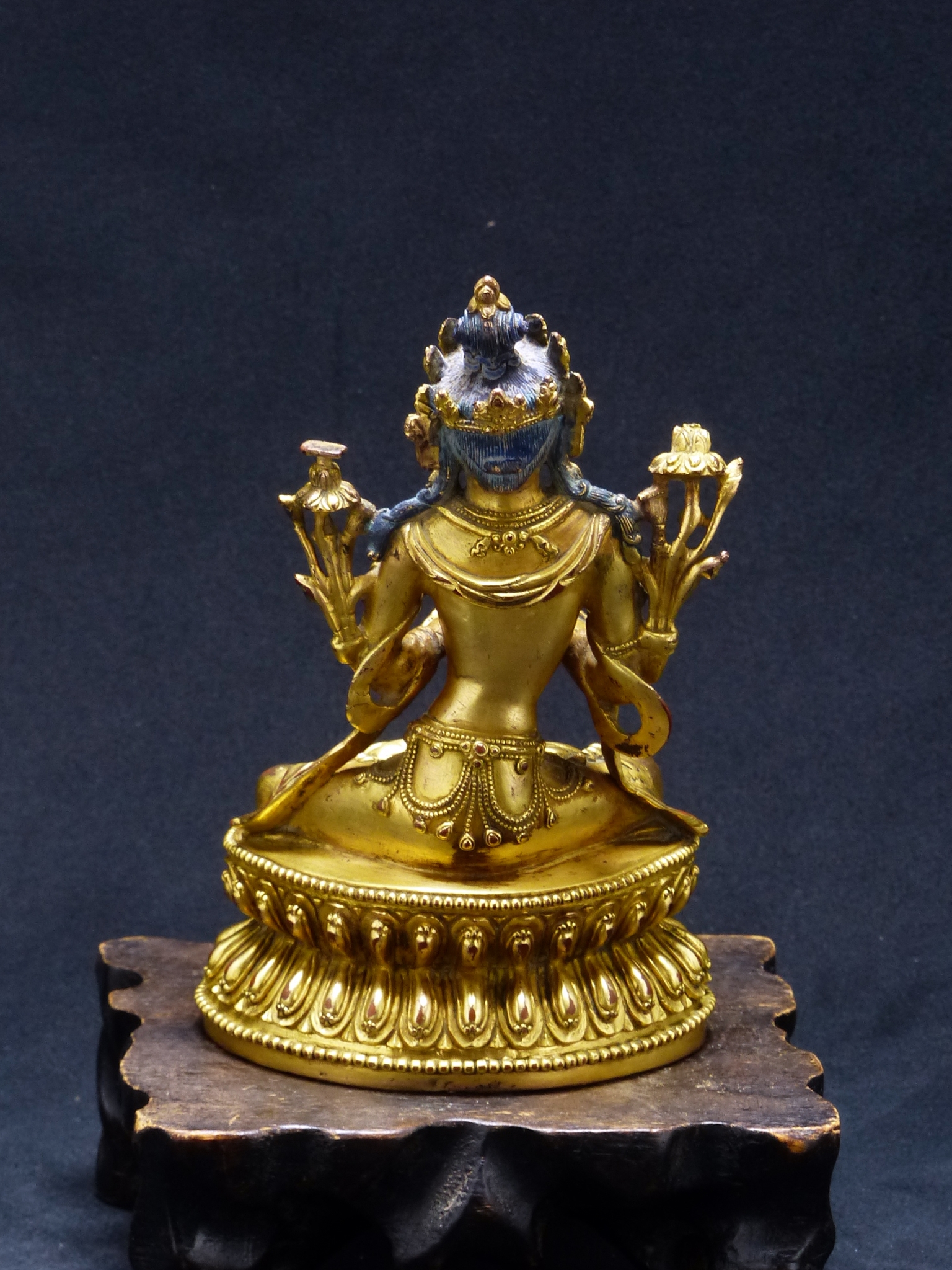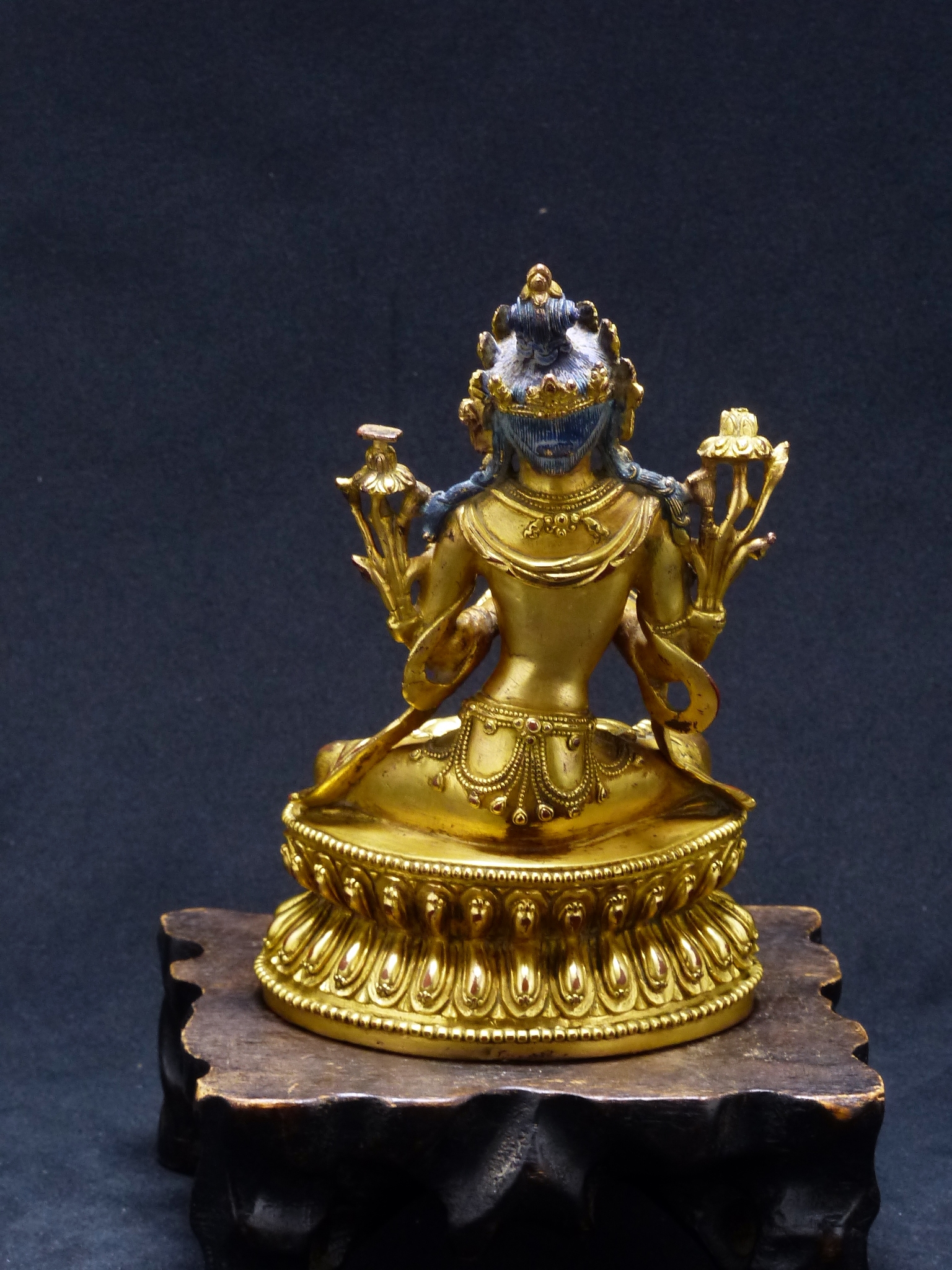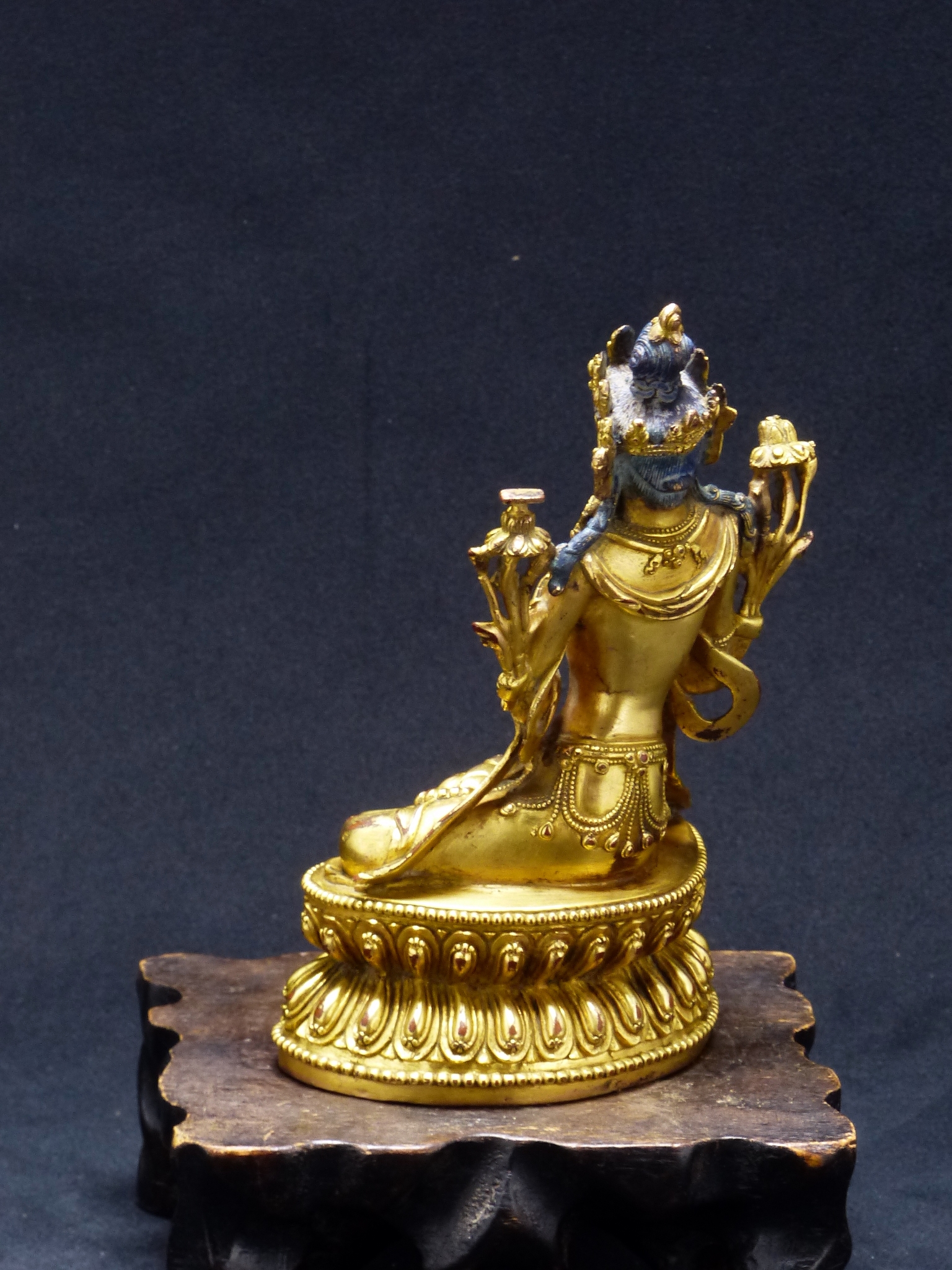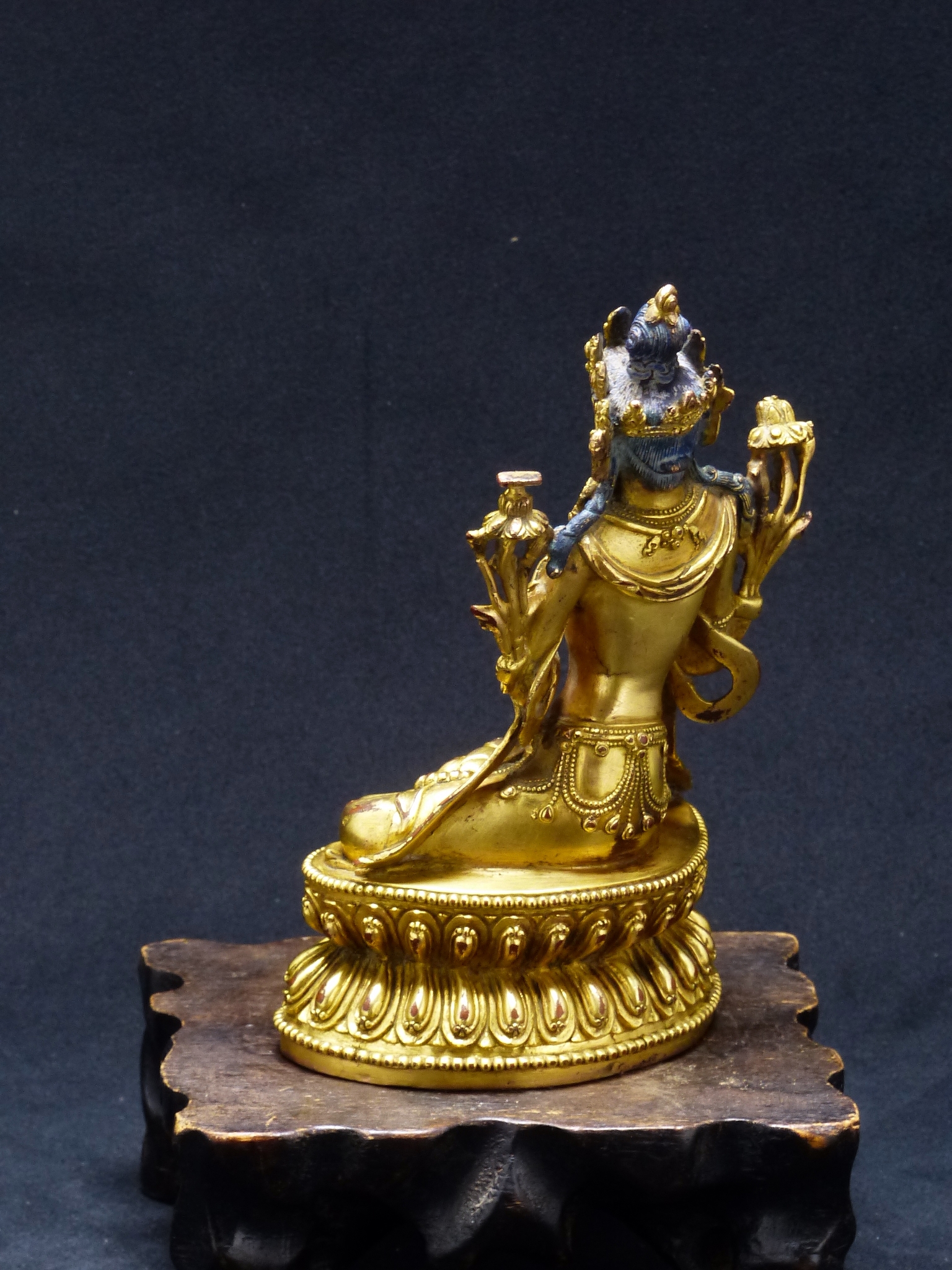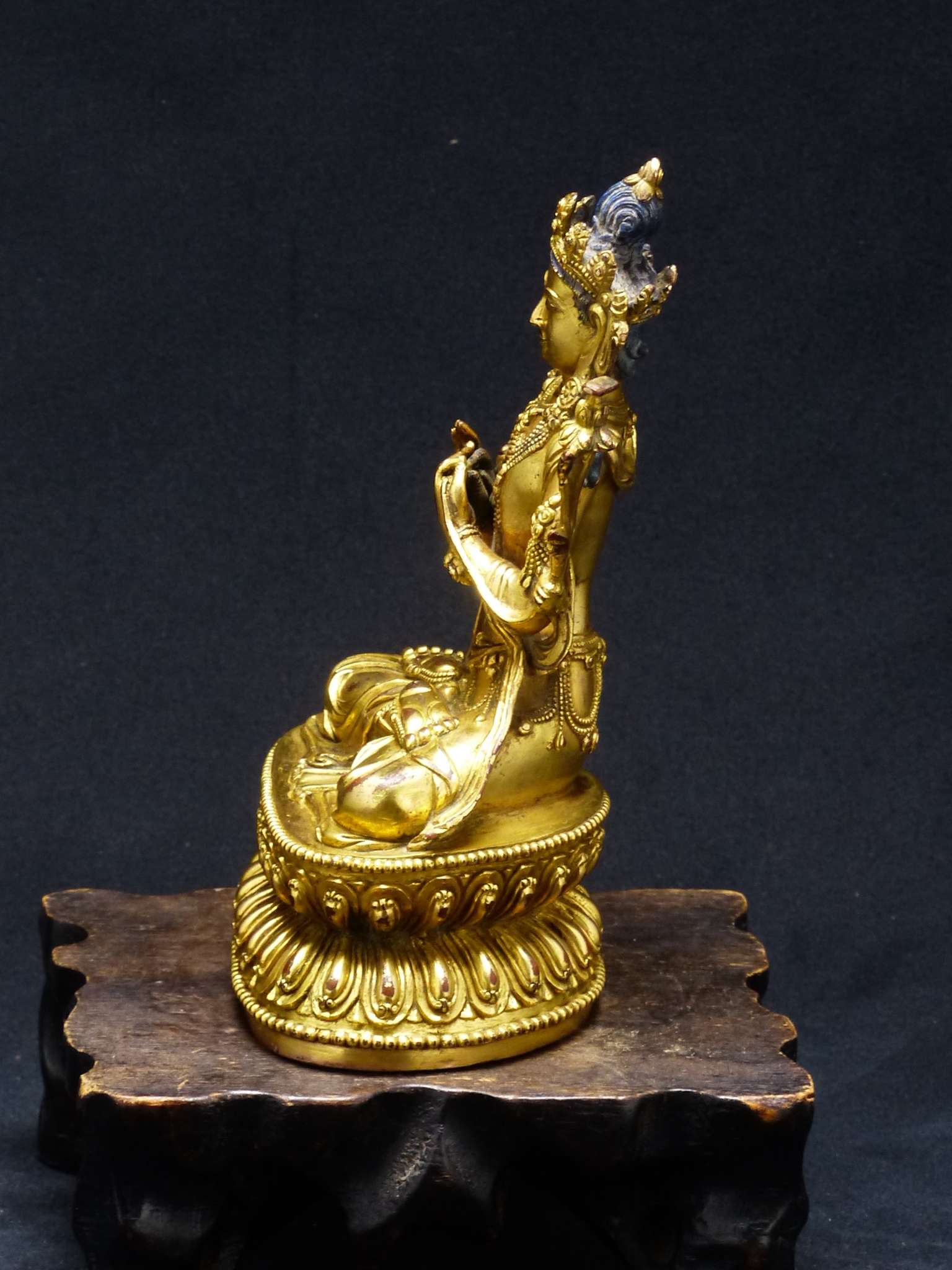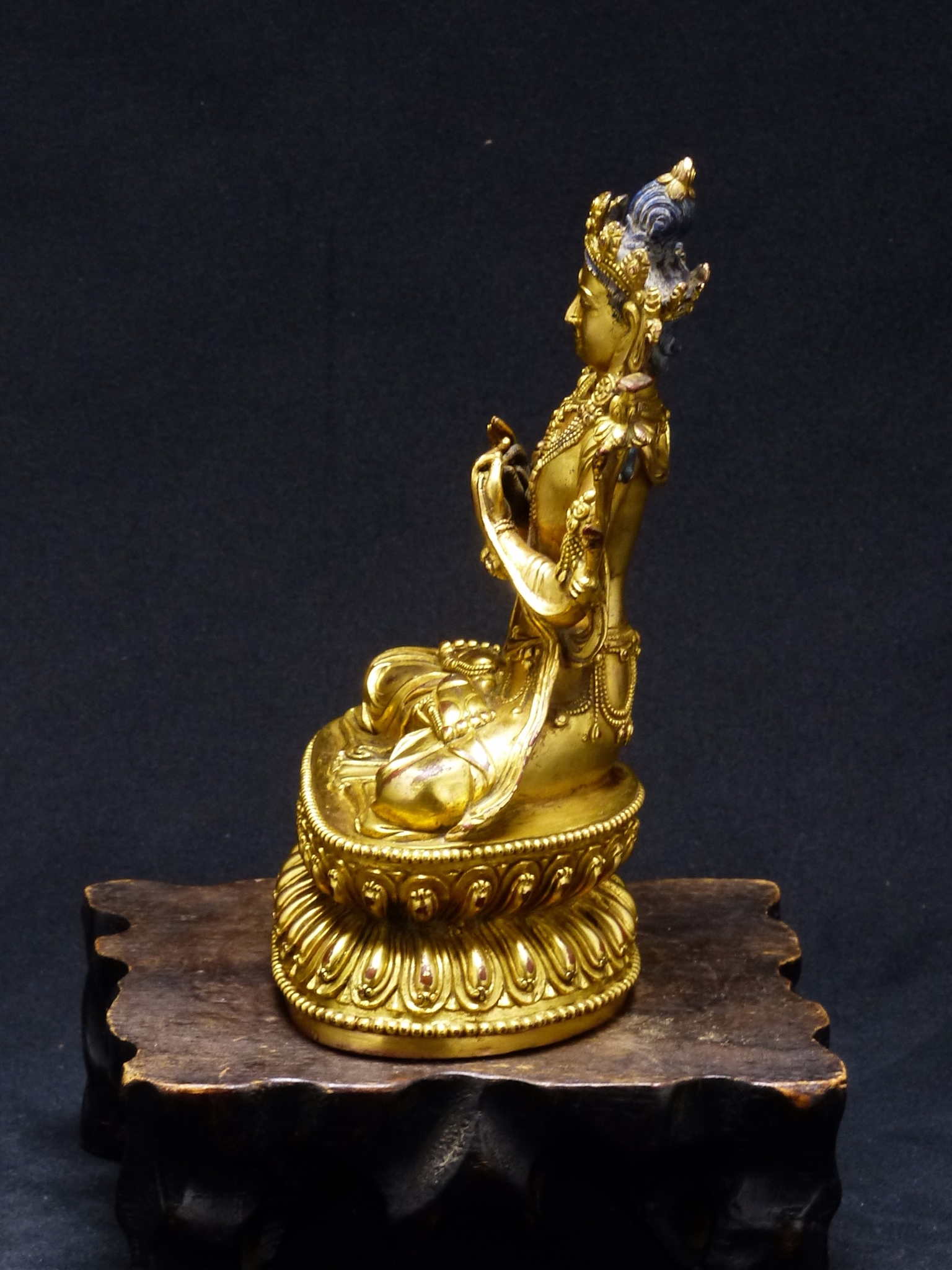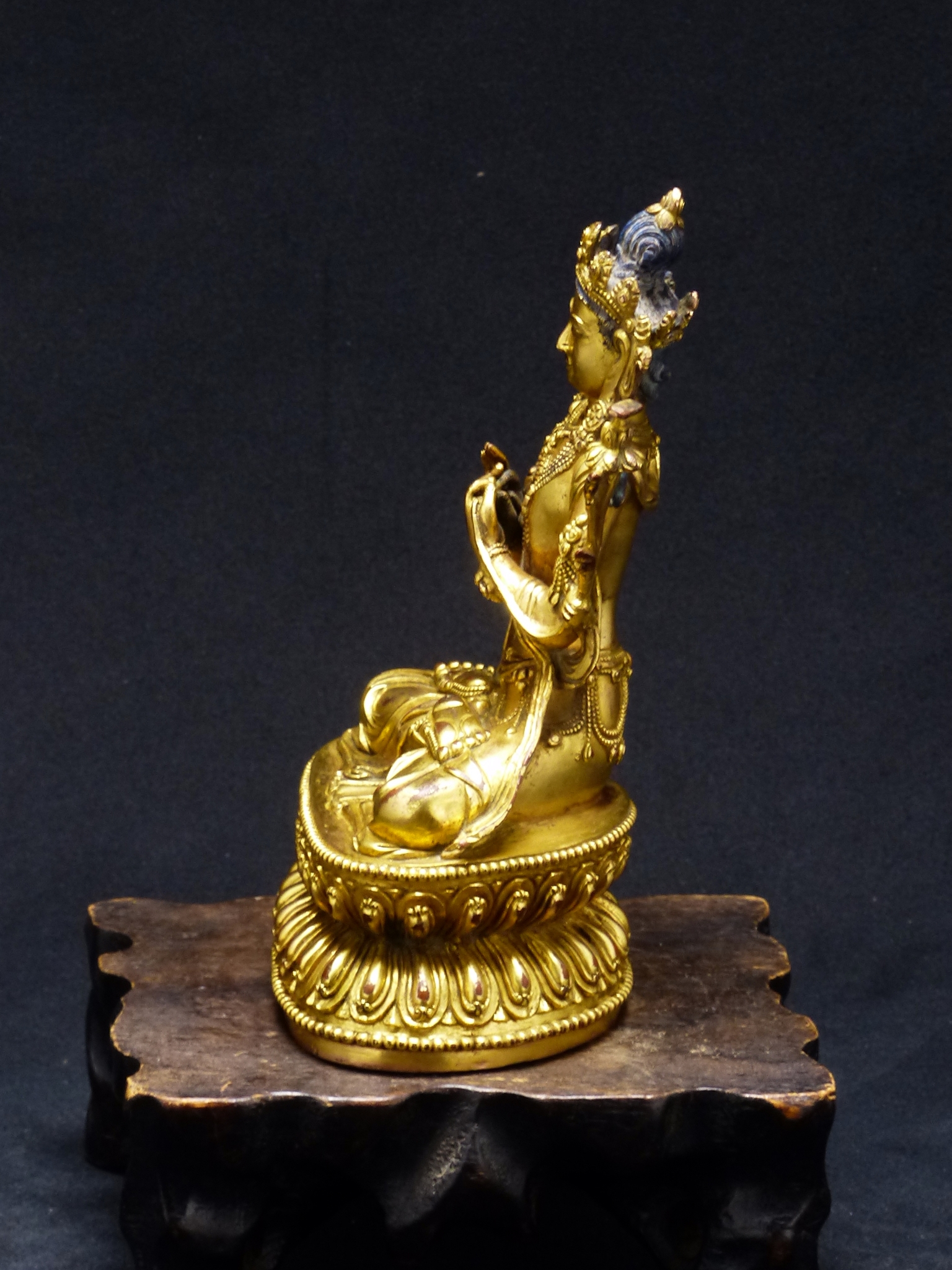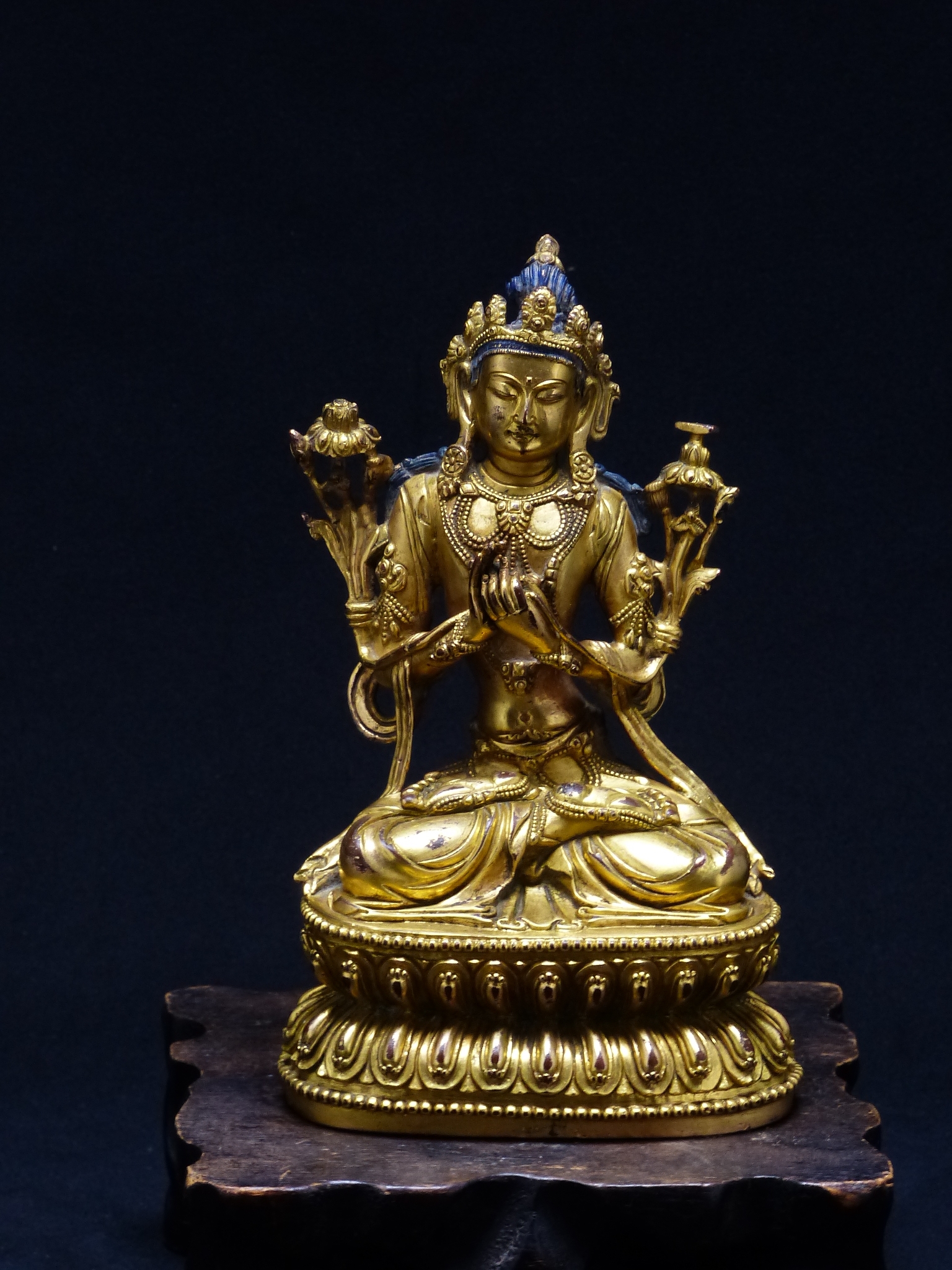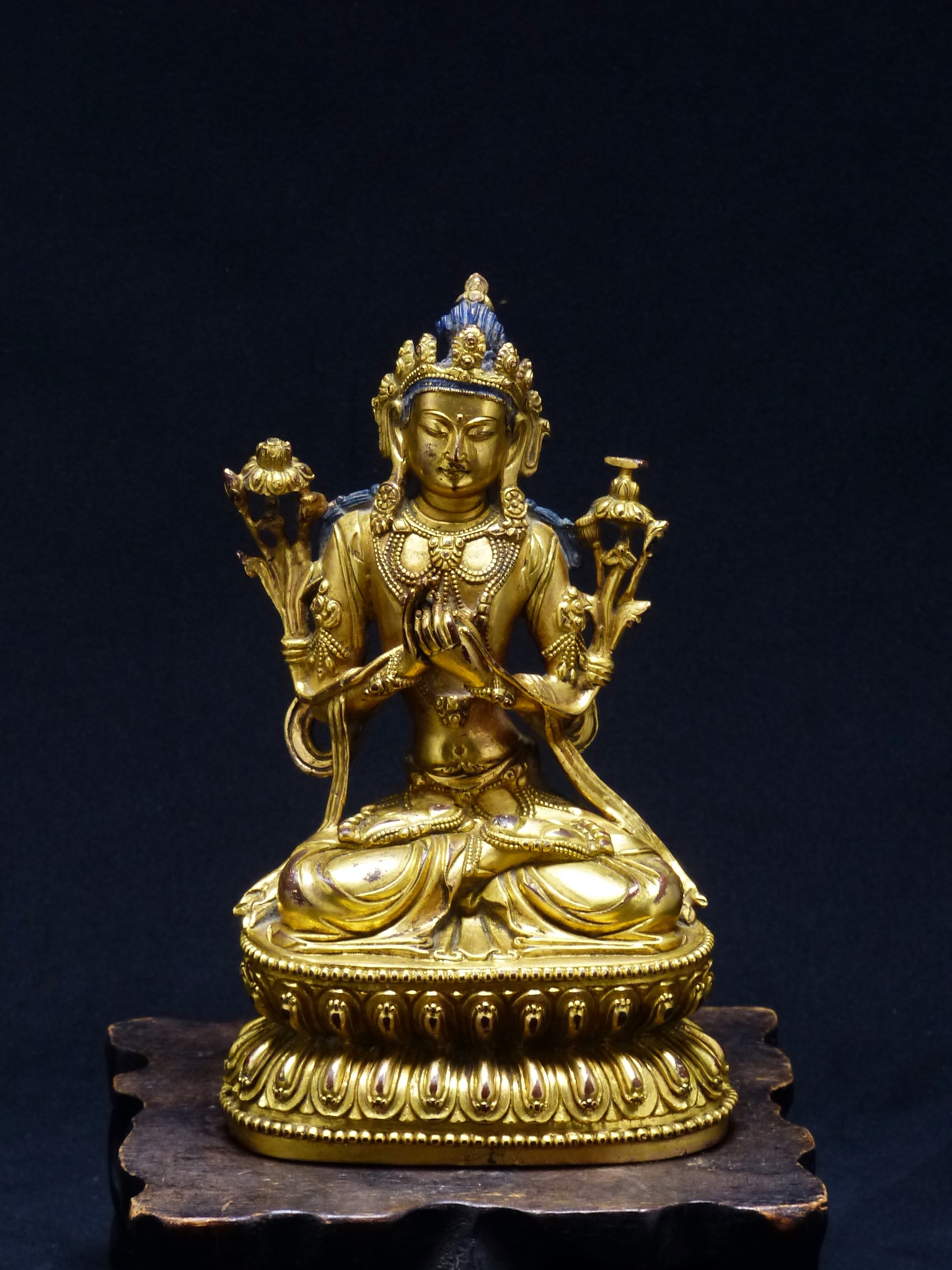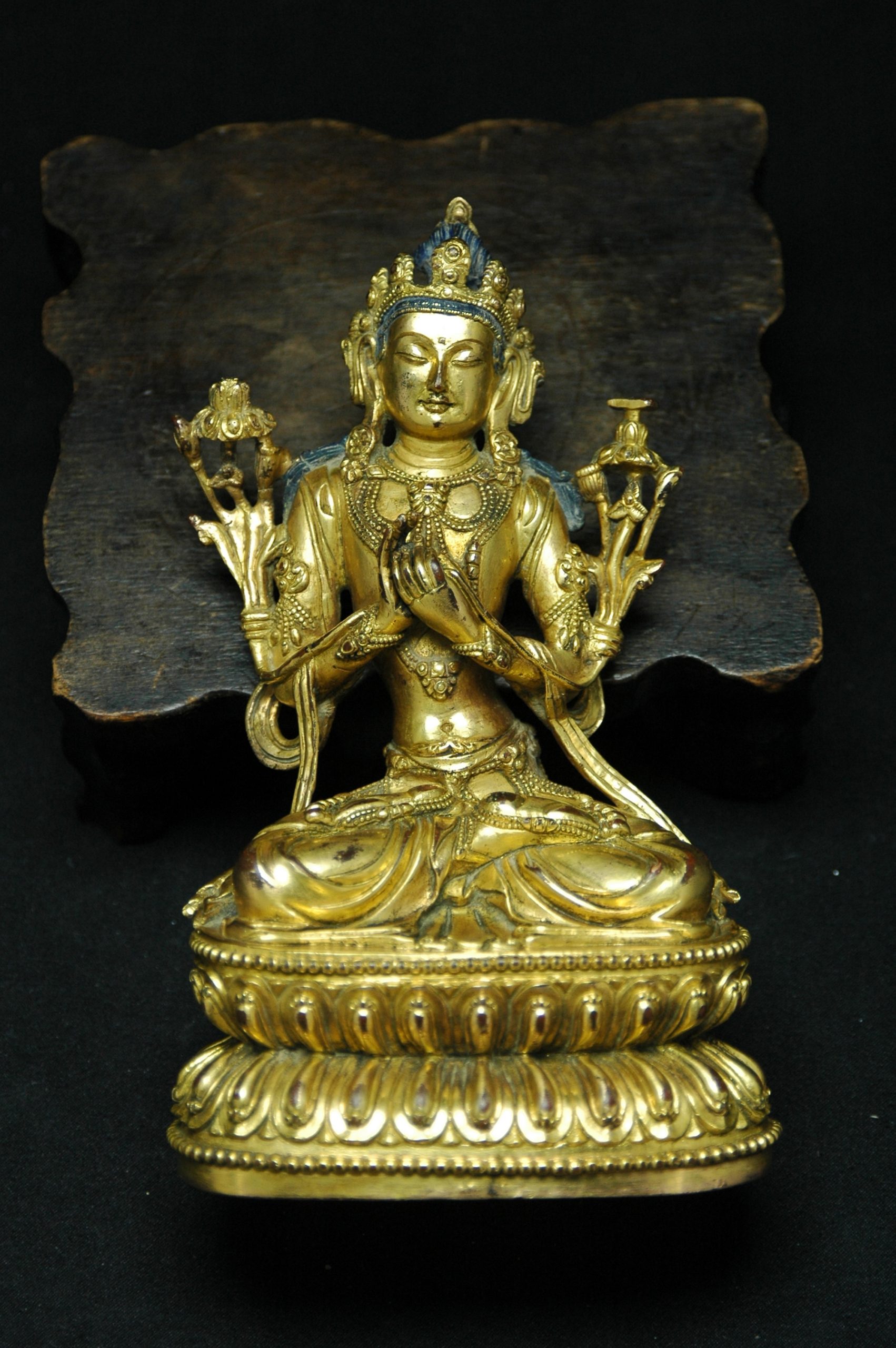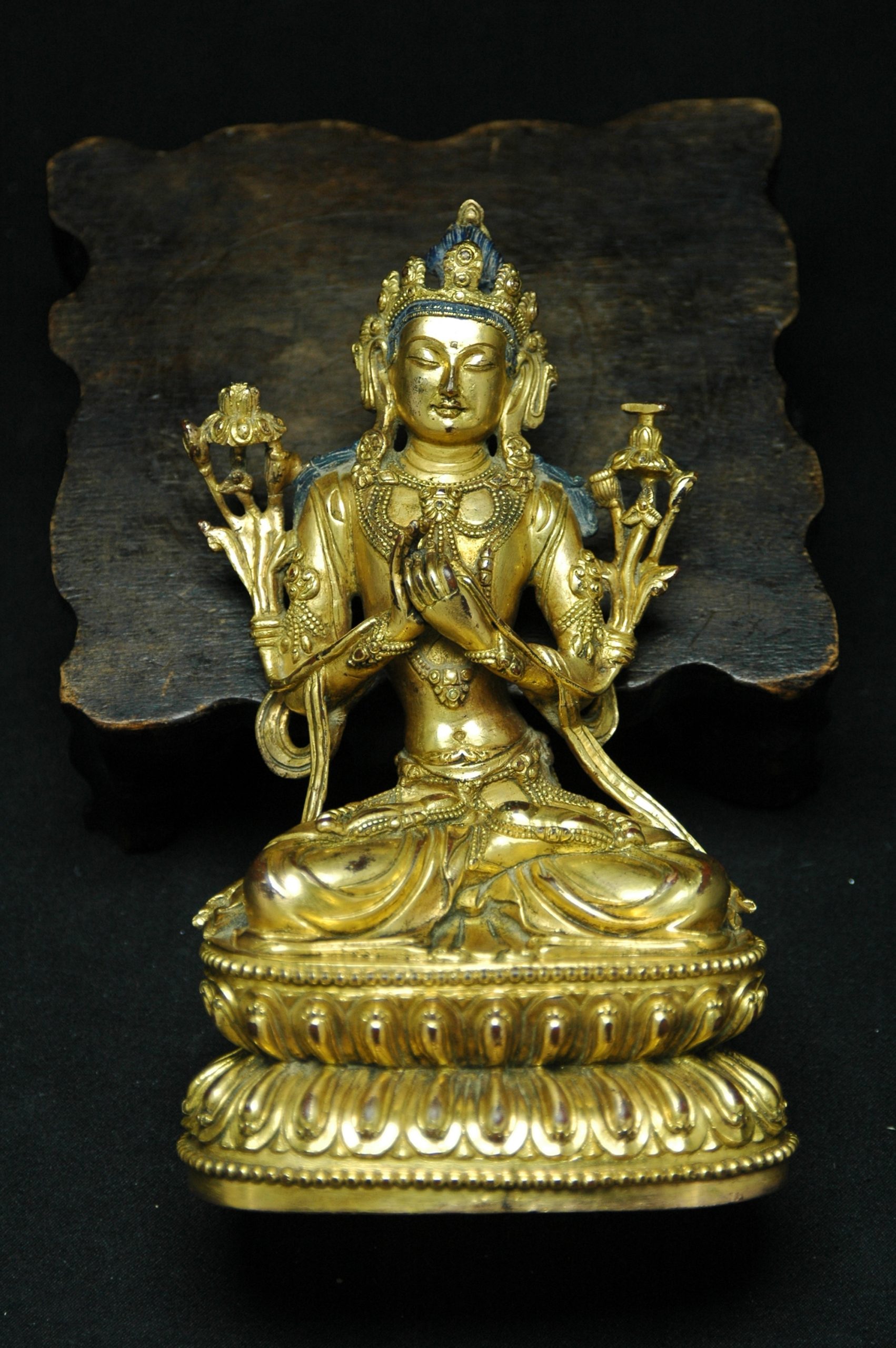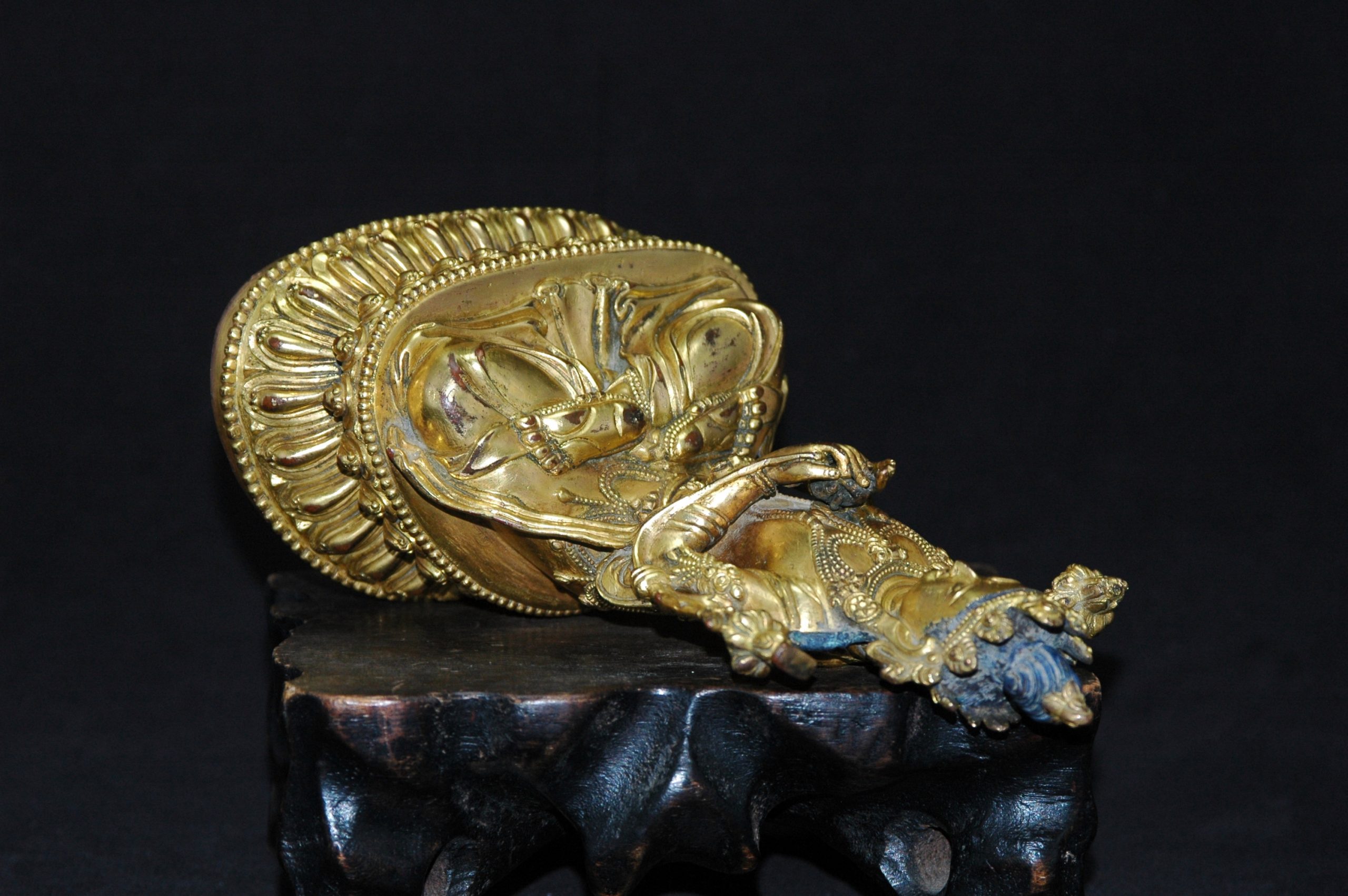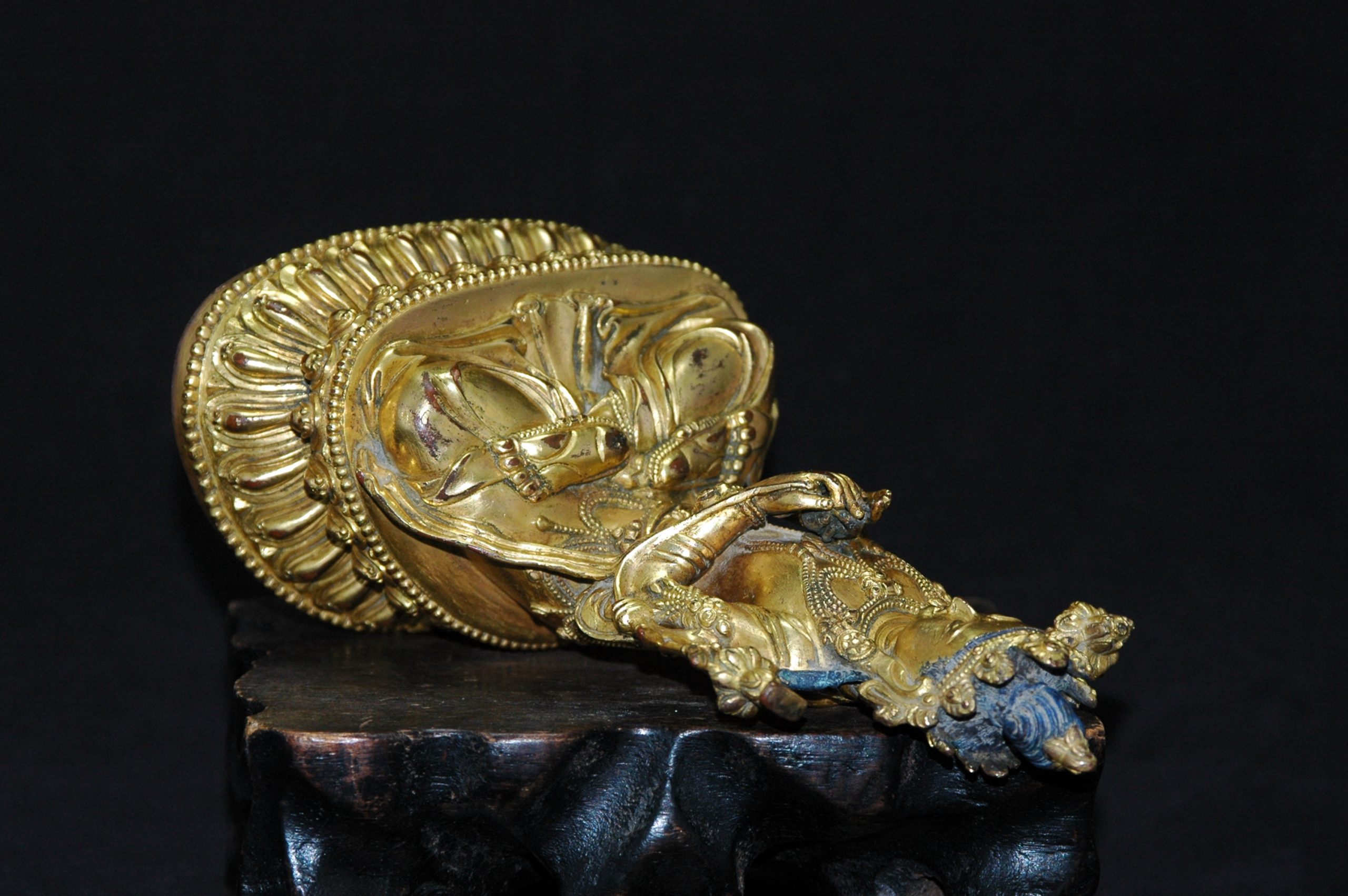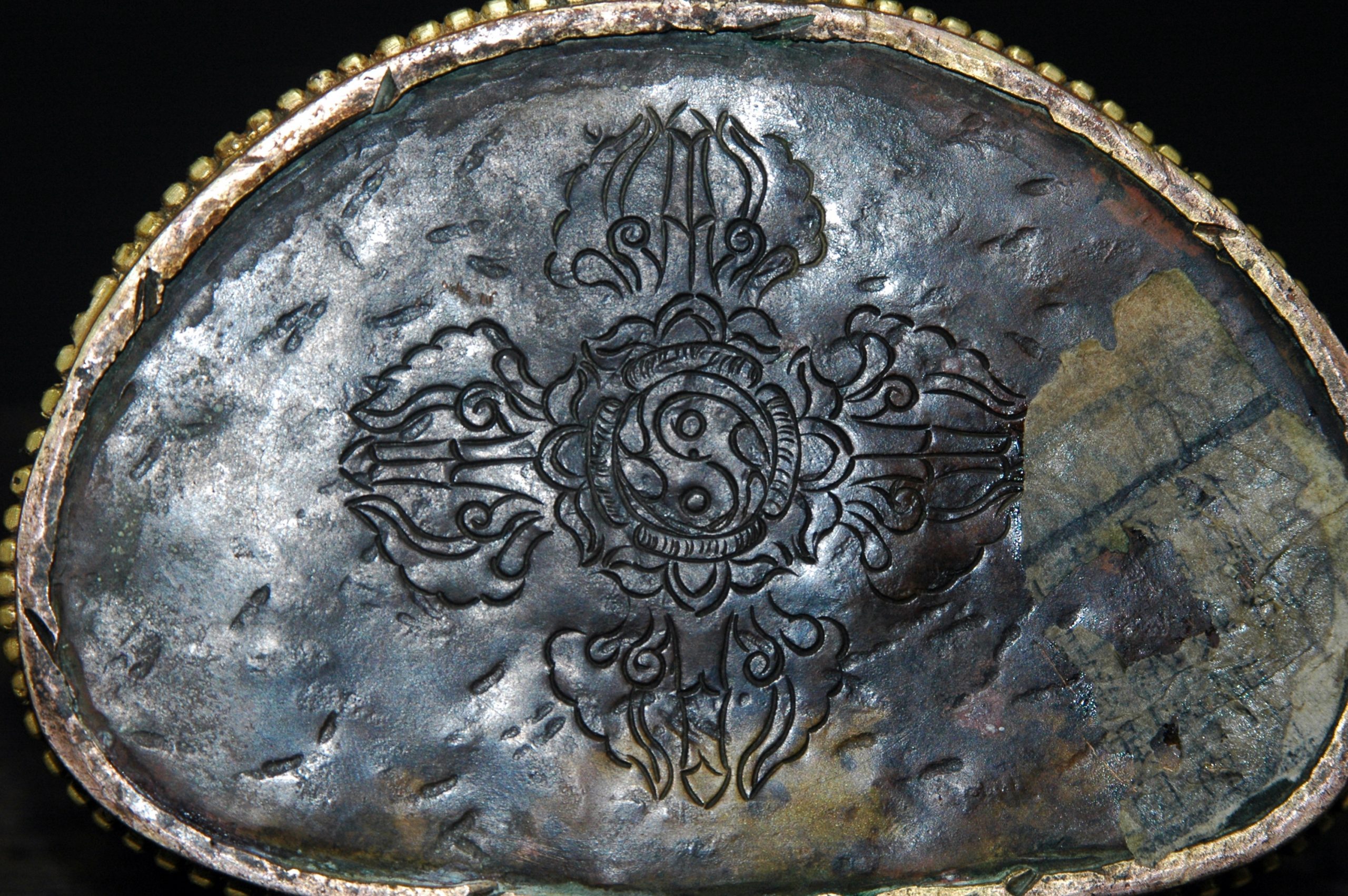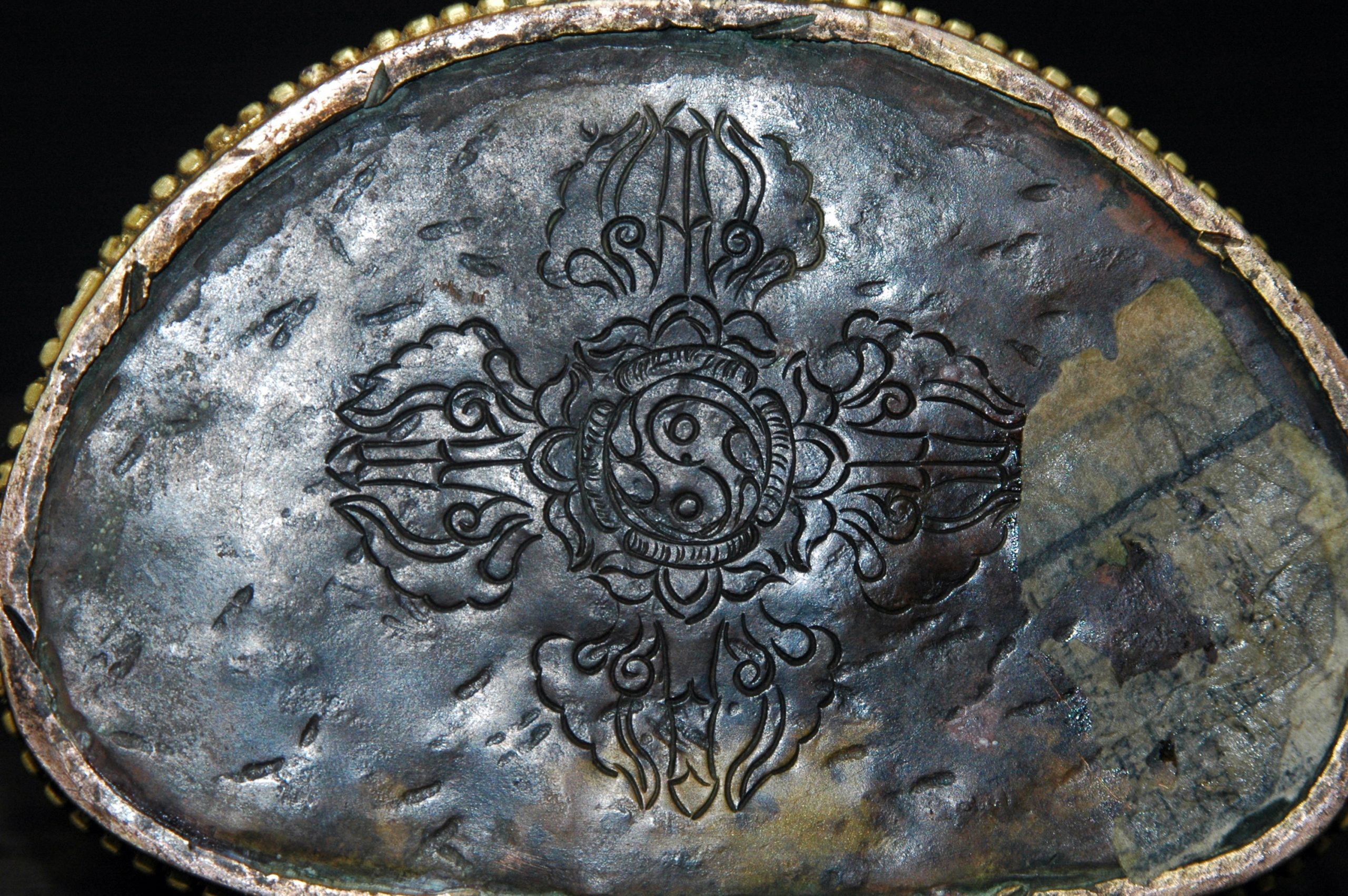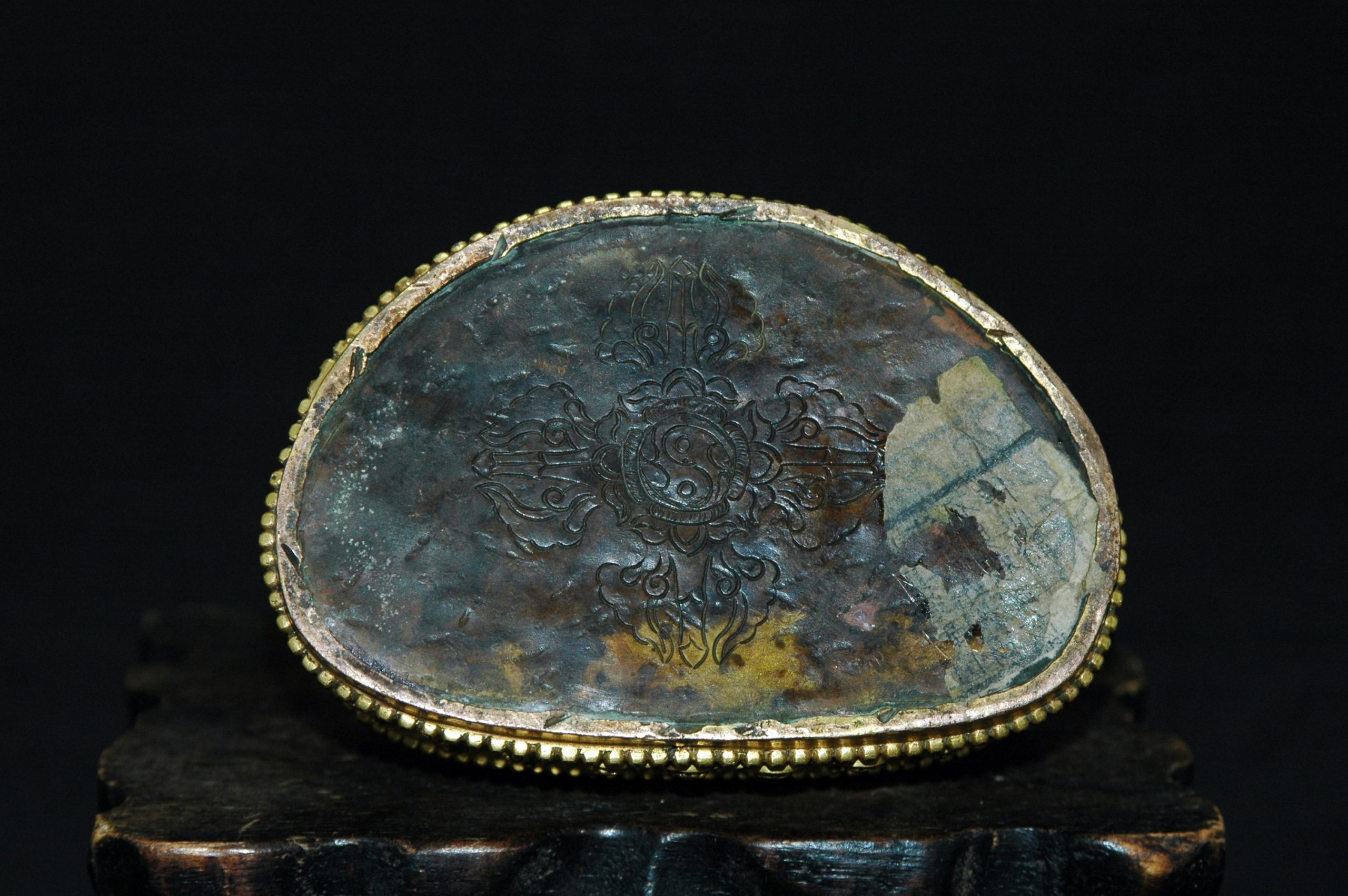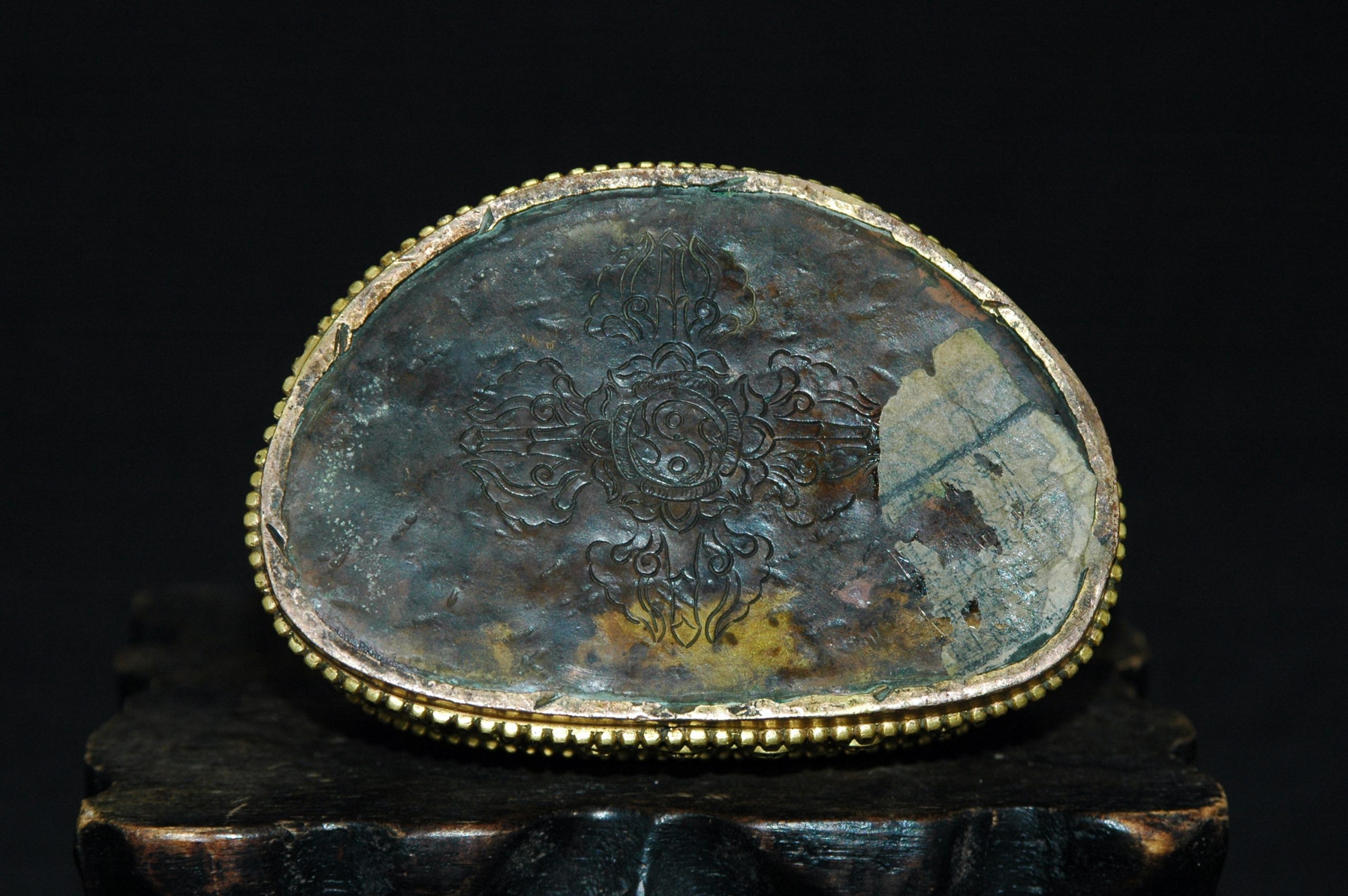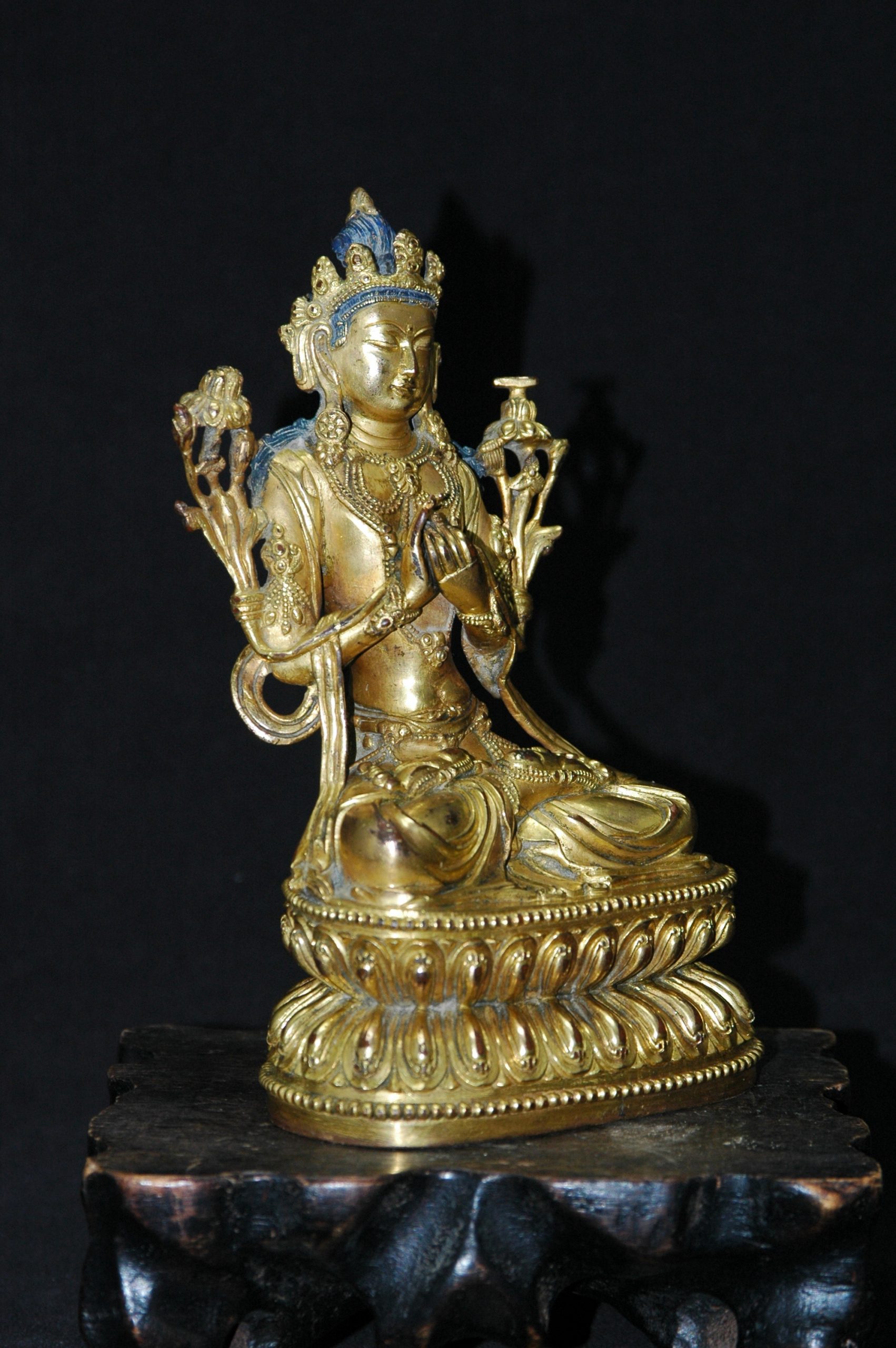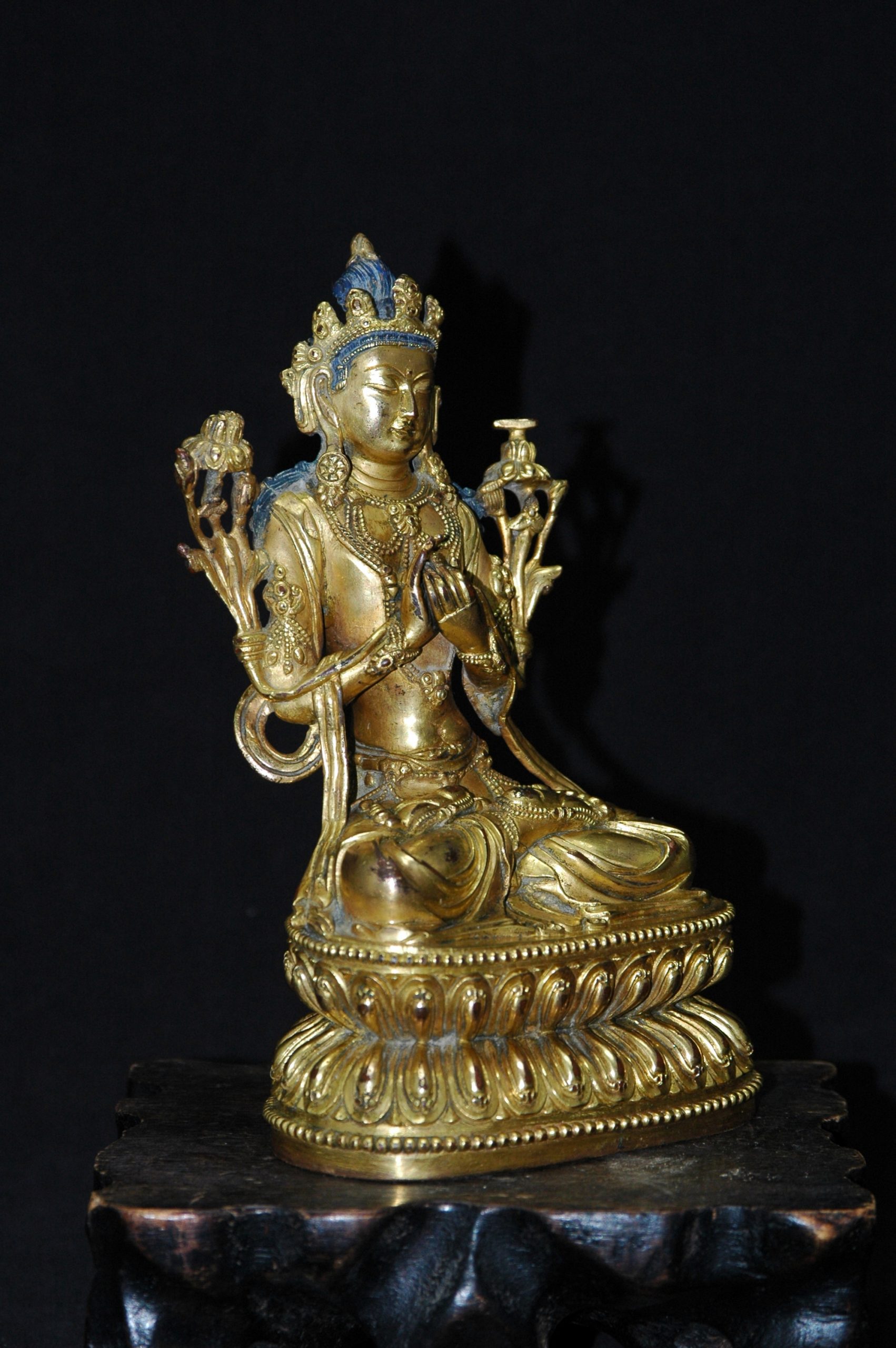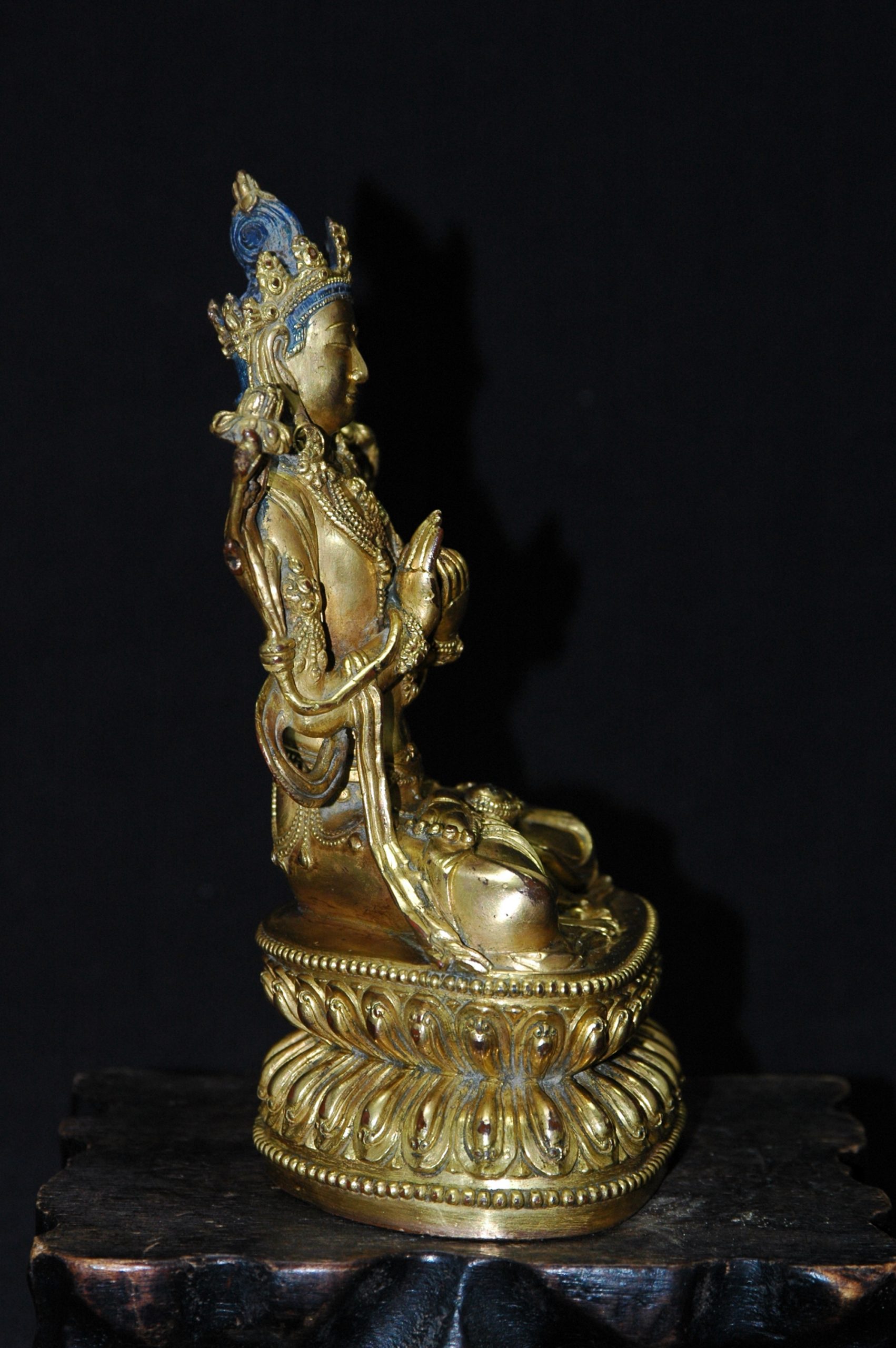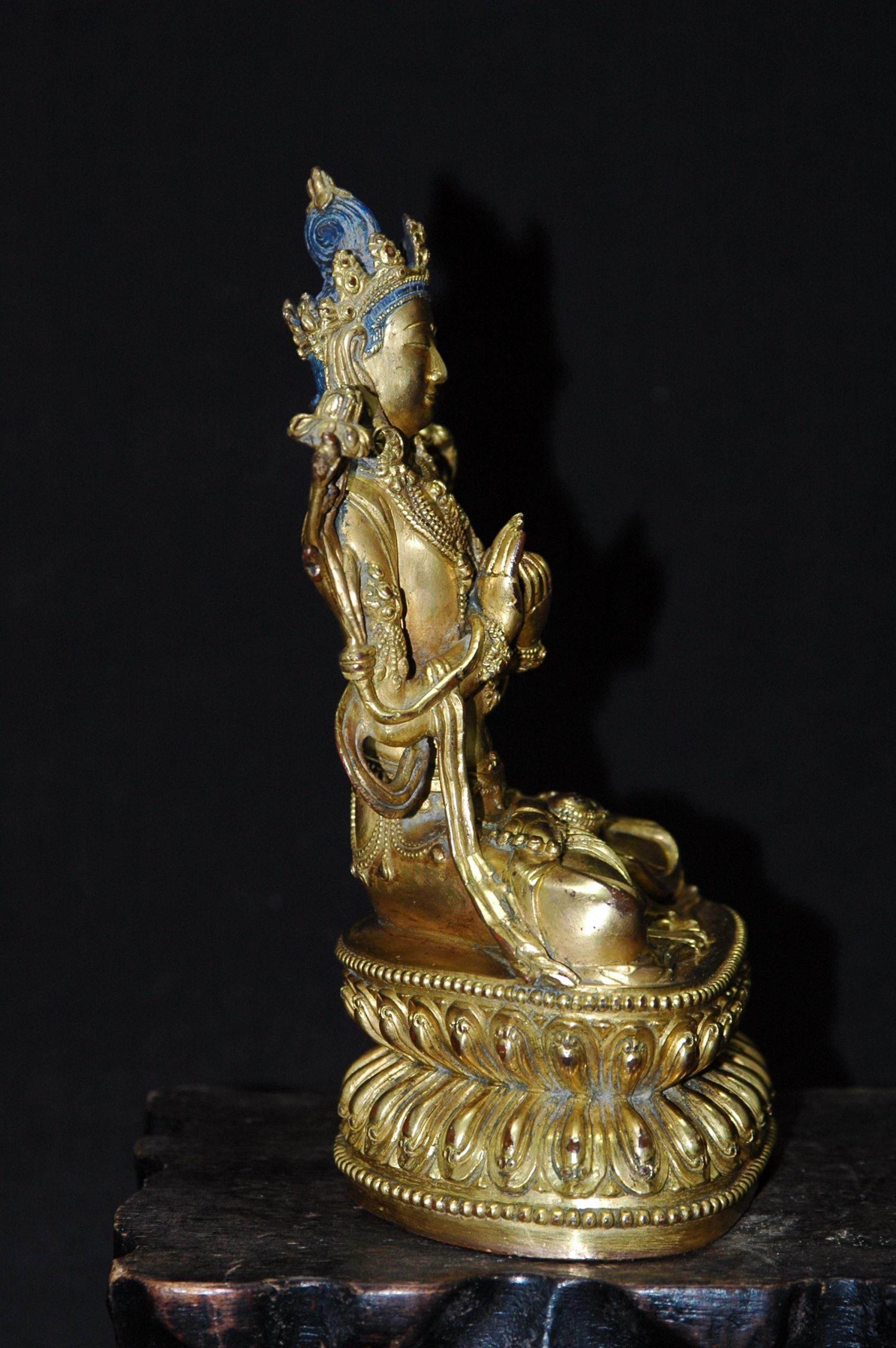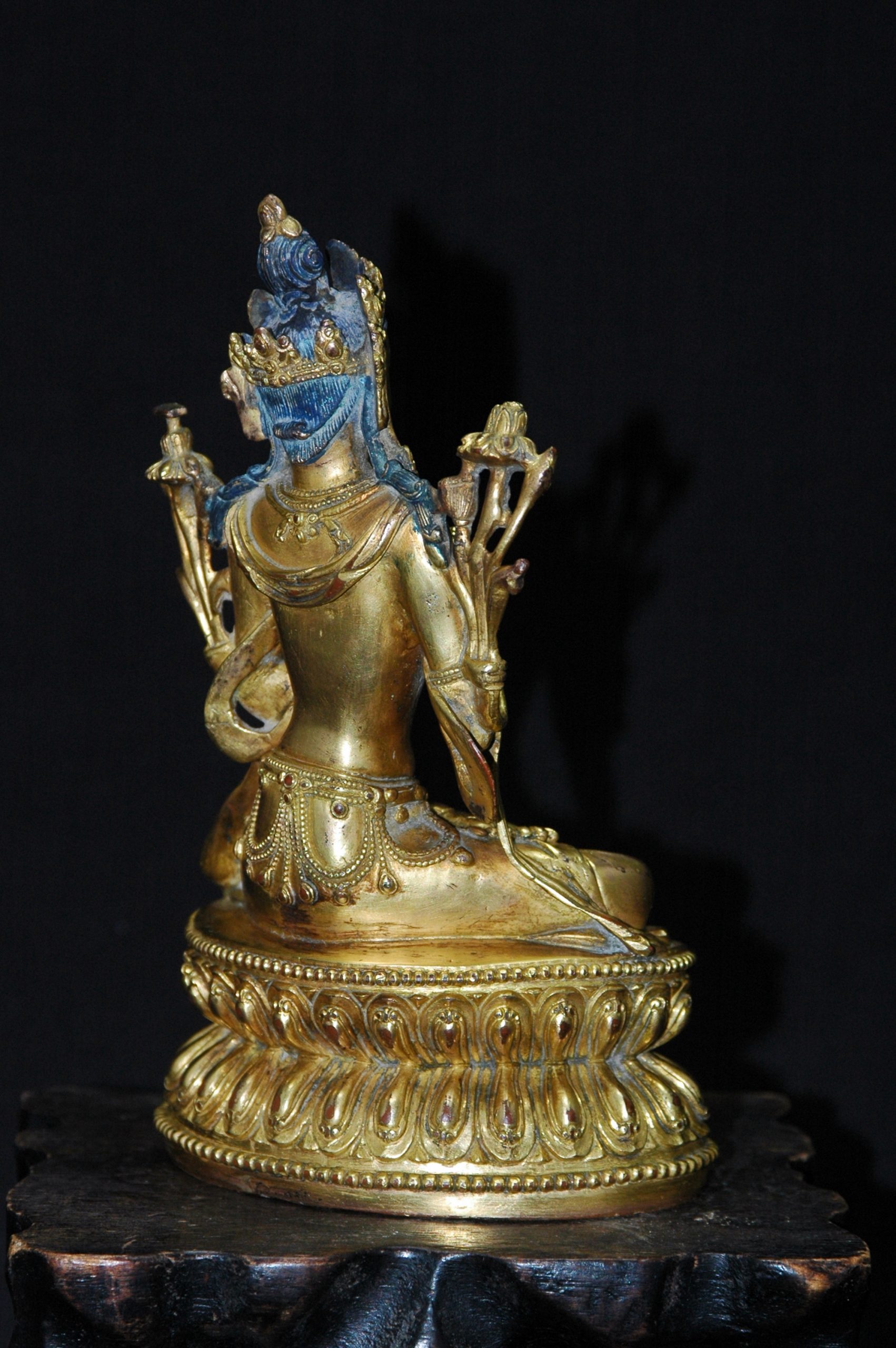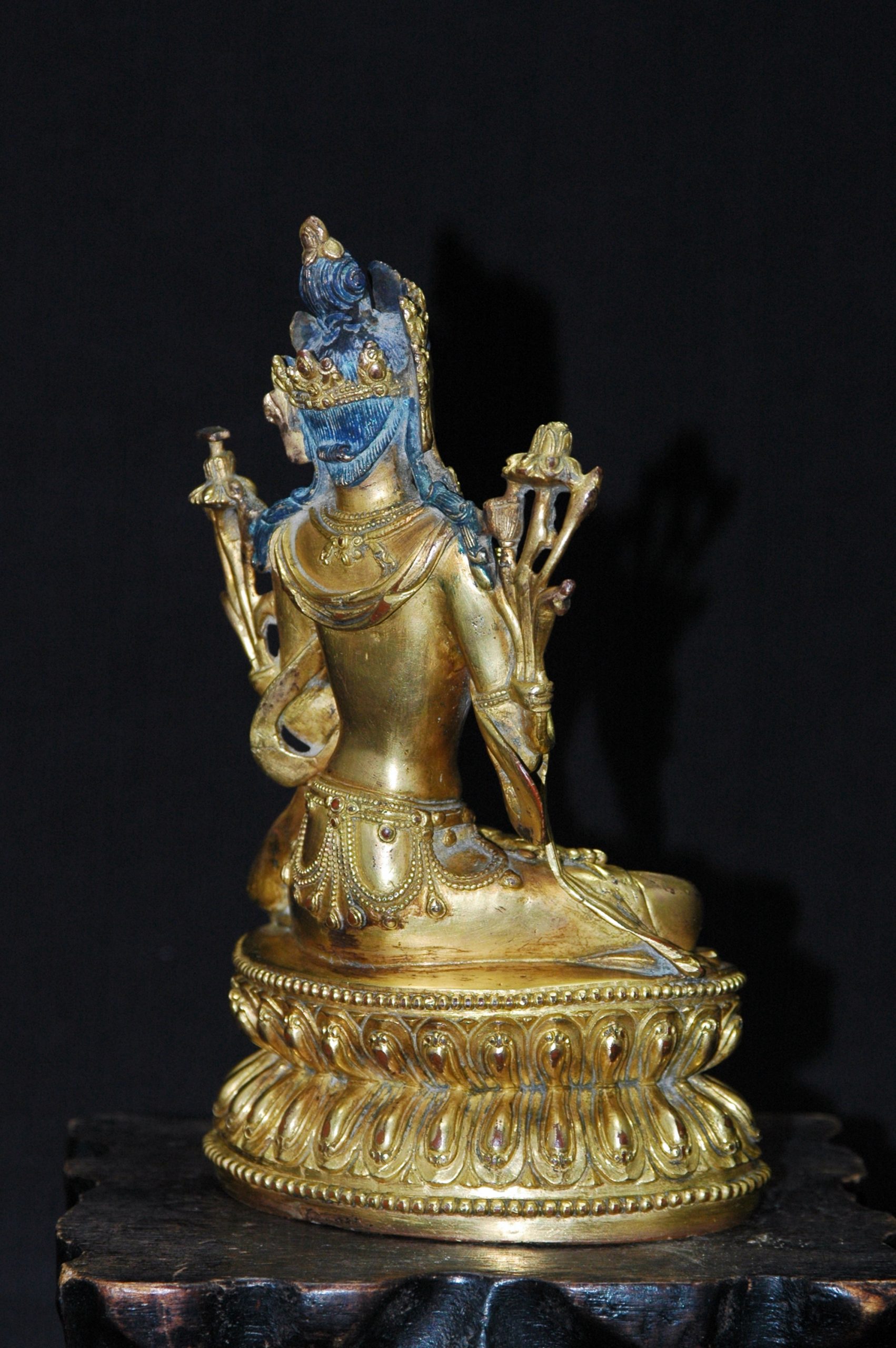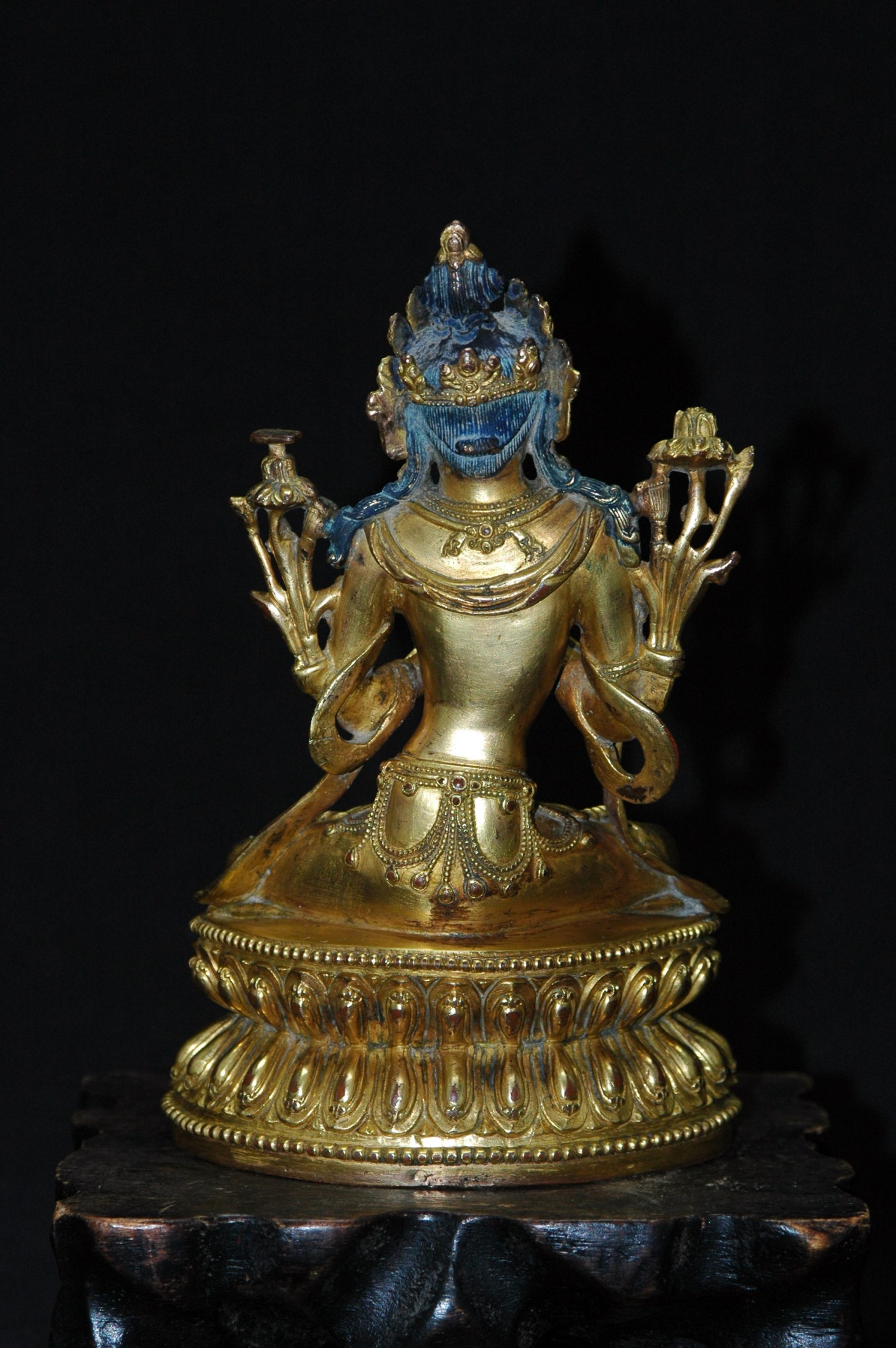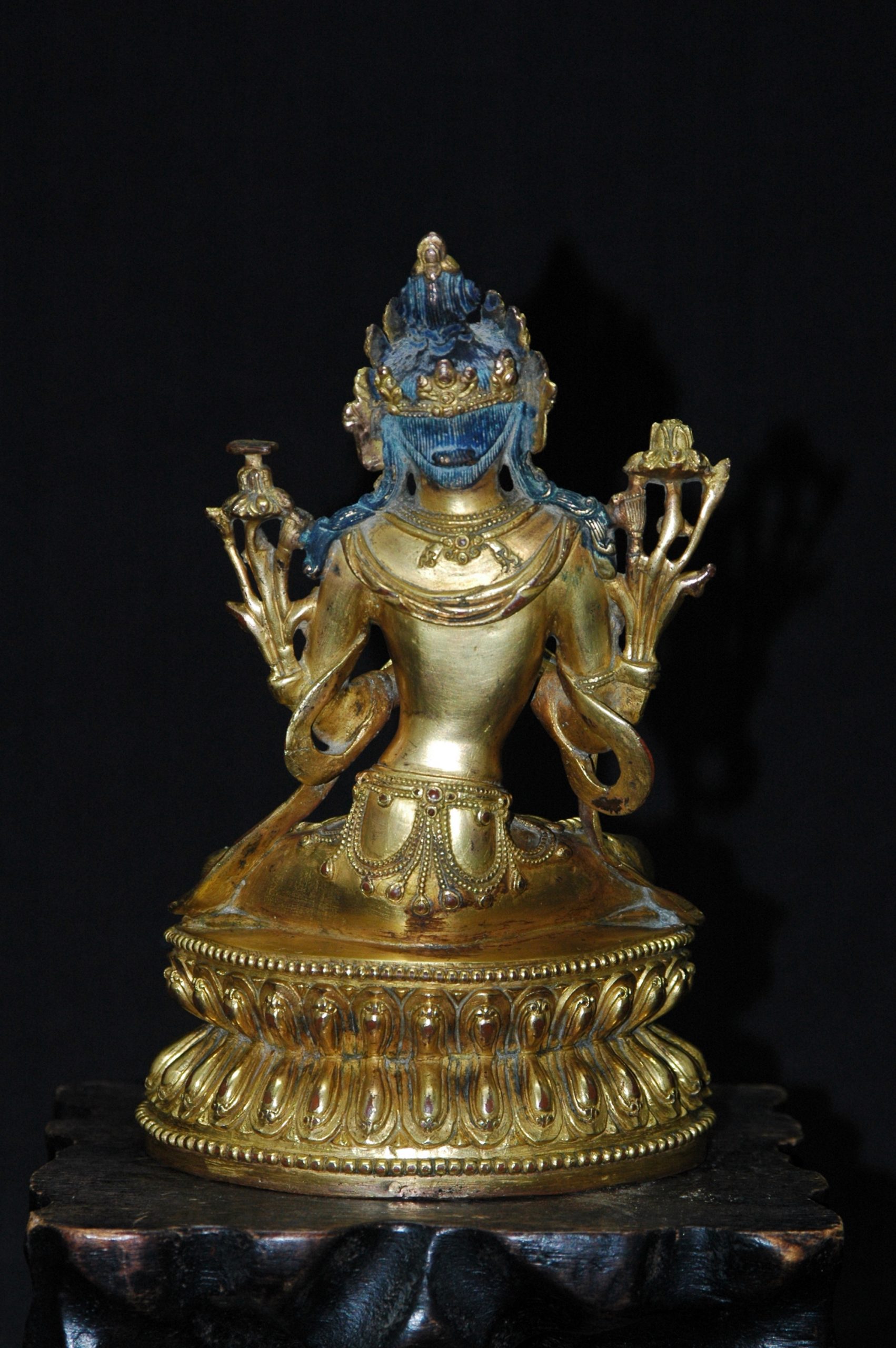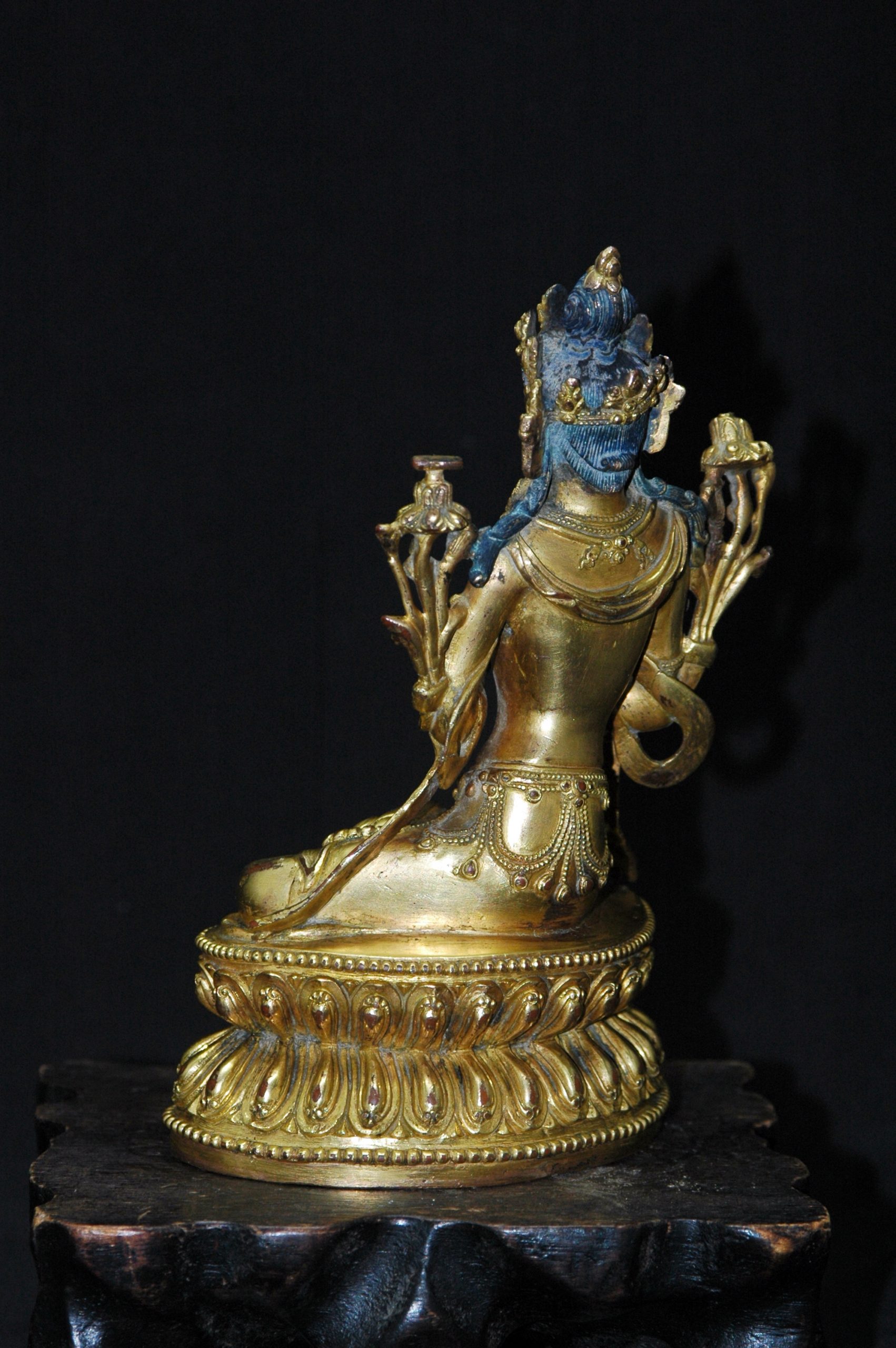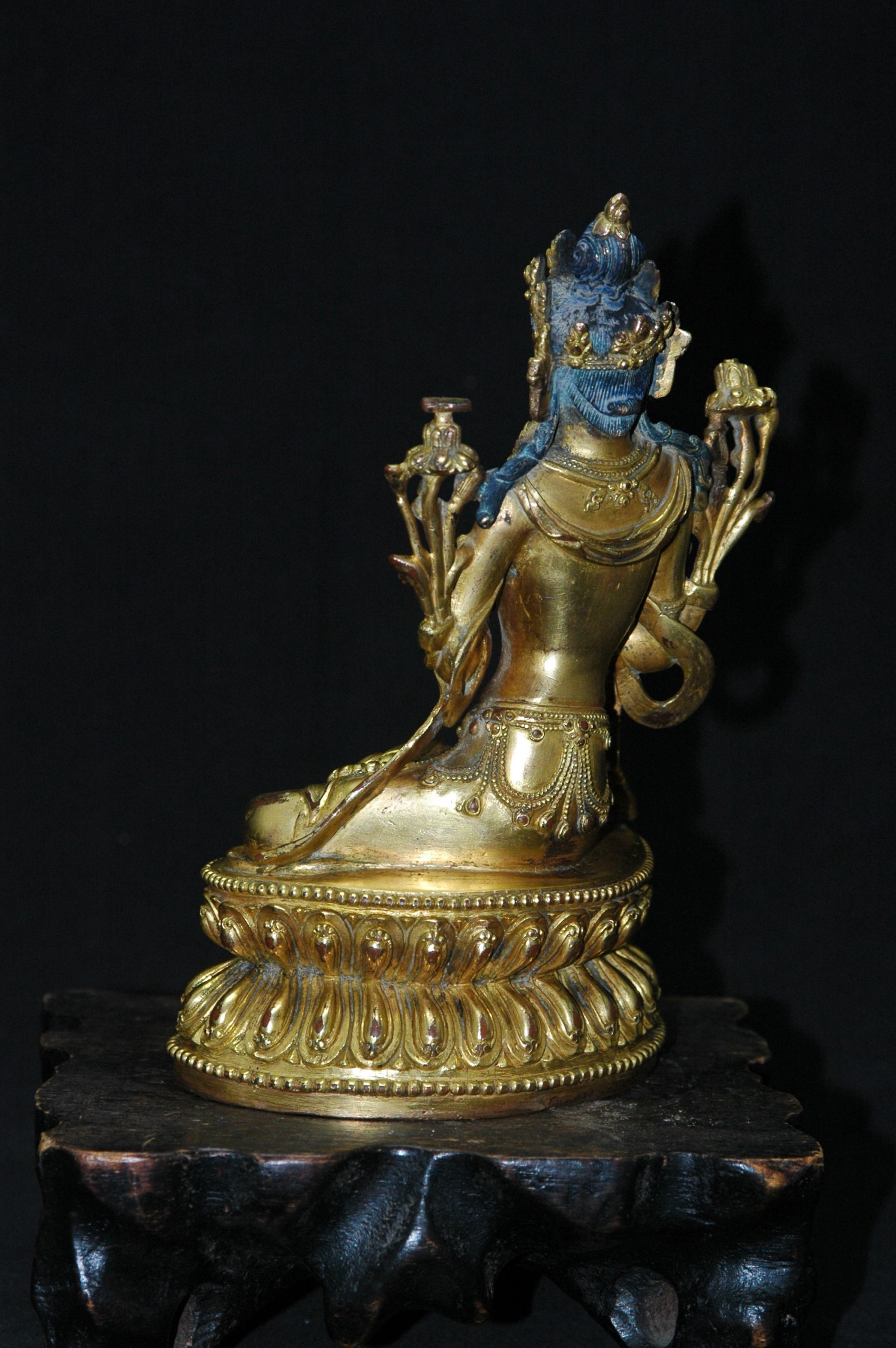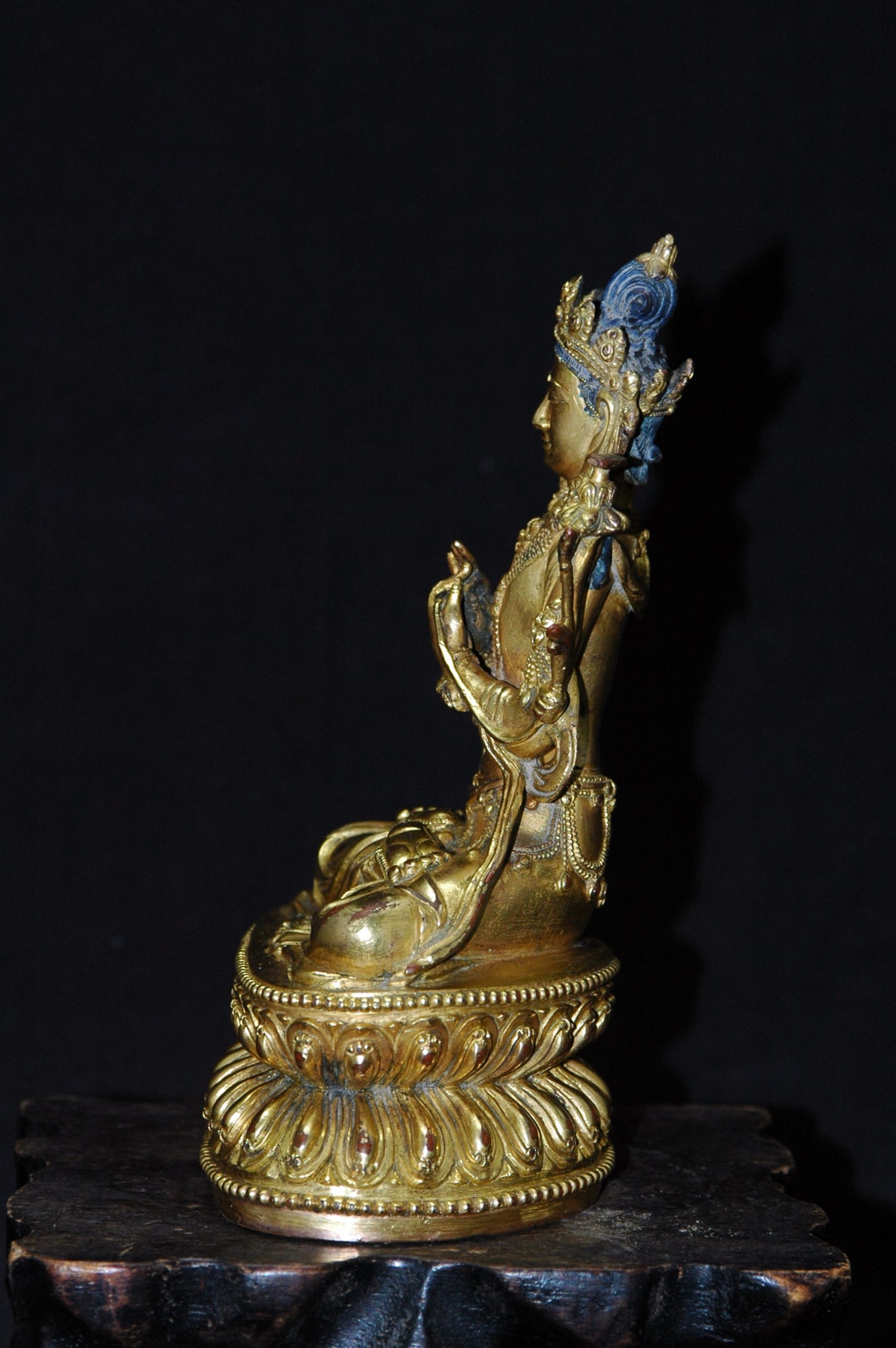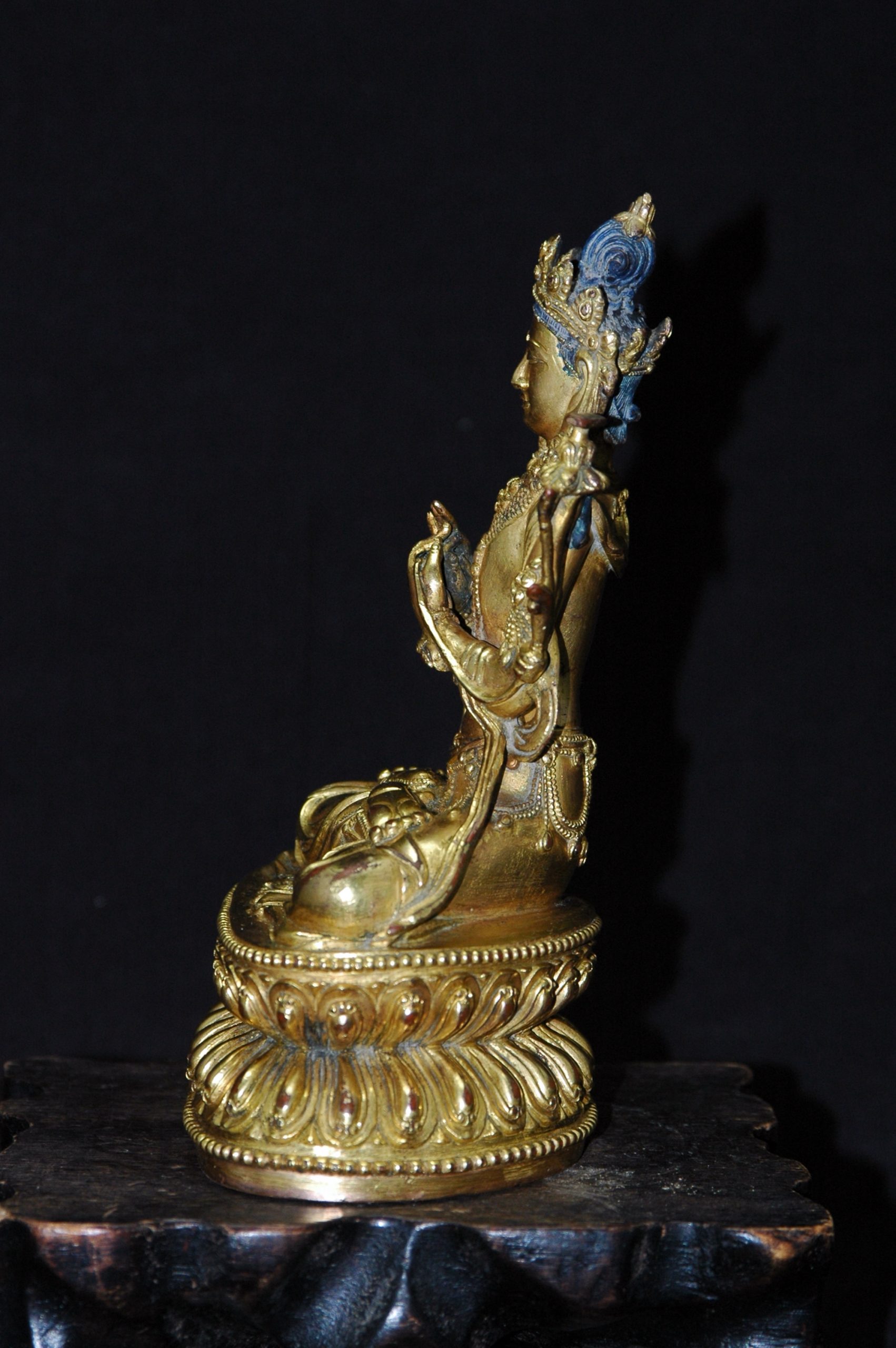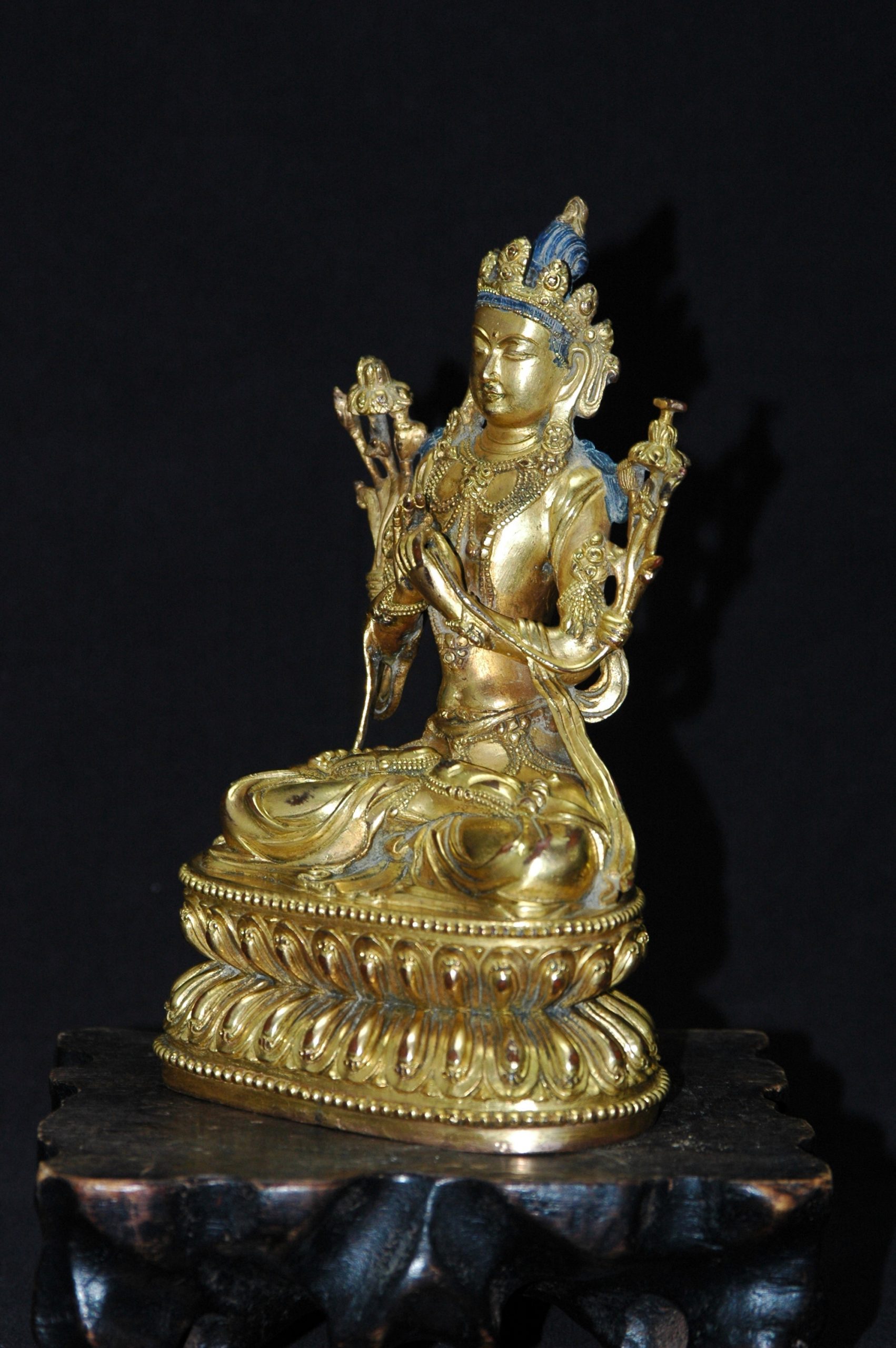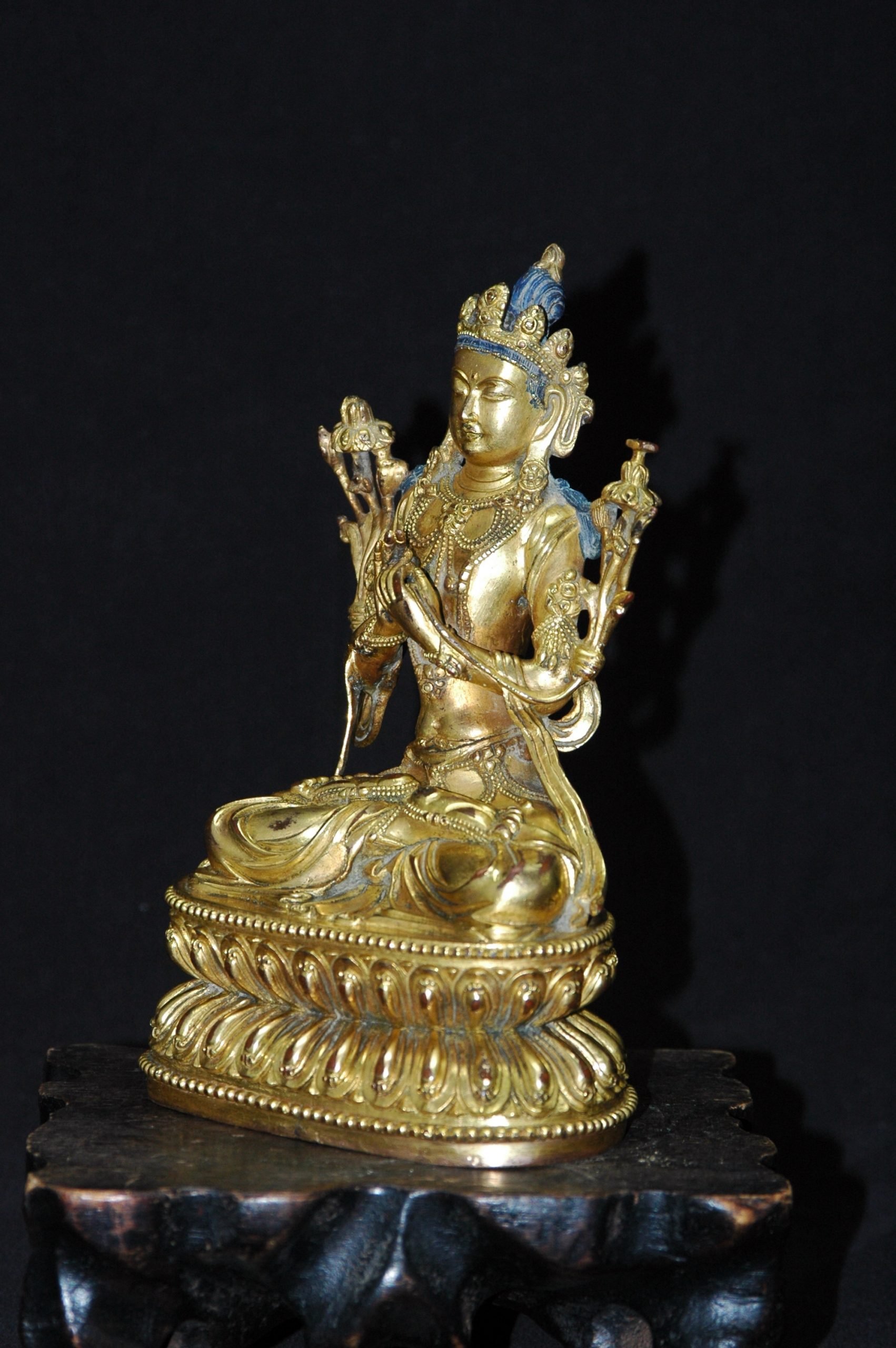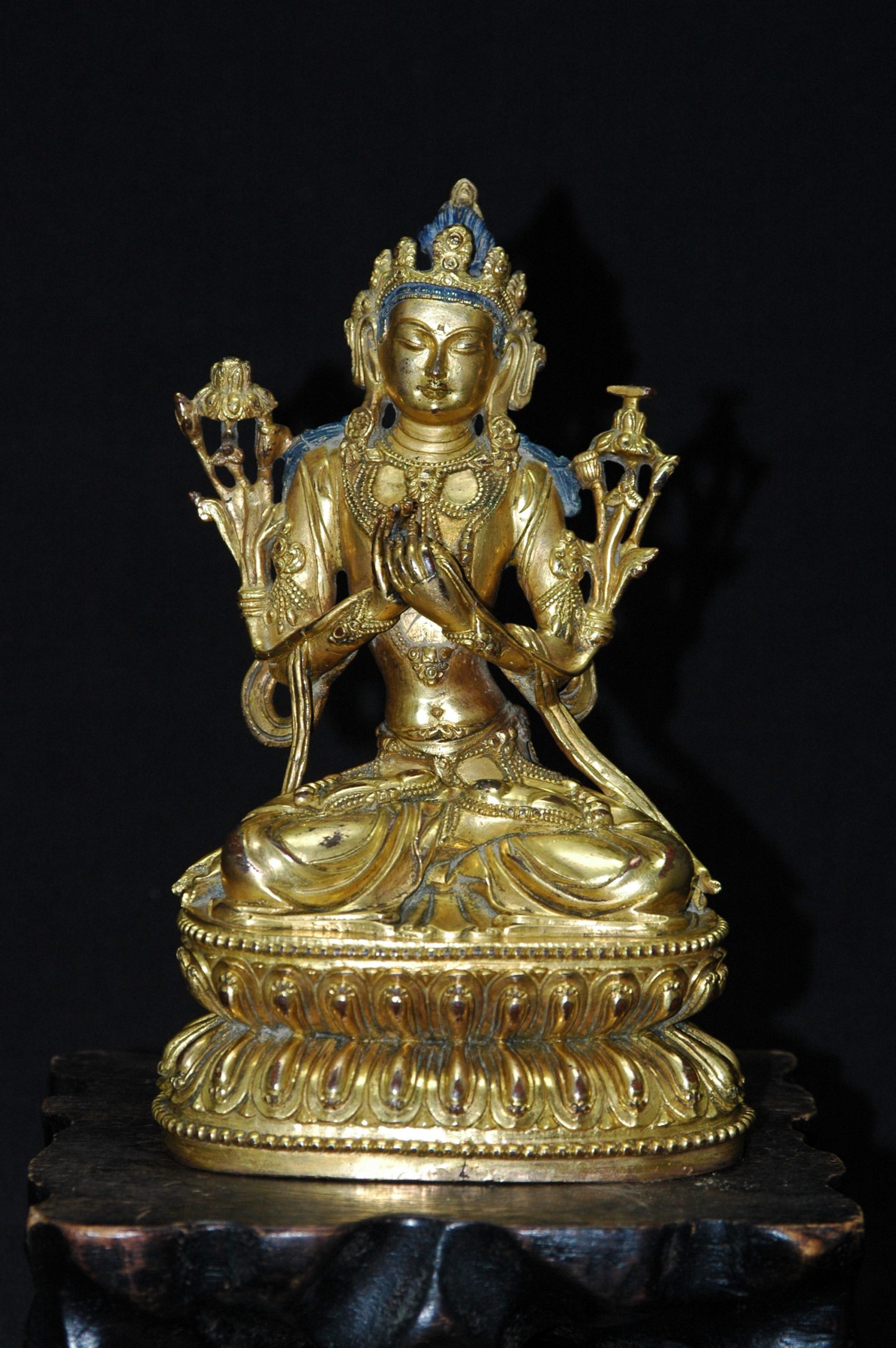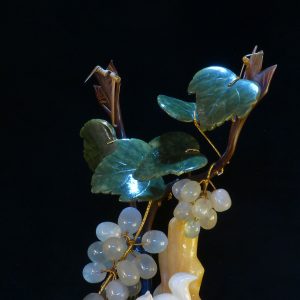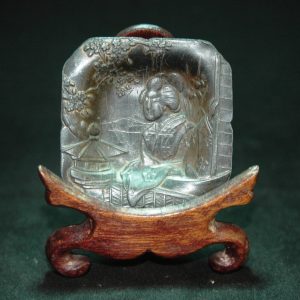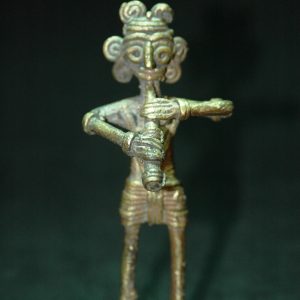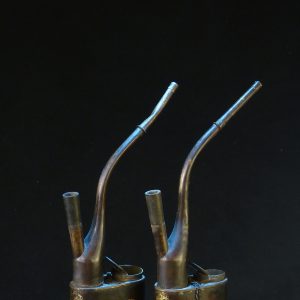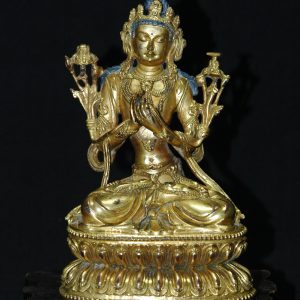Description
明永乐 铜鎏金文殊菩萨
镇院之宝:北京故宫博物院 銅鎏金文殊菩萨坐像
故宫文物编号:故00000156
底账名称:大德九年銅鍍金菩薩(對)
文物级别:一级乙
文物来源:清宫旧藏
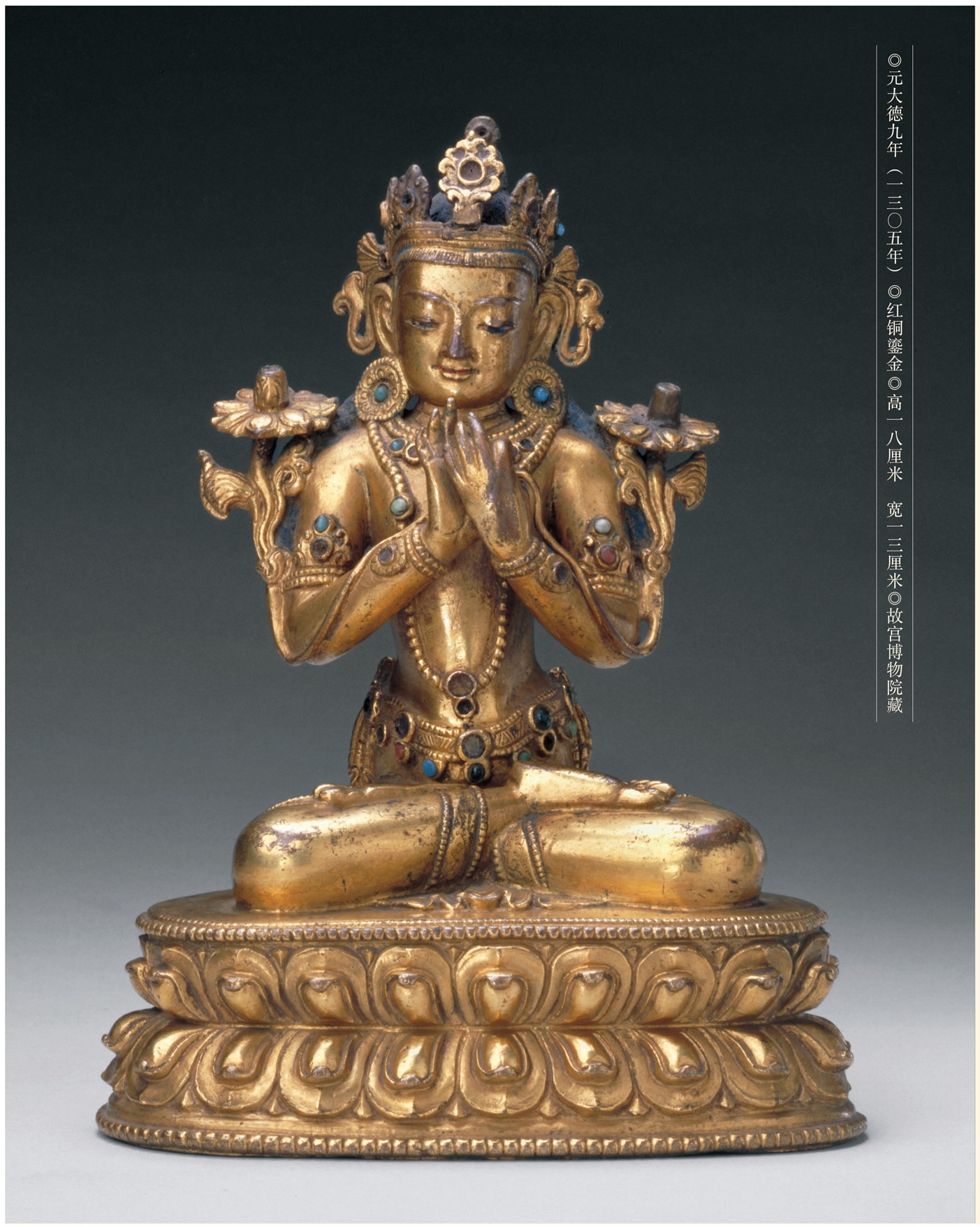
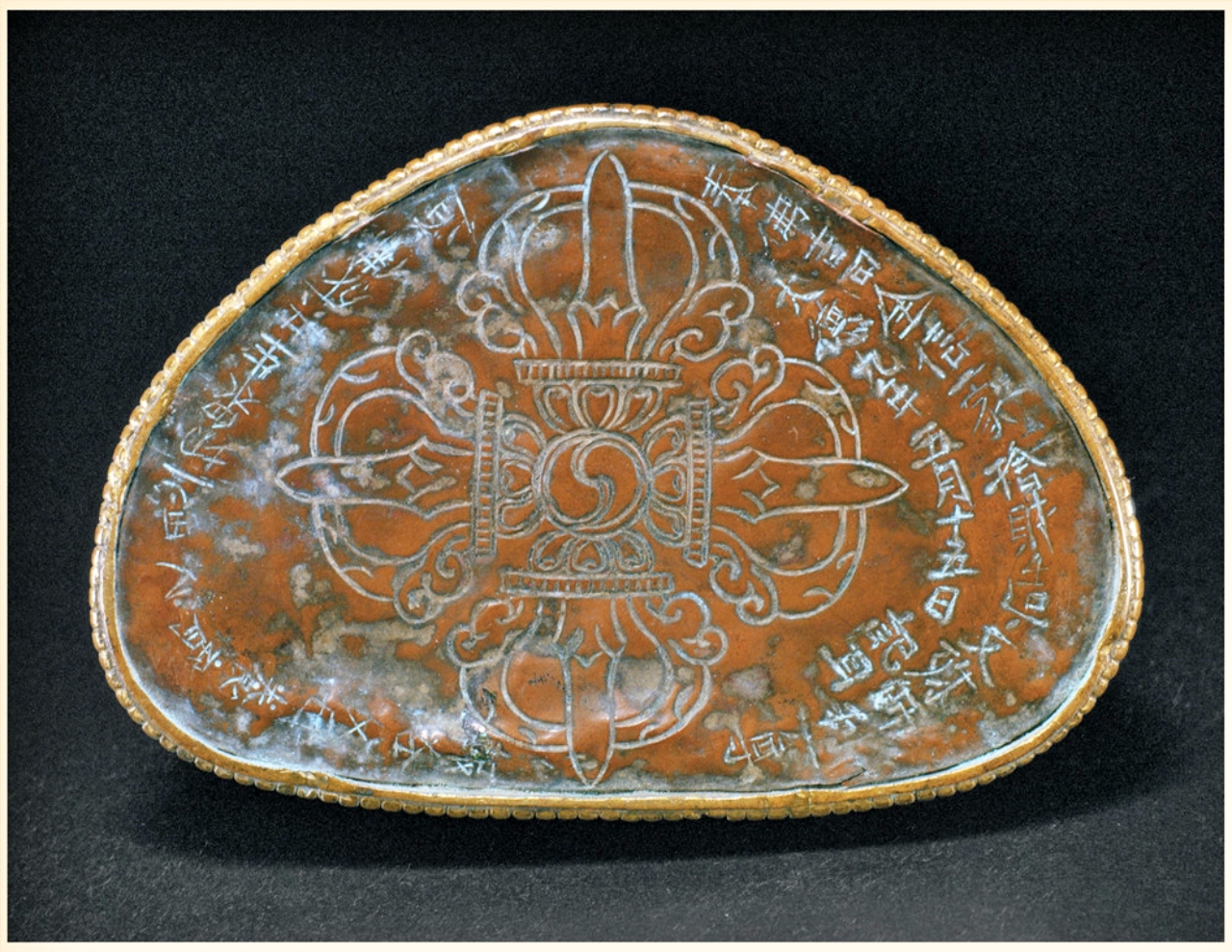
此尊文殊菩萨发髻高挽,头戴五叶宝冠,耳戴典型的尼泊尔式圆花型大耳珰,宝缯结成扇形,尾端卷起上飘。方面广额,头微向左倾,下颌略收,双目微睁,神情怡然。双手于胸前结说法印,牵莲茎,莲花开敷于两肩,其上原有「身份」标识已丢失,应分別置智慧剑与经书。祖上身,佩戴大连珠串成的项链,臂钏饰花形装饰戴在靠近手肘的位置,嵌珊瑚、松石等饰物,腰间系腰带,下身着贴身长裙,结全跏趺坐于東腰仰俯莲座上。座上下沿饰连珠纹,莲瓣宽大肥厚,封底刻十字交杵纹样,外围转圈刻发愿文: 「奉佛吉日全信一家舍财造文殊师利一尊,报答父母养育之恩。一切众生,共成佛道。大德九年五月十五日记耳。」
该造像的原参考号为「薑二五六 11/36」,显示其应为清官瓷库旧藏。核对《故宫 物品点查报告·第五编·第二册》卷五「瓷库」(諸室善后委员会刊行)第八页,覆二五六号文物对应名称是「铜佛三十三尊」,此像为其中的第十一件物品。但《故宮物品点查报告》计件数为三十三有误,实为三十六件。
中统元年(一二六八年),元世祖忽必烈奉萨迦派祖师八思巴为国师,由此藏传佛教正式进入宫廷并广泛在内地传播。元代宫廷还专门设立 「梵相提举司」负责造像,尼泊尔艺术家阿尼哥曾在此任职,并培养了一批内地成长的造像工匠,由此开启了元代汉藏艺术的融合。此尊造像具有元代藏传佛教造像典型的尼泊尔风格,同时又可见汉地艺术的影响。菩萨面相年轻,身体强健,四肢粗壮,肌肉饱满,亮泽的鎏金表现出肌肤的光滑感,彰显出蓬勃的活力,身体曲线柔和,装饰华丽多使用镶嵌,体现出对称而规整的装饰感,反映出尼泊尔的造像特征。方正的脸型,强调平静柔美的神态,则反映出汉地艺术审美的影响。此尊造像作为罕见的有确切纪年的元代造像,为造像艺术史研究提供了断代标尺,更是汉、藏民族文化融合的具体表现,兼具艺术价值和研究价值。元代藏传佛教造像虽最初 以尼泊尔造像为蓝本,但在不断发展中形成了汉藏融合艺术风格特点,其艺术审美对明代永乐、宣德时期藏传佛教造像艺术风格的形成有着较为深 刻的影响。
故宫博物院专家杨伯达、步连生、唐兰三位先生的鉴定意见为:「形象生动,是元代小型密宗造像中罕见作品,是研究元代密宗造像特点及研究元、明、清王朝密宗佛像发展关系的重要资料,定为一级乙。」
参考:佳士得
2 11月 2020 | 現場拍賣 18883
重要中國藝術精品
拍品 71
A GILT-BRONZE FIGURE OF MANJUSRI
重要歐洲私人珍藏
明 鎏金銅文殊菩薩坐像
MING DYNASTY (1368-1644)
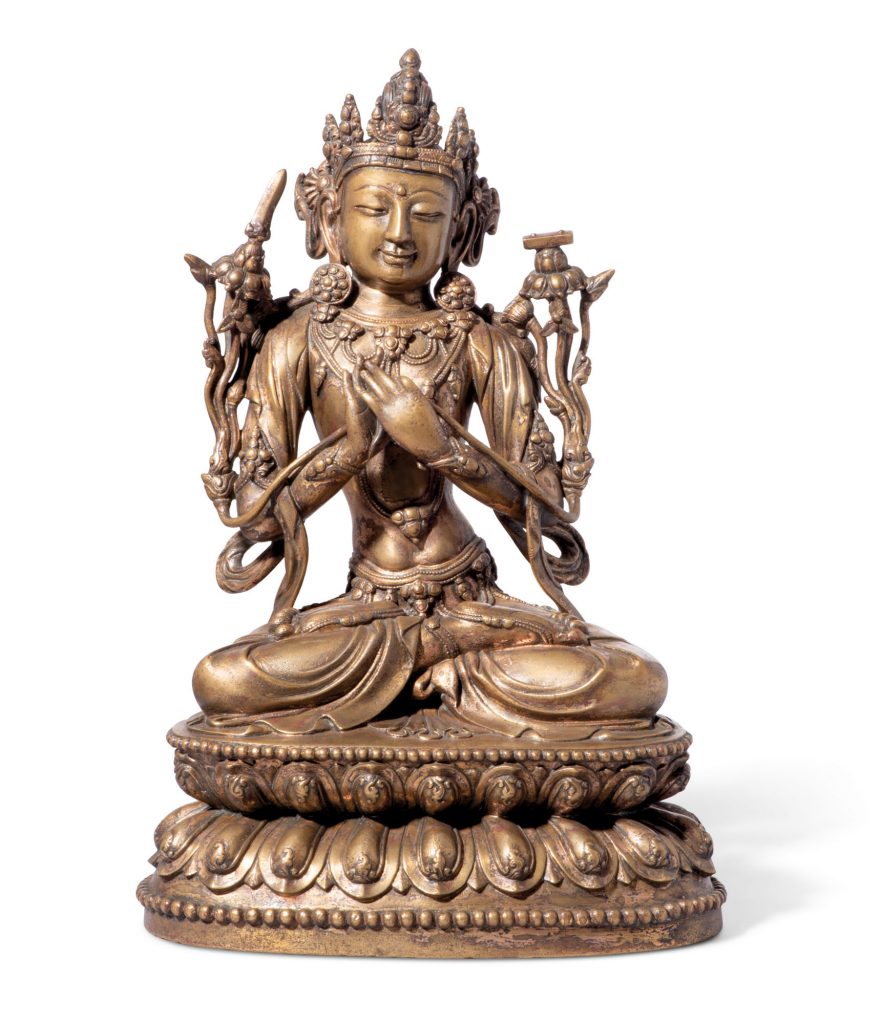
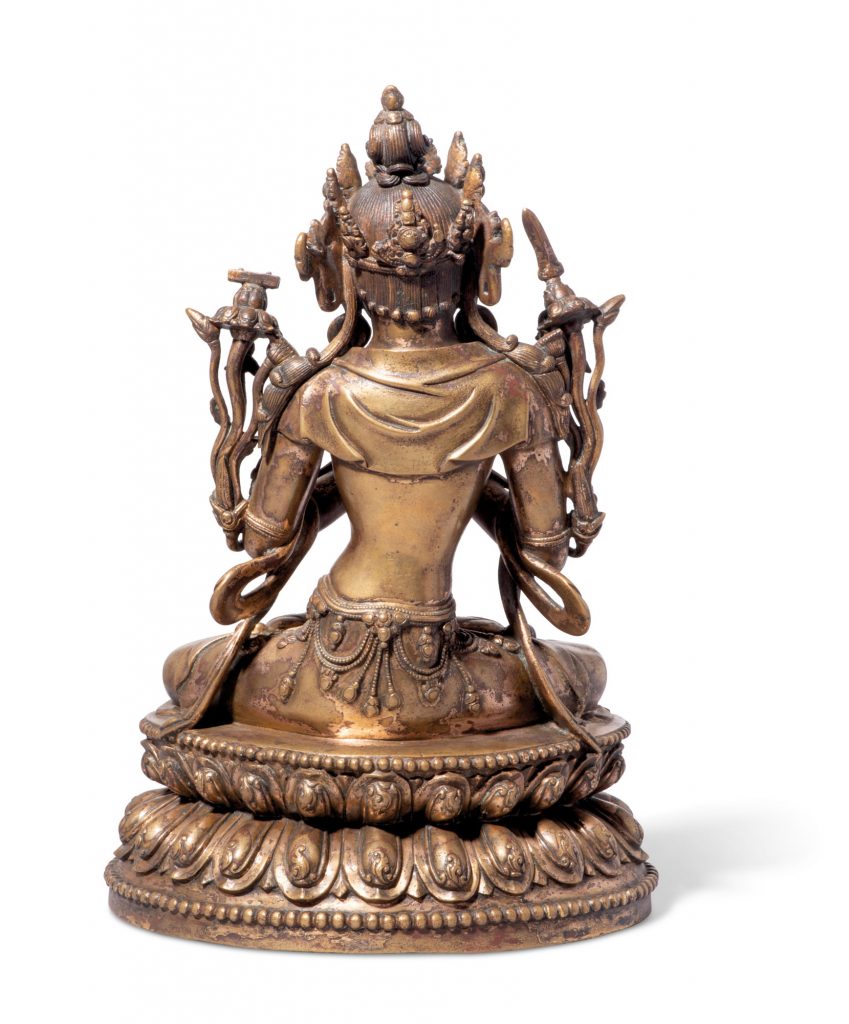
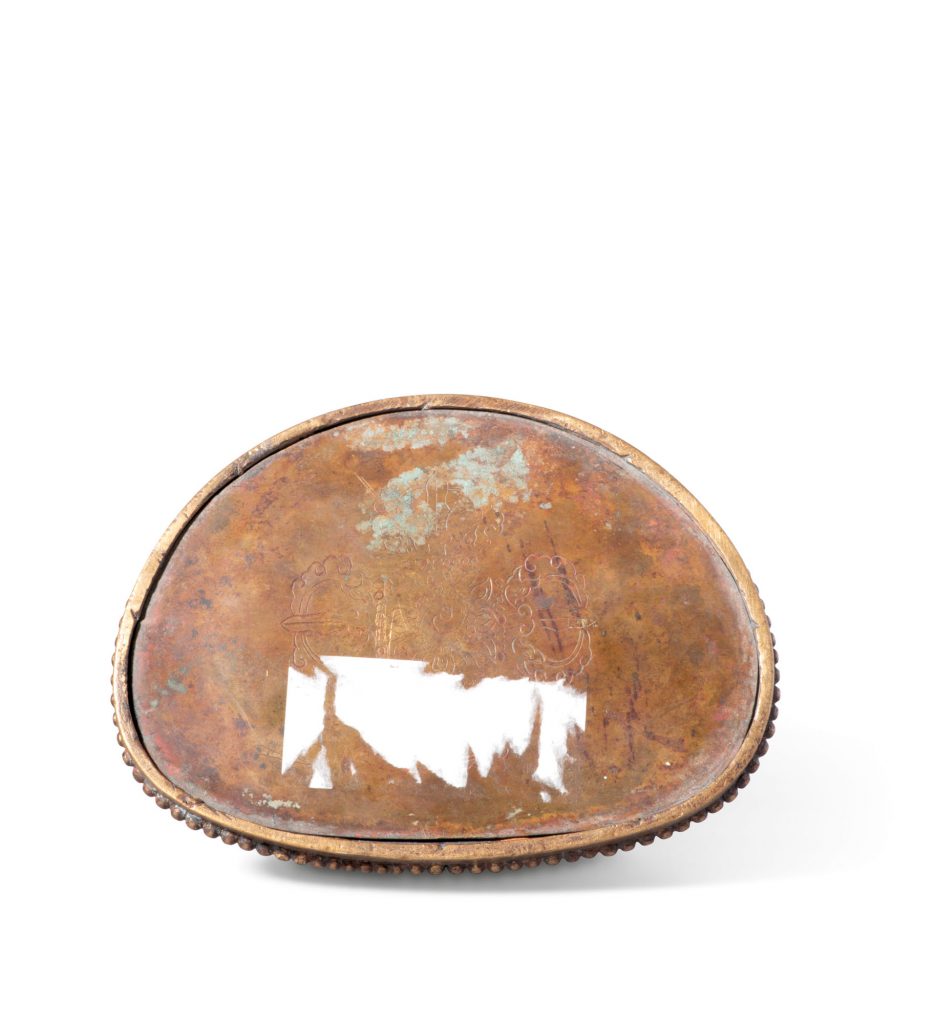
成交價 GBP 50,000
估價 GBP 30,000 – GBP 50,000
明 鎏金銅文殊菩薩坐像
MING DYNASTY (1368-1644)
細節
明 鎏金銅文殊菩薩坐像
10 in. (25 cm.) high
來源
於1989年前購自德國
狀況報告
此品相報告中之英文版本若有歧異,概以英文版本為準
佳士得已設法記錄拍品自最初製成至今之品相改變
– 整體品相尚佳,僅有年代久遠所致的一般表面磨損,包括鎏金上的擦痕及足上的微磕/細磕。
参考:佳士得
19 3月 2014 | 现场拍卖 3484
般若妙相:虔诚信仰艺术精品
拍品 1622
A RARE AND SUPERBLY CAST GILT-BRONZE FIGURE OF AVALOKITESHVARA
Property from a Private American Collection
明永乐 铜鎏金观音坐像 「大明永乐年施」单行刻款
CHINA, MING DYNASTY, YONGLE SIX-CHARACTER MARK INSCRIBED IN A LINE AND OF THE PERIOD (1403-1425)
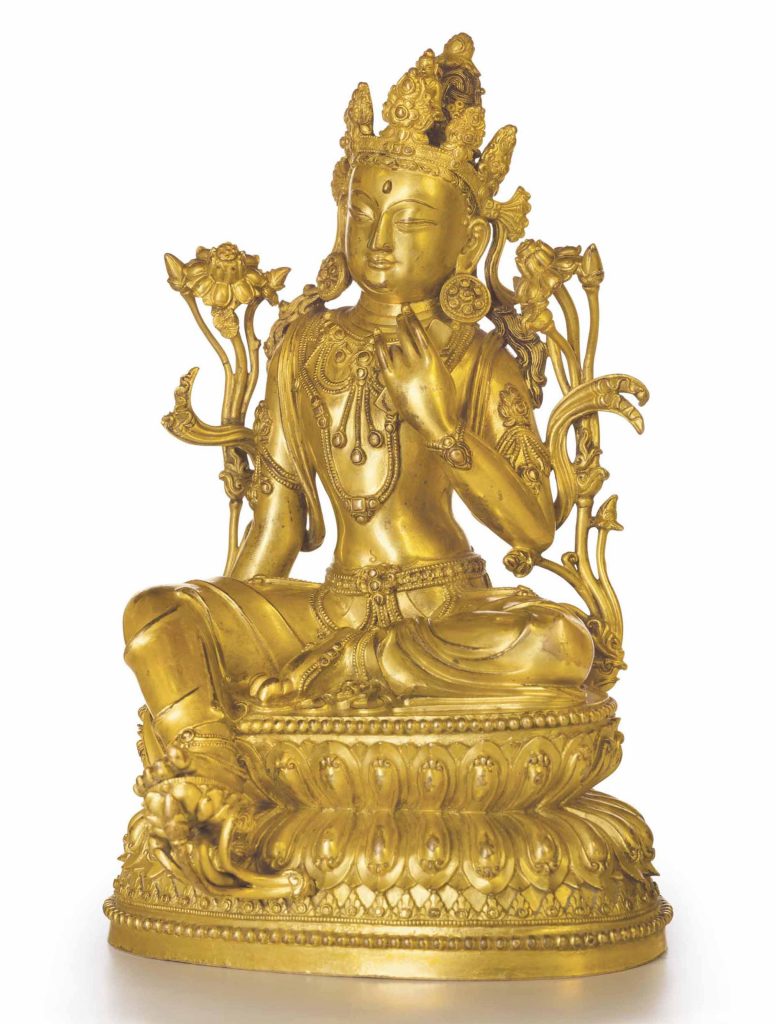
成交价 USD 2,629,000
估价 USD 600,000 – USD 800,000
明永乐 铜鎏金观音坐像 「大明永乐年施」单行刻款
CHINA, MING DYNASTY, YONGLE SIX-CHARACTER MARK INSCRIBED IN A LINE AND OF THE PERIOD (1403-1425)
来源
Christie’s New York, 21 March 2001, lot 88.
拍品专文
This exquisite sculpture represents Avalokiteshvara (Chinese, Guanyin), the bodhisattva of compassion, as indicated by the presence in the headdress of a small seated image of the Amitabha Buddha (Chinese, Emituofo), the Buddha of Infinite Light, who presides over the Western Paradise. Considered a spiritual emanation of Amitabha, Avalokiteshvara is the only bodhisattva in whose crown or headdress Amitabha appears; thus, Amitabha’s presence there definitively identifies this figure as Avalokiteshvara. Though Avalokiteshvara appears in many different forms, or manifestations, all show an image of Amitabha in the crown. Avalokiteshvara is sometimes also called Padmapani (“Holder of the Lotus”) or Lokeshvara (“Lord of the World”).
Avalokiteshvara typically holds such iconographic attributes as a lotus blossom, a vase, a ritual kundika vessel for holy water, or is portrayed in association with a willow branch, a Buddhist symbol of both physical and spiritual healing. Apart from those that constitute the base, two lotus blossoms flank the bodhisattva, one at each shoulder. In addition, in this rare sculpture the bodhisattva holds a book in the proper left hand, which Buddhist scriptures note is appropriate for at least three of Avalokiteshvara’s manifestations: Vishnukanta Lokeshvara, Manjunatha Lokeshvara, and Vajrakhanda Lokeshvara. It is possible that this sculpture represents the last-named, Vajrakhanda Lokeshvara. (Jacob N. Kinnard, Imaging Wisdom: Seeing and Knowing in the Art of Indian Buddhism, Oxon, England, and New York, 1999, p. 166, and note 59); and “108 Forms of Avalokitesvara,” Excerpt from Benoytosh Bhattacharyya, The Indian Buddhist Iconography, Appendix, 1958, p. 420, fig. 78(A). Images of Vishnukanta Lokeshvara and Manjunatha Lokeshvara are also illustrated, p. 425, fig. 99(A) and p. 424, fig. 96(A), respectively.
A bodhisattva, or “enlightened being,” is a compassionate being who has gained enlightenment but who has postponed entry into final nirvana in order to assist other sentient beings in gaining enlightenment. Because they will become a Buddha, once all other sentient beings have attained enlightenment, a bodhisattva is portrayed in the guise of an Indian prince, which the Historical Buddha was before he became the Buddha – that is, in his early life. Gautama Siddhartha (traditionally, 563-483 BCE) was the crown prince of a small state in the foothills of the Himalayas, but then he rejected worldly life, renounced all claim to his inheritance and to his father’s throne, espoused the religious life, gained enlightenment and became the Buddha Shakyamuni. Thus, as did the Buddha in his youth, a bodhisattva wears a dhoti around the waist, hips and legs and a scarf over the shoulders and around the arms, and is adorned with a wealth of jewelry, from necklaces and earrings to bracelets, armlets and anklets, as does this magnificent figure of Avalokiteshvara. The long hair typically is arranged in a high chignon on top of the head, the crown encircling the chignon a reference to the Historical Buddha’s princely status in his youth.
The Lotus Sutra (Sanskrit, Saddharma Pundarika Sutra) is the scriptural basis for teaching the doctrines of Avalokiteshvara. Chapter 25 of that sutra, which is devoted solely to Avalokiteshvara and sometimes stands alone as the Avalokiteshvara Sutra, presents the bodhisattva as a compassionate being who hears the cries of sentient beings and who works ceaselessly to help those who call upon his name.
Although Tibetan Buddhist imagery began to appear in the repertory of Chinese art by the Yuan dynasty (1279-1368), Tibetan influence on Chinese Buddhist art became far more pronounced in the Ming dynasty (1368-1644), particularly during the Yongle era (1403-1425), when the imperial court looked favorably upon Buddhism and made a concerted effort to build secular and religious alliances with Tibet, even inviting Tibetan monks to the capital, Beijing, to conduct religious services. Such Tibetan influence manifests itself in the sensuousness of the art, witnessed in this figure’s elegant proportions, S-curved posture, dazzling jewels, refined gestures, abundant and meticulously rendered details and compressed double-lotus base. As important as Tibetan-influenced works of art were early in fifteenth-century China, particularly in the Yongle and Xuande (1425-1435) reigns, Tibetan-style Buddhism probably was little practiced outside the imperial court, so most such images likely were made for the court, as indicated by the imperial inscriptions.
A stylistically similar Avalokiteshvara, which also has a Yongle reign mark, and is shown seated in a similar position with one foot supported by a lotus “growing” from the base, is in the Museum Reitberg, Zurich, and illustrated by Helmut Uhlig in On the Path to Enlightenment, Zurich, 1995, pp. 98-99, no. 52. (fig. 1)
参考:佳士得
拍賣 3371
重要中國瓷器及工藝精品
Hong Kong, HKCEC Grand Hall|2014年11月26日
拍品3106|明永樂 銅鎏金文殊菩薩坐像 《大明永樂年施》款
THE PROPERTY OF AN ASIAN COLLECTOR
AN EXTREMELY RARE GILT-BRONZE FIGURE OF MANJUSRI
YONGLE INCISED SIX-CHARACTER PRESENTATION MARK AND OF THE PERIOD (1402-1424)
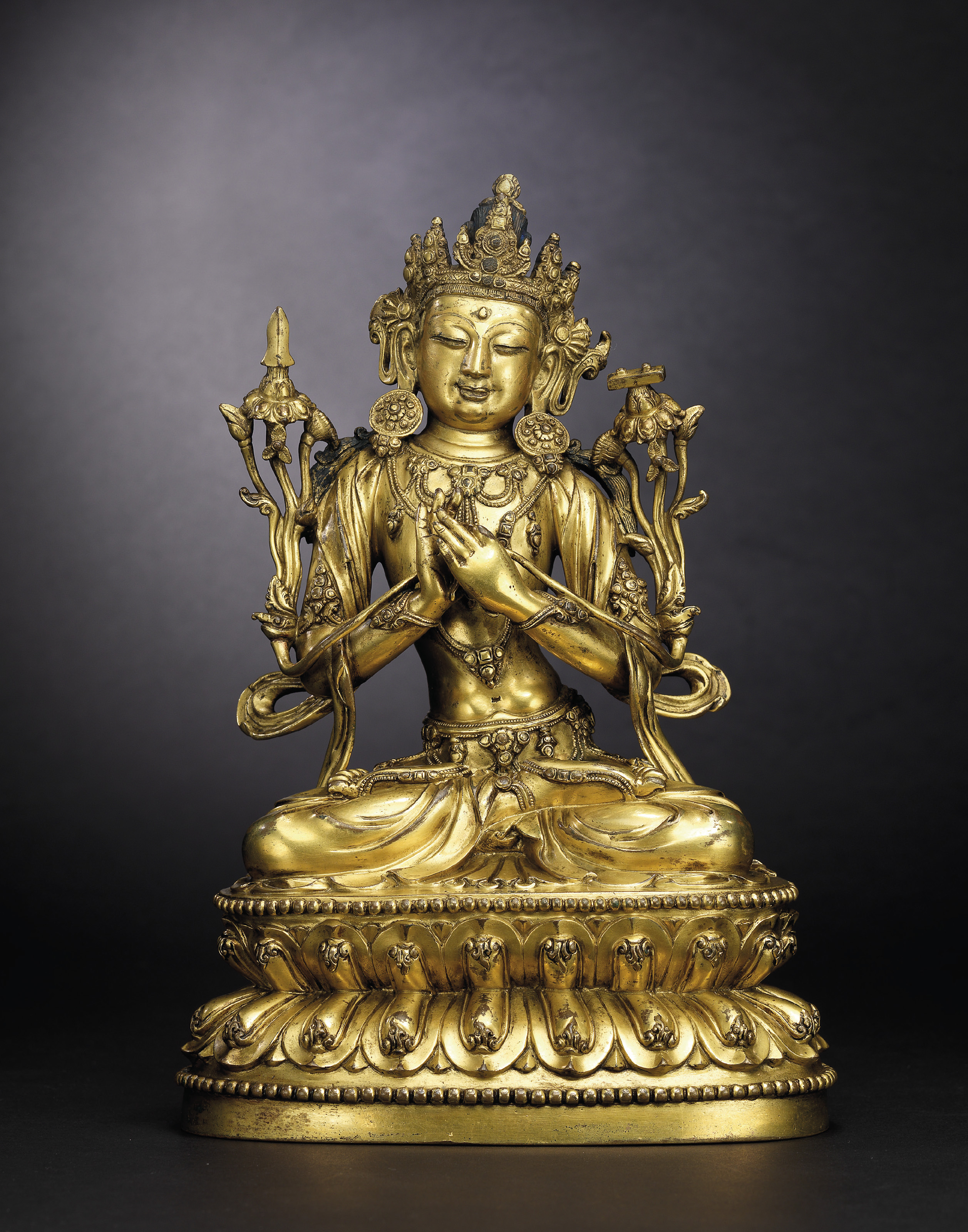
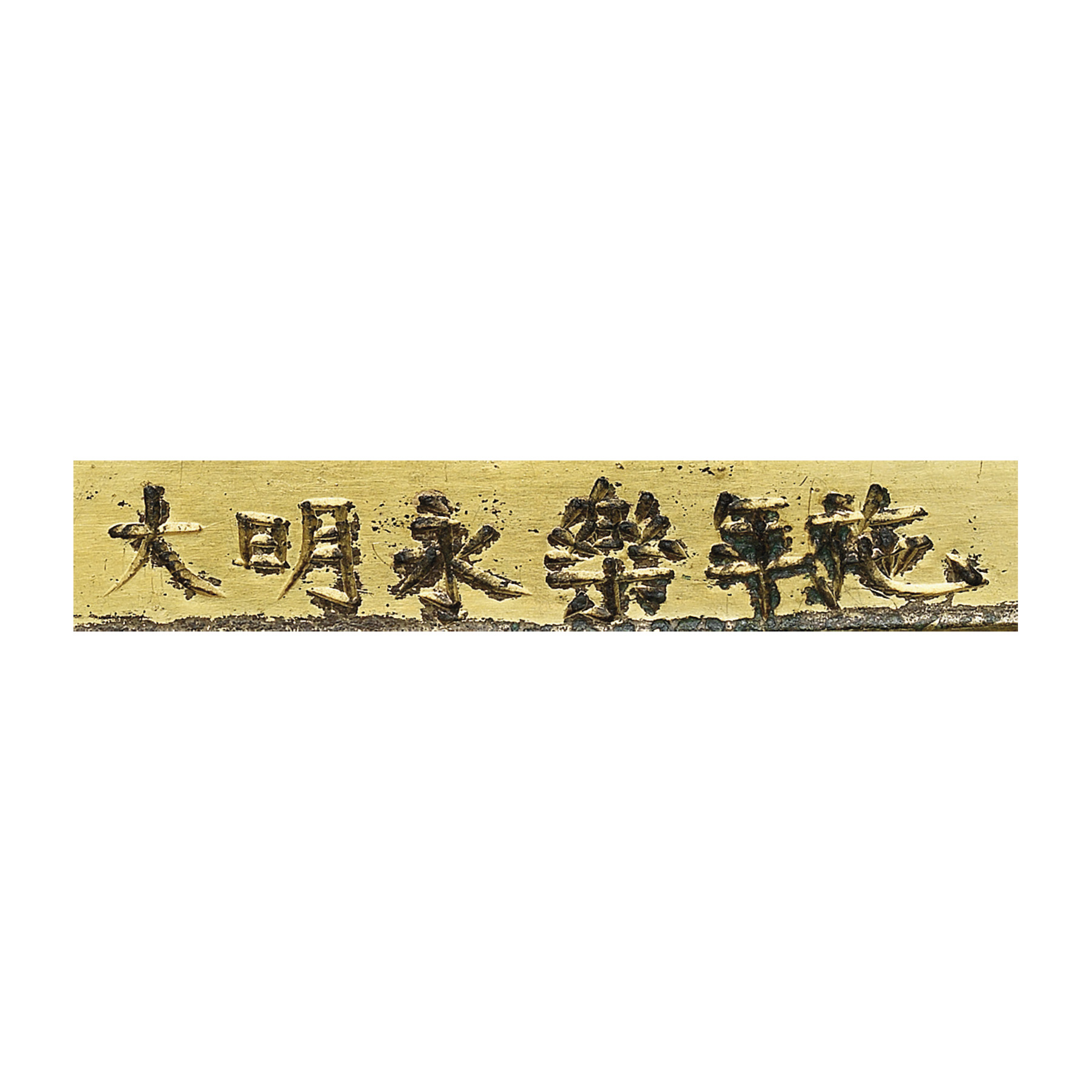
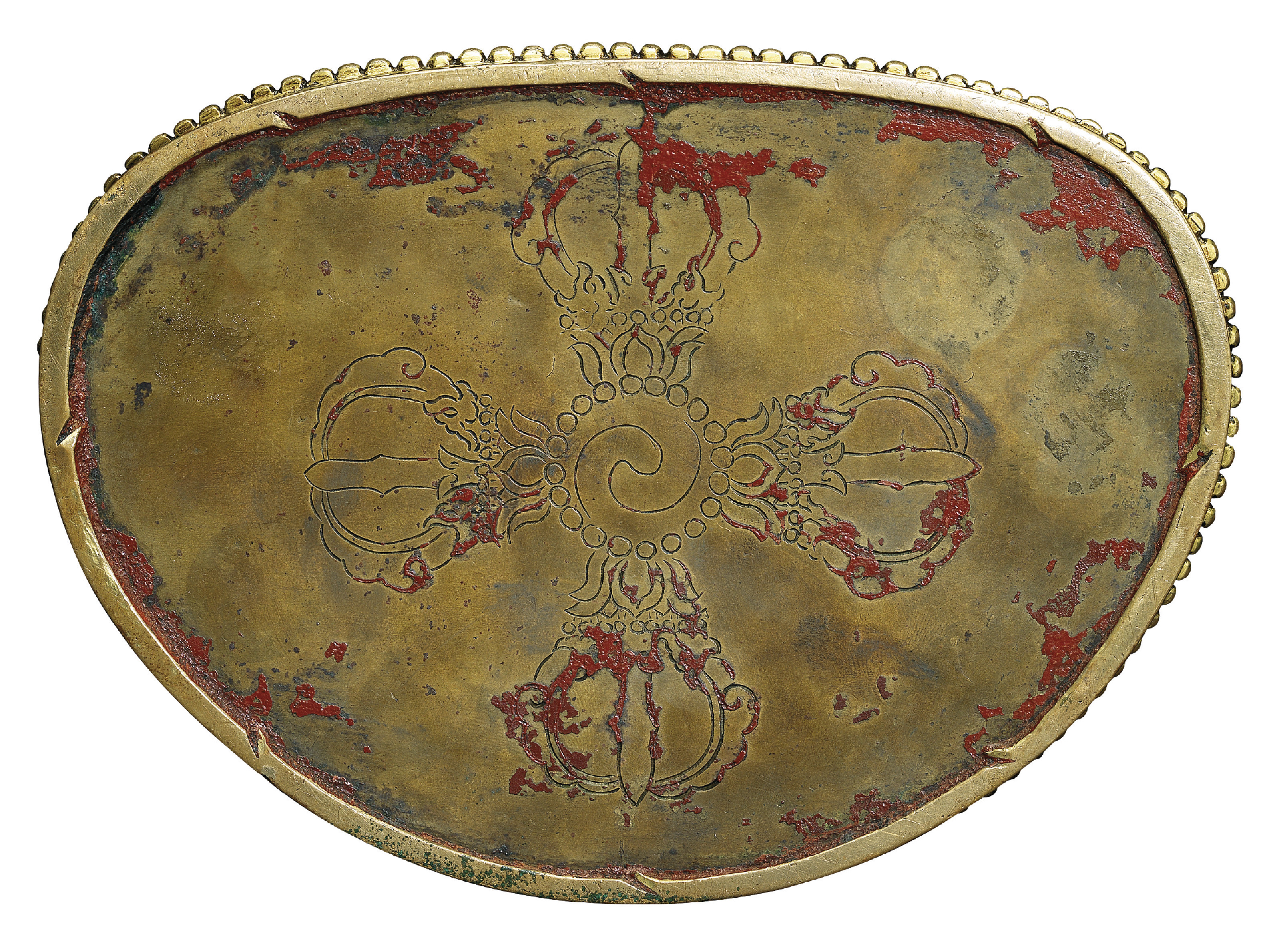
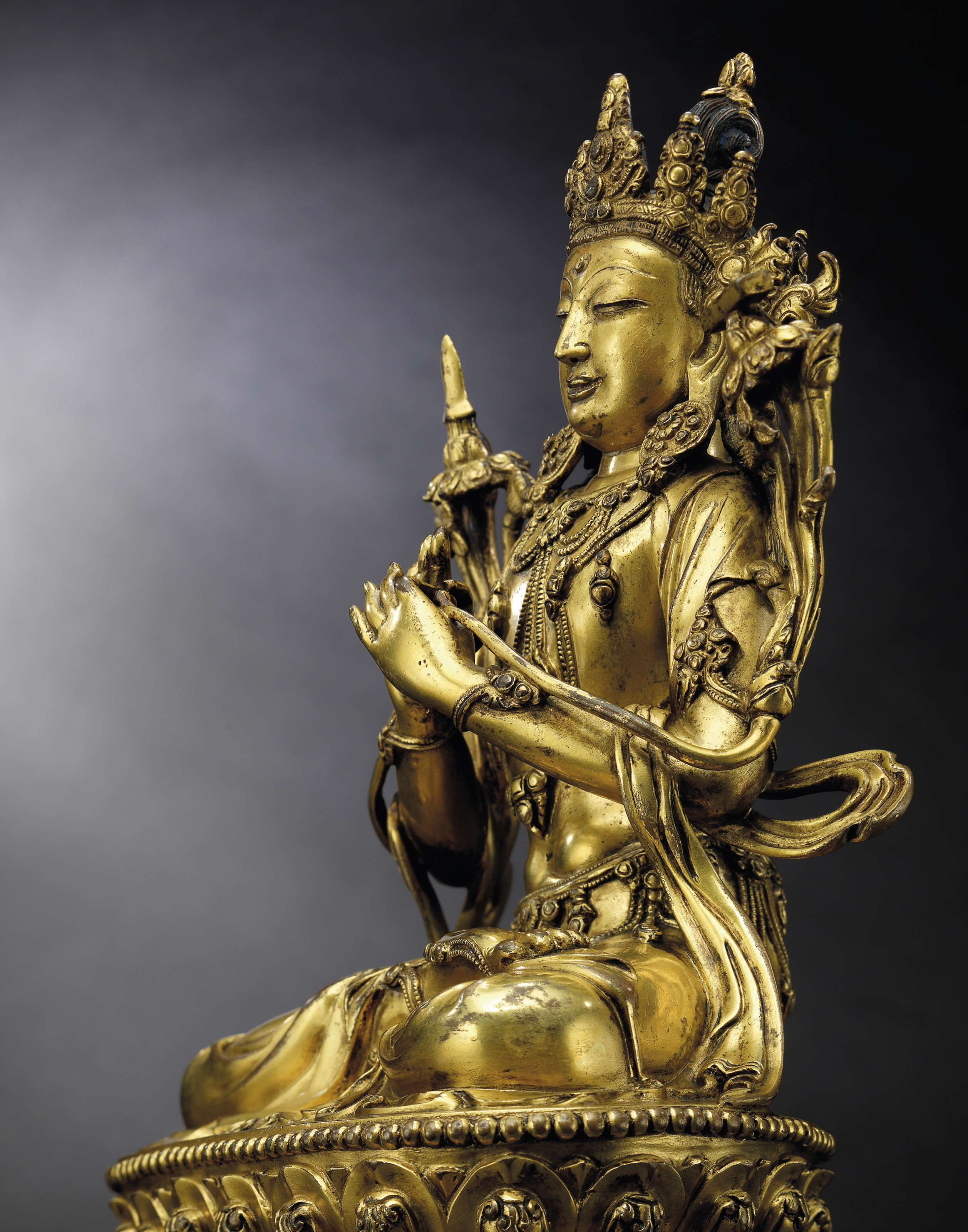
成交總額 HKD 18,040,000
估價 HKD 12,000,000 – HKD 15,000,000
AN EXTREMELY RARE GILT-BRONZE FIGURE OF MANJUSRI
YONGLE INCISED SIX-CHARACTER PRESENTATION MARK AND OF THE PERIOD (1402-1424)
The bodhisattva is finely cast seated in dhyanasana on a double lotus base, his hands in gesture of dharmachakra mudra holding the tips of lotus stems bearing his attributes a sword and a book, wearing a flowing dhoti gathered in folds around his knees and sash around the shoulders revealing the bare chest adorned with beaded pendent jewellery chains. The face is modelled to provide a benevolent expression with painted downcast eyes and smiling lips, his hair is worn in braids and curling topknot with loose strands falling over the shoulders. The front of the base is incised with a six-character presentation mark, Daming Yongle nian shi, ‘Bestowed in the Great Ming Yongle period’.
9 3/4 in. (24.9 cm.) high
拍品專文
This image is representative of a group of Buddhist figures made in China during the first half of the fifteenth century that displays a style influenced by the art of Tibet. In the preceding century under the Yuan Dynasty, the authority of Mongol rulers had become closely associated with Tibetan Buddhist or Lamaist rituals. The tradition of Lamaist art continued into the Ming period and prevailed in works of art such as the present example. Missions to Tibet were sent during the early part of the Ming dynasty and sought to maintain good relations with the Tibetan lamas, and images such as the present lot appear to have been made as gifts that were exchanged on such visits.
Compare with similar figures, the first from the Berti Aschmann collection, included in the Museum Rietberg exhibition, On the Path to Enlightenment, illustrated in the Catalogue, fig. 68; another figure in the Chang Foundation, is illustrated in Buddhist Images in Gilt Metal, Taiwan, 1993, no. 30; and the figure in the Potala Palace collection, Lhasa, illustrated in Buddhist Sculpture in Tibet, vol. II, Visual Dharma, Hong Kong, 2001, pl. 359B.
THE PROPERTY OF AN ASIAN COLLECTOR
参考:2018 — 纽约苏富比
明·朝曦
107 明永樂 銅鎏金文殊菩薩坐像 《大明永樂年施》款

107 明永樂 銅鎏金文殊菩薩坐像 《大明永樂年施》款

107 明永樂 銅鎏金文殊菩薩坐像 《大明永樂年施》款

107 明永樂 銅鎏金文殊菩薩坐像 《大明永樂年施》款

107 明永樂 銅鎏金文殊菩薩坐像 《大明永樂年施》款

107 明永樂 銅鎏金文殊菩薩坐像 《大明永樂年施》款
估價 400,000 — 600,000 美元
拍品已售 1,335,000 美元 成交價 (含買家佣金)
整體品相良好。鎏金保存極佳。見些許正常局部磨損及表面積污,如圖錄所見。原封底。蓮座邊沿等處見些許表面磨損及微小凹痕。
我們很高興為您提供上述拍品狀況報告。由於敝公司非專業修復人員,在此敦促您向其他專業修復人員索取諮詢,以獲得更詳盡、專業之報告。
來源
Doris Wiener Gallery,紐約,得於1965至1970年之間
美國私人收藏,此後家族傳承
相關資料
本尊文殊像,典雅別緻,尺寸精巧,鑄工精美,細緻入微,代表明初一類受藏風影響之御製佛像。Ulrich von Schroeder 曾記載四十五尊永樂年施造像收藏於西藏寺院,見《Indo-Tibetan Bronzes》,1981年,當中大部分現存布達拉宮(錄《Buddhist Sculptures in Tibet》,香港,2001年,卷2,頁1237-91)。永樂皇帝在位之時,朝廷對西藏政要及寺院恩遇有加,大賜國禮,使此類珍品傳入西藏並得以善存。本品底座蓮瓣細長挺拔,僅見於小尺寸永樂款造像,平均高度多約為18至22公分。
本文殊像上身微傾,寶飾流暢繁麗,飄然若動,意態瀟灑,反映明初宮廷審美品位。觀其細腰寬肩,明顯受印度風格尼泊爾工藝傳統影響,此風格在元朝時傳入中原,乃藏傳佛教藝術風格之濫觴;藏人傳統喜珠串寶飾,本像刻畫亦身飾珠鍊,華富繁縟。然藏佛造像多作嵌寶,而此類像則不加嵌飾,以應明廷審美;另見其鑄刻精細自然,起伏流暢,亦為中國佛像特色。
文殊菩薩,意譯妙德、妙首、妙吉祥,睿智靈善,常與普賢菩薩並列,或為釋迦如來兩大弟子,侍佛左右。文殊菩薩居五臺山,善說法要,開導眾生,據傳乃奉釋迦如來之命,廣授佛法,五臺山因而香火鼎盛。
本品文殊菩薩手結轉法輪印,此手印象徵佛陀初轉法輪,於鹿野苑開演正法,啟迪眾生,乃佛陀一生至關重要時刻。右手中、食、尾三指朝上,分別代表聲聞乘、緣覺乘與菩薩乘,左手伸展三指,象徵佛、法、僧三寶。雙手持蓮莖,兩肩旁各開蓮花一朵,蓮花上各置慧劍與般若經,兩者合一象徵去除痴愚妄念,把握真理,達至圓滿智慧。
比較一作例,尺寸與本品相近,端坐於蓮座,蓮瓣修長,慧劍與般若經缺失,售於倫敦蘇富比2014年11月5日,編號41。另有一近例,尺寸稍大,造型及法器與本品相似,底座蓮瓣較寬,展於《Lamaistic Art, Societe Generale de Banque》,布魯塞爾,編號19,售於倫敦佳士得1985年4月16日,編號300。香港佳士得2014年11月26日另售一例,編號3106。再比一例,直背造型,出自J.P.H.Y. 收藏,圖見 Ulrich von Schroeder,《Indo-Tibetan Bronzes》,香港,1981年,圖版144F。繼永樂之後,宣德一朝亦見相近作例,其中一件帶宣德年款造像曾展於《On The Path to Enlightenment》,Museum Rietberg,蘇黎世,1995年,編號68。
参考:北京德隆宝国际拍卖有限公司
2008秋季拍卖会2008-12-04
金铜佛像
0428 明永乐 铜鎏金文殊菩萨

拍品信息
尺寸 高19.5cm
估价 RMB 3,800,000-4,800,000
成交价 RMB 4,256,000 HKD 4,836,364USD 638,400EUR 468,160
说明 此尊文殊菩萨坐像头戴宝冠,冠叶正中有宝相花,下托弯月形装饰,头略向右侧内颔,眉间饰白毫,双唇微启,后有双层乌发,发髻以环环相扣还束缚。身佩璎珞、臂钏、手镯等饰物,身后镂空飘带,自然流畅。两手各持莲茎,当胸结说法印,莲花绕臂而出,齐肩绽放,分别奉置经书、宝剑,象征菩萨的智慧似利剑,般若智慧浩瀚如经卷,做工精细,造型完美,是不可多得的佳作。
参考: 中贸圣佳国际拍卖有限公司
2007-08-20 2007春季艺术品拍卖会
古董珍玩专场
1943 明永乐 铜鎏金文殊菩萨像

文殊是梵语“文殊师利”的简称,意译“妙德”或“妙吉祥”。 是集诸佛智慧为一身一位大菩萨。在藏传佛教中,文殊菩萨具有十分普遍的信仰,因为藏传佛教修行强调智能的功用,所以作为智能化身的文殊菩萨特别受到崇拜。其形象有多种,常见为一面二臂形象,经书和宝剑是其形象重要标识。此像菩萨装束,头戴花冠,身披帔帛,下着长裙,全身璎珞、珠宝严饰。肩花上的经与剑标示了菩萨的身份。其华丽精巧的装饰、优美动人的体态、流畅软柔的衣纹、绚丽沉稳的金色外表,显示了无与伦比的成熟之美。尤为值得注意的是,此像保留了原有的封藏,封底可见封得十分严实的封底盖,封底盖上刻有精美的十字金刚杵图案,其周边可见均匀分布的剁刺和封护用的朱砂。
拍品信息
估价8,500,000至12,000,000
成交价9,520,000
规格高26cm
参考:苏富比
20 三月 2018 • 紐約
拍賣編號: N09837
107 明永樂 銅鎏金文殊菩薩坐像 《大明永樂年施》款
MING: LUMINOUS DAWN OF EMPIRE
107 PROPERTY FROM A WASHINGTON PRIVATE COLLECTION
AN EXCEPTIONAL GILT-BRONZE FIGURE OF MANJUSHRI
YONGLE MARK AND PERIOD

YONGLE MARK AND PERIOD

YONGLE MARK AND PERIOD

YONGLE MARK AND PERIOD

YONGLE MARK AND PERIOD

YONGLE MARK AND PERIOD
Estimate 400,000 — 600,000 USD
LOT SOLD. 1,335,000 USD
估價 400,000 – 600,000 USD
已售出 1,335,000 USD
描述
《大明永樂年施》款
Bronze
Height 7 1/4 in., 18.4 cm
來源
Doris Wiener Gallery,紐約,得於1965至1970年之間
美國私人收藏,此後家族傳承
拍品資料及來源
本尊文殊像,典雅別緻,尺寸精巧,鑄工精美,細緻入微,代表明初一類受藏風影響之御製佛像。Ulrich von Schroeder 曾記載四十五尊永樂年施造像收藏於西藏寺院,見《Indo-Tibetan Bronzes》,1981年,當中大部分現存布達拉宮(錄《Buddhist Sculptures in Tibet》,香港,2001年,卷2,頁1237-91)。永樂皇帝在位之時,朝廷對西藏政要及寺院恩遇有加,大賜國禮,使此類珍品傳入西藏並得以善存。本品底座蓮瓣細長挺拔,僅見於小尺寸永樂款造像,平均高度多約為18至22公分。
本文殊像上身微傾,寶飾流暢繁麗,飄然若動,意態瀟灑,反映明初宮廷審美品位。觀其細腰寬肩,明顯受印度風格尼泊爾工藝傳統影響,此風格在元朝時傳入中原,乃藏傳佛教藝術風格之濫觴;藏人傳統喜珠串寶飾,本像刻畫亦身飾珠鍊,華富繁縟。然藏佛造像多作嵌寶,而此類像則不加嵌飾,以應明廷審美;另見其鑄刻精細自然,起伏流暢,亦為中國佛像特色。
文殊菩薩,意譯妙德、妙首、妙吉祥,睿智靈善,常與普賢菩薩並列,或為釋迦如來兩大弟子,侍佛左右。文殊菩薩居五臺山,善說法要,開導眾生,據傳乃奉釋迦如來之命,廣授佛法,五臺山因而香火鼎盛。
本品文殊菩薩手結轉法輪印,此手印象徵佛陀初轉法輪,於鹿野苑開演正法,啟迪眾生,乃佛陀一生至關重要時刻。右手中、食、尾三指朝上,分別代表聲聞乘、緣覺乘與菩薩乘,左手伸展三指,象徵佛、法、僧三寶。雙手持蓮莖,兩肩旁各開蓮花一朵,蓮花上各置慧劍與般若經,兩者合一象徵去除痴愚妄念,把握真理,達至圓滿智慧。
比較一作例,尺寸與本品相近,端坐於蓮座,蓮瓣修長,慧劍與般若經缺失,售於倫敦蘇富比2014年11月5日,編號41。另有一近例,尺寸稍大,造型及法器與本品相似,底座蓮瓣較寬,展於《Lamaistic Art, Societe Generale de Banque》,布魯塞爾,編號19,售於倫敦佳士得1985年4月16日,編號300。香港佳士得2014年11月26日另售一例,編號3106。再比一例,直背造型,出自J.P.H.Y. 收藏,圖見 Ulrich von Schroeder,《Indo-Tibetan Bronzes》,香港,1981年,圖版144F。繼永樂之後,宣德一朝亦見相近作例,其中一件帶宣德年款造像曾展於《On The Path to Enlightenment》,Museum Rietberg,蘇黎世,1995年,編號68。
DETAILS & CATALOGUING
AN EXCEPTIONAL GILT-BRONZE FIGURE OF MANJUSHRI
YONGLE MARK AND PERIOD
superbly cast in rounded fleshly volume, the bodhisattva seated in dhyanasana on a double-lotus pedestal, the arms raised in dharmachakra mudra to the chest, holding two stalks of uptala lotuses rising up the shoulders and supporting a khadga and pustaka, the gracefully swaying figure wearing a dhoti falling into elegant pleats, draped with a celestial sash around the shoulders and arms, the chest and the waist adorned by elaborate beaded necklaces, the face set with a serene and benevolent expression, with wheel-shaped earrings attached to the pendulous earlobes, surmounted by a five-leaf diadem around a high chignon, the lotus base incised with a reign mark reading Da Ming Yongle nian shi, the sealed base engraved with a double vajra
Height 7 1/4 in., 18.4 cm
PROVENANCE
Doris Wiener Gallery, New York, acquired between 1965 -1970.
American Private Collection, and thence by descent.
CATALOGUE NOTE
This outstanding figure of the bodhisattva Manjushri, the ‘Beautiful and Virtuous Lord’, represents a group of Buddhist figures made on the orders of the Imperial Court in China during the first half of the 15th century that displayed a style influenced by the art of Tibet. According to Ulrich von Schroeder in Indo-Tibetan Bronzes, Hong Kong, 1981, fifty-four Da Ming Yongle nian zhi works have been documented in Tibetan monastery collections, most of which are held in Potala Palace, Tibet (see Ulrich von Schroeder, Buddhist Sculptures in Tibet, Hong Kong, 2001, vol. II, pp 1237-91). These works have survived in Tibet due to imperial patronage lavished on Tibetan hierarchs and monasteries during the reign of the Yongle Emperor. The slim elongated lotus petals on the base of this piece are only seen on smaller Yongle works which average eighteen to twenty-two centimeters in height. Thus this group of figures are characterized by their delicate appearance, emphasized by the intimate size and exquisitely finished details.
Particularly fine for the gentle sway of the torso, which compliments the curves of the adornments to create a sense of movement, this figure reflects the Chinese taste of the early-Ming court. The well-defined waist and broad shoulders exemplify Indo-Nepalese traditions that were introduced into China during the Yuan dynasty and served as the foundation of the Sino-Tibetan style. Additionally, the craftsman has expertly fused the Tibetan love of ornamentation, seen in the luxurious jewelery, with the delicacy of detail, masterful casting, and the naturalism in style of China. Notably, while Tibetan figures were often embellished with inlaid semi-precious stones, these have been omitted in accordance with the aesthetic of the early Ming court.
Manjushri is the bodhisattva associated with the wisdom of Buddha and is commonly paired with Samantabhadra, the Bodhisattva of Compassion. The two bodhisattvas are important acolytes of Shakyamuni and are believed to have been historical figures, possibly disciples of the Buddha. Manjushri resides in the Five Peak Mountain, Wutaishan, and is on earth to save people from ignorance. It is believed that Manjushri was instructed by Shakyamuni to transmit his teachings and his residence, Wutaishan, became one of the major centers of pilgrimage for his followers.
The figure’s carefully rendered hands are held in dharmachakra mudra, the ‘Wheel of Dharma’. This mudra symbolizes one of the most important moments in the life of the Buddha: the occasion when he preached to his companions the first sermon after his Enlightenment in the Deer Park at Sarnath. The three extended fingers of the right hand represent the three vehicles of the Buddha’s teachings, namely the ‘hearers’ of the teachings through the middle finger; the ‘solitary realizers’ through the fourth finger, and the Mahayana, or ‘Great Vehicle’ through the little finger. The three extended fingers of the left hand symbolize the Three Jewels of Buddhism: the Buddha, the Dharma, and the Sangha. Stalks of lotus flowers emanate from his hands, from which rest the symbols of Manjushri, the sword (khadga), which has been heavily stylized and abbreviated, and the book (the Prajnaparamita). Together they symbolize the highest knowledge that is reached by overcoming ignorance and studying the highest book of wisdom.
A related figure of Manjushri of similar size and seated on a base with elongated lotus petals, but lacking the attributes, was sold in our London rooms, 5th November 2014, lot 41. Compare a larger figure of closely related form and attributes, but rendered with broader lotus petals on the base, included in the exhibition Lamaistic Art, Société Generale de Banque, Brussels, cat. no. 19, sold at Christie’s London, 16th April 1985, lot 300; and another sold at Christie’s Hong Kong, 26th November 2014, lot 3106. A related figure, but cast without the gentle sway in the back, from the J.P.H.Y. collection, is illustrated in Ulrich von Schroeder, Indo-Tibetan Bronzes, Hong Kong, 1981, pl. 144F. Figures of this type were also created in the succeeding Xuande reign; see one, with a Xuande mark and of the period, included in the exhibition On The Path to Enlightenment, Museum Rietberg, Zurich, 1995, cat. no. 68.
READ CONDITION REPORT
In excellent general condition. The brilliant gilding is preserved extremely well with some characteristic minor localized wear and surface accretions, as visible in the catalogue images. The consecration plate to the base is intact. Surface wear and minute dents along the edges of the lotus base.
“In response to your inquiry, we are pleased to provide you with a general report of the condition of the property described above. Since we are not professional conservators or restorers, we urge you to consult with a restorer or conservator of your choice who will be better able to provide a detailed, professional report. Prospective buyers should inspect each lot to satisfy themselves as to condition and must understand that any statement made by Sotheby’s is merely a subjective, qualified opinion. Prospective buyers should also refer to any Important Notices regarding this sale, which are printed in the Sale Catalogue.
NOTWITHSTANDING THIS REPORT OR ANY DISCUSSIONS CONCERNING A LOT, ALL LOTS ARE OFFERED AND SOLD AS IS” IN ACCORDANCE WITH THE CONDITIONS OF BUSINESS PRINTED IN THE SALE CATALOGUE.”
Large statue of Vairocana gilt bronze Ming Dynasty, XV E century
A RARE AND IMPORTANT LARGE GILT-BRONZE FIGURE OF VAIROCANA, MING DYNASTY, 15TH CENTURY

A RARE AND IMPORTANT LARGE GILT-BRONZE FIGURE OF VAIROCANA, MING DYNASTY, 15TH CENTURY

A RARE AND IMPORTANT LARGE GILT-BRONZE FIGURE OF VAIROCANA, MING DYNASTY, 15TH CENTURY

A RARE AND IMPORTANT LARGE GILT-BRONZE FIGURE OF VAIROCANA, MING DYNASTY, 15TH CENTURY

A RARE AND IMPORTANT LARGE GILT-BRONZE FIGURE OF VAIROCANA, MING DYNASTY, 15TH CENTURY
ARTS OF ASIA 39 GERMAN SPECIAL COLLECTION
estimate 300,000 — 500,000 EUR
Lot Sold 3,395,000 EUR (Hammer price with buyer’s commission)
Large statue of Vairocana gilt bronze Ming Dynasty, XV E century
A RARE AND IMPORTANT LARGE GILT-BRONZE FIGURE OF VAIROCANA, MING DYNASTY, 15TH CENTURY
seated in vajrasana on a double lotiforme base, her hands clasped in front of her chest in abhisekana mudra , dressed in a fine dhoti with harmonious folds forming a fan between her legs and leaving the right shoulder uncovered, serene face with lowered eyelids framed ‘impressive earrings hanging from its long lobes, the forehead embellished with the urna girded with a rich crown with five pointed ends holding a ribbon tied behind his head, surrounding his top bun surmounted by the ushnisha , unsealed
51.3 cm; 20 1/8 in.
READ STATE
REPORT SALEROOM NOTICE
PROVENANCE
Swiss Collection (by repute).
Koller Zuerich, 11th November 1988, lot 1A.
CATALOG
This rare and imposing gilt bronze figure depicts the supreme Buddha Vairocana embodying the seminal Indian Vajrayana Buddhist text ‘Mahavairocana Abhisambhodi Tantra’. The sutra, possibly composed in the great university of Nalanda in the province of Bihar, was transmitted to China in the eighth century by the Indian monk Subhakarasimha. The Adi Buddha is adorned with regal crown and earrings befitting his stature as a primordial enlightened being, but wears the simple robes of a monk denoting humility and compassion. The hands, locked together in a bodhyagri mudra, express the concept of ultimate reality and wisdom. The face is a study of composure and intensity, imbuing the statue with a commanding presence. Indeed the deeply cut narrowed eyes, full mouth and broad features indicate the early Ming dynasty provenance of the bronze comparable to numerous mid-fifteenth century Chinese Buddhist sculptures, most notably a crowned Buddha of similar size in the Newark Museum, published in Marylin M. Rhie and Robert A. F. Thurman, The Sacred Art of Tibet, London, 1991, p. 356, cat. no. 146.
The crown is of typical fifteenth century design with the patterned fillet decorated with a triple jewel setting at the centre in the classic early Ming format of square-cut gem flanked by two pear-cut, and with the five leaf jewelled diadem following the design seen on Yongle and Xuande examples, cf. the crowns of the Speelman pair of Xuande dancing bodhisattvas, sold Sotheby’s Hong Kong, 7th October 2006, lot 805. The fall of cloth is well observed in the Buddha’s robe, taught over the knees and shoulder but hanging in loose folds across the chest, lower leg and ankle, and spreading out over the upper surface of the pedestal, as in many works of the period. But the singular defining feature that places the sculpture firmly in the fifteenth century, and relating the robe to the Yongle period origins of the style, is the way the cloth forms a broad flattened fold falling from the proper left shoulder. This distinctive feature is common on early Ming works such as the Speelman Yongle enthroned Buddha, ibid., lot 808, but does not occur later in the dynasty.
The imperial bronzes of the Yongle and Xuande period thus clearly influenced the artist who created this large and important sculpture, and continued to impact on sculpture of the Zhengtong (1436-1449) and Jingtai (1450-1457) periods. However, Chenghua (1464-1487) Buddhist sculpture tends to be mannered in comparison. Given the evident confidence of the sculptor of this crowned Vairocana Buddha, and his inherent knowledge of the classic early Ming motifs and sculptural proportion, it may be assumed that it dates to no later than the mid-fifteenth century. The well-documented bestowal of gilt bronzes upon Tibetan hierarchs during the Yongle reign was significantly reduced during the Xuande period and hardly recorded thereafter. This majestic image of Vairocana is thus likely to have been a commission for a local Chinese temple setting during the Zhengtong or Jingtai period, rather than destined for a Tibetan monastery collection.
参考:保利香港拍卖有限公司
保利香港2013年秋季拍卖会 2013-10-07
中国古董珍玩
1393 明中期 铜鎏金金刚持

拍品信息
尺寸 高23cm
估价 HKD 400,000-600,000
成交价 RMB 635,145 HKD 805,000USD 103,040EUR 80,500
说明
金刚持,是释迦牟尼佛演说密法时化现的形象,是藏密诸派共同修持的本尊。此件造像双手各持金刚铃和金刚杵,在胸前结哞迦罗印,分别表示智慧与方便,象征悲智双运。金刚持头带宝冠,束发高髻,余发披肩,髻顶饰半杵,耳饰叶圆铛。面庞丰润,白毫凸显,眼睑低垂,相容沉静。上身袒露,胸前饰璎珞,下身着长裙,衣薄贴身,长裙之上錾刻精美的花纹,刀锋毕现,无丝毫托泥带水,十分华丽,可见铸匠师功力之深。造像身体重心微微左倾,坐于双层束腰仰覆莲座之上,上下缘各饰一周连珠纹,最为完美之处是此尊造像仍然保存着原封底,十分珍贵。
整尊造像鎏金饱满,金色锃亮,比例精准,上身肌肉感表现到位,体现了藏族匠师的审美情趣和高超技艺,具有典型的15世纪西藏中部地区造像特点。
参考:香港翰海拍卖有限公司
2015首届拍卖会2015-10-04
我佛慈悲
0058 15世纪 文殊菩萨

尺寸高38.5cm
估价HKD 5,000,000-6,000,000
成交价 未提供
说明
西藏 红铜鎏金,嵌松石
此作品为文殊菩萨说法相之鎏金造像。文殊菩萨,梵语“曼珠师利”(Manjushiri),故又音译文殊师利菩萨,为佛教八大佛子(俗称:八大菩萨)之一。其藏语称作“蒋贝扬”(འཇམ་དཔལ་དབྱངས། vjam dpal dbyangs),以菩萨之功德具足广大无尽智慧,故受称大智文殊师利菩萨。
关于文殊菩萨的智慧功德,考藏文《文殊礼赞文》1的殊胜缘起,则略知其不可思议:往昔古印度的那烂陀寺2驻有五百位大班智达(梵语pantita,古印度大学者之称号),当时方丈名为 吉祥本智功德贤(དཔལ་ཡི་ཤེས་ཡོན་ཏན་བཟང་པོ།(dpal yi shes yon tan bzang po),于大殿落成启用前夕,住持方丈令寺中五百大班智达各造颂偈一首,于次日晨间发表后选拔其中最优异者,做为新建大殿之启用颂文。诸大班智达皆愿一展长才,当夜各自回到僧寮后,无不闭门竭力创作,故彻夜推敲思索,斟酌再三,虔敬造颂。隔日清晨于大殿前集会,方丈令诸大班智达揭晓各自作品,但当五百位大班智达同时展示其各自戮力创作之颂文时,竟然无独有偶,全然相同,且字句分毫不差!五百作品内容皆为赞颂文殊菩萨智慧之颂偈;共计八句,一百二十四字3。当时与会大众皆惊叹此瑞兆必为文殊菩萨所赐降之大加持力所致,故全寺皆遵奉此颂偈做为新落成大殿之启用吉祥偈,并将住持方丈之法名做为此文殊菩萨赞颂文之篇名,此即《至尊妙吉祥赞颂文˙吉祥本智功德贤》赞偈之殊胜缘起。由于礼赞文的开头以藏文“冈记洛卓…”(གང་གི་བློ་གྲོས་་་། gang gi blo kros…,意即:何等智慧…)四字稽首,故得名为“冈洛玛”(གང་བློ་མ། gang blo ma)。后世藏传佛教各大宗派之僧俗弟子每于晨间皆广为颂读此著名颂偈,以祈开启广大无边之真实智慧。
文殊菩萨之形象,多为菩萨身着“报身庄严”相,一般多显现寂静相。寂静相之文殊菩萨有立姿、坐姿,或举剑、持手帜物等多样身姿;较常见者为一面二臂,右手高举利剑挥悬之坐姿相,为其基本形象。此作品为文殊菩萨特别呈现“说法相”之坐姿造像,由于上述扬举利剑之基本形象于视觉上为不对称之造型,故相对来说左右对称的文殊菩萨说法相身姿则较为对称稳重。佛教诸多造像的形相,因宗教供奉的需求而有所谓主尊、眷属的分别。主尊一般受供奉于殿堂佛龛正中央,眷属则陪奉列位于主尊的旁侧,例如西方三圣、华严三圣4等主眷之配置法则,故其等比例、造型、身姿等,即因应供奉的位置而有所差别。从简单的视觉欣赏角度来说,文殊菩萨说法相的形象比例较显左右对称,故于藏传佛教诸多寺院大殿或佛学院主殿正中央,多供奉有此型制文殊菩萨说法相之庄严造像。例如西藏萨迦县萨迦大寺普贝拉康文殊殿、青海西宁塔尔寺文殊菩萨殿、印度比尔宗萨佛学院大殿藏经阁等主供佛。
传统藏传佛教所有造像及绘画艺术异于中外其他艺术作品之处,在于其创作目的乃为宗教服务,并非艺术家个人可尽情挥洒、天马行空的艺术创作,故必须完全依据经文所述,制作严谨,合乎规章,且不容丝毫错谬或逾越。依佛制,文殊菩萨说法相,为双手结作说法手印,并持有慧剑及经函等手帜物。智慧剑为二刃型制,表断除人、法二种执着,体现“人无我、法无我”之二种无我,功能为斩除无明烦恼之乱结;横条贝叶经形式的经函则代表一切般若经典。此经典之型制,依据《造像量度经续补》记载有梵夹、收卷等二种,于印、藏、汉地等造像中皆可见此二种型制之经典造型;此作品所呈现为梵夹形式之经函。而经函的内容为何?佛陀 释迦牟尼所宣说的八万四千法门中,关于般若空性的大乘经典《般若经》(Prajñāpāramitā Sūtra)概分广、中、略(亦称大中小)等三种规模:广品般若经有十万颂(每颂四句),称作《大品般若经》;中品般若经为二万五千颂,称作《中品般若经》;略品般若经有八千颂,称作《小品般若经》。此外另有浓缩集摄般若经的《般若摄颂》;以及集摄一切般若精粹心髓的《般若心经》。此处应注意心经的“心”,实指精华、心髓、精要、精藏之意,汉译简称“心”,并非仅指狭隘的心脏或心理;请参阅笔者拙著《藏历与藏密修持》5。般若经的精髓实为助以解脱轮回的般若空性,若将此《心经》擅自片面臆测为仅平复个人心理的经文,则不仅以管窥豹,更偏离错解并矮化了般若经中智慧与空性双运的广大要旨。
藏传佛教造像的一切元素乃源自于经典记载,若能熟识此本源,则所有对藏传造像之诸多疑问与错误臆测皆能迎刃而解。于造像量度之比例上,此作品面容属“菩萨鸡子面”,意即菩萨类的造像面容约近鸡蛋脸形。由于文殊菩萨为八地以上之大菩萨,依其功徳显现佛三身(法身、报身、化身)之报身相,故身着报身六庄严,即报身佛所享配穿戴的六种庄严宝饰。六庄严有寂静、忿怒二种形式:寂静尊六庄严的材质为黄金缀饰各色珠宝的珍宝装饰;忿怒尊六庄严的材质为各种牙骨串联而成的骨质装饰。故于此寂静相文殊菩萨造像周身所穿戴各种宝饰的意义上,依据《造像量度经解》记载以“八件宝饰”为庄严:「何者为八件?一、宝冠,即五佛冠也。二、耳环。三、项圈。四、大璎珞。五、手钏及手镯。六、脚镯。七、珍珠络腋。八、宝带也。谓之大饰。耳垂上前临优波罗华,冠左右下垂宝带,脚镯上围绕碎铃、戒指等。谓之小饰。随宜妙缯。…」此处计为八饰,与六饰之主张相较,仅界定上不同,数量上实则无异。藏传佛教各宗派对寂静尊所穿戴六庄严之定义亦稍有不同,例如萨迦派主张寂静尊六庄严为:顶饰、耳饰、项饰、身饰、腰饰、手足饰。六庄严各与六度(ṣaḍ-pāramitā,又译:六波罗蜜多)相合,有多种说法,例如:
顶饰为配戴于额顶的天冠,象征布施波罗蜜(dāna-pāramitā);
耳饰为配戴于双耳的耳珰,象征持戒波罗蜜(śīla-pāramitā);
项饰为配戴于颈项的项链,象征安忍波罗蜜(kṣānti-pāramitā);
身饰为配戴于前胸的身炼或梵线,象征精进波罗蜜(vīrya-pāramitā);
腰饰为配戴于腰际的腰带,象征禅定波罗蜜(dhyāna-pāramitā);
手足饰为配戴于双手大臂上的手钏、双手腕上的手镯,以及双足踝的脚镯,象征般若波罗蜜(rajñā-pāramitā)。
以上六饰如同前述经文所说,统称做“大饰”。另外如同经文中所述,于双耳耳际上方(顶戴天冠的两侧最末端)各缀饰有一朵优波罗华,即乌巴拉花。天冠的左右末端下垂有宝带,见造像双耳后方随风飘起之绸带状物。加上双足踝脚镯上的碎铃,以及手指上穿戴的戒指,统称做“小饰”。此造像特别于双手的臂钏、腕镯以及腰带等庄严,精铸以双圈结构,再于平滑的双圈之间加镶有银质之连珠,呈现出简繁二式与金银两色的形色对比美感。
于艺术造型上,此造像顺势蜿蜒在左右肩侧而盛开于双耳际的配饰乌巴拉花6,其构造不仅具备由下而上渐粗之主花茎,更具有极富立体结构的伞状花瓣,呈现向正前方前倾之繁花复叶样式,不仅依据经典所载考据详实,更承袭了早期佛教造像的遗风。此种繁复之手持带枝花朵样式最早可溯及公元九至十世纪的喀什米尔造像,例如美国洛克菲勒三世(Rockefeller III)收藏的立姿莲花手观音黄铜造像(高68厘米);至公元十二世纪东北印度帕拉王朝一系精致菩萨造像蜿蜒繁复的肩花,始大放异彩,例如美国洛杉矶郡艺术博物馆(Los Angeles County Museum of Art)珍藏的立姿文殊菩萨青铜造像(高25.1厘米)。到了公元十四世纪左右的西藏造像,更有从较平板样式的花叶演变成近似伞状的三维立体肩花样式,例如英国伦敦维多利亚与阿尔伯特博物馆(Victoria and Albert Museum,简称:V&A)所藏的四臂文殊鎏金造像(高16.6厘米);至十五世纪西藏的前后藏地区造像,更显精致,造工细腻而讲究,例如北京故宫博物院珍藏的白度母红铜造像(高46.5厘米),此等精致工艺的肩花样式深深影响了十六至十八世纪前后藏地区造像及汉地明清时代的宫廷造像。
此十五世纪文殊菩萨鎏金造像,风格及制作工艺与尼泊尔十四世纪造像艺术一脉相承,特别于周身穿戴庄严宝饰之刻画样式、身着天衣下裙之修饰,以及金属表面之鎏金与錾刻刀工等特征,体现出十五世纪西藏的后藏地区造像之艺术风格。蜿蜒于造像左右大臂旁侧的配饰花朵,依据密续记载为乌巴拉花,花型造以微前倾的伞型,花瓣狭窄而细长,左右花朵上各承托有文殊菩萨的标准手帜。花茎枝叶交缠繁复,以生硬之金属犹能表现出纤柔的繁茂花叶,至为难得。于造像身姿方面,承袭了早期印度造像以来菩萨身相所具备的传统“三折枝”造型,由上而下,第一道虚拟直线自头顶正中经眉心、鼻梁至双乳中间的心口;第二道直线自心口向下延伸直至肚脐;第三道线自脐部向正下方直落,是以构成了身姿优雅,饶富动态美感的菩萨三折枝身姿。作品除制作工艺精绝、如法考究详实之外,保存完好,无甚缺损,堪称传世万代之绝佳珍品。
文殊菩萨赞颂文
《至尊妙吉祥赞颂文·吉祥本智功德贤》
顶礼出有坏妙吉祥!
何等智慧清净如日极明离系二障云,
观照察鉴尽所有诸义故心间持经函,
针对诸凡轮回牢狱般无明昏暗苦厄,
六十支分具音律语悲悯如独子众生,
如雷大鸣惊醒烦恼眠般而释放桎梏,
持剑以断一切尽所有无明暗苦厄芽,
本原而为究竟十地圆满功德之佛长子身,
整壹佰壹拾贰严饰我心明灯文殊敬顶礼!
吉祥贤居士译
撰文 叶灵毅居士
来源:台湾乐从堂
注释:
1《文殊礼赞文》:藏文全称 འཇམ་དཔལ་དབྱངས་ཀྱི་བསྟོད་པ་དཔལ་ཡི་ཤེས་ཡོན་ཏན་བཟང་པོ་ཞེས་བྱ་བ།(rje btsun vjam dpal dbyangs kyi bstod pa dpal yi shes yon tan bzang po zhes bya wa |),汉译为:《至尊妙吉祥赞颂文˙吉祥本智功德贤》。
2那烂陀寺:梵语Nālandā,位于古印度摩揭陀国的国都王舍城附近,地处今印度比哈尔邦中部都会巴特那东南方约90公里。
3共计八句,一百二十四字:前六句每句十五字,共九十字;后二句每句十七字,共三十四字。全文共计八句一百二十四字。
4西方三圣、华严三圣:西方三圣,依据《观无量寿佛经》等净土经典记载,中央为西方极乐世界教主阿弥陀佛,右胁侍为大勇大势至菩萨(Mahāsthāmaprāpta),左胁侍为大悲观世音菩萨(Avalokiteśvara)。华严三圣,依据《华严经》所载,中央为法身毗卢遮那佛(又称大日如来,即化身佛释迦牟尼佛显现法身之相),右胁侍为大智文殊师利菩萨,左胁侍为大行普贤菩萨(Samantabhadra)。
5《藏历与藏密修持》:吉祥贤著,台北 喜旋文化出版工作室,2012年5月再版。第七章,第三节,第285页。
6乌巴拉花:乌巴拉为梵语,依据《造像量度经续补》所述亦写作“优波罗”花,一种花瓣较莲瓣更加尖而细长的殊胜花朵。

![[临渊阁]天地一家春](https://www.antiquekeeper.ca/wp-content/uploads/2023/03/cropped-Asian-Art-Wallpaper-Painting3-6-2.jpg)
